1926-1930 Surrealism Paris Years- Gallery
Magritte Gallery for the Surrealism-Paris Years 1926-1930
From 1926 to 1930 Rene Magritte was very productive, sometimes painting three canvases a week. He had just become under contract with Paul-Gustave Van Hecke who controlled "the majority of his output" in exchange for a monthly stipend. Not only did he start producing surrealist paintings and developing his mature style but he experimented with painting words on canvases. By the time he'd moved to Paris in 1927 Magritte painted a crude image of a pipe and labeled the painting La Pipe. The same year, 1927, Magritte published an essay entitled "Les Mots et Les Image" in which he points out by means of little sketches a number of relations between words and paintings. As a result, in his 1927 painting The Interpretation of Dreams Magritte began placing words in his paintings. This marks a period of about four years where he would produce over 40 paintings that used written words to provoke thought about the meaning of images and words.
For Magritte this established one of his fundamental concepts: representation, that art is a representation of an image but not the image itself. Thus on the canvas his famous 1929 painting of a pipe he writes (Ceci N'est Pas Une Pipe) "This is not pipe" meaning that in fact it's just a painting of a pipe. That painting is a representation of an image but never the real image. By the summer 1928 he was accepted by Andre Breton, the author of the Surrealist Manifesto, into the Paris group. Magritte contributed an article about words and images to Breton's 1929 La Revolution Surrealiste and his painting, The Hidden Woman, adorned the cover.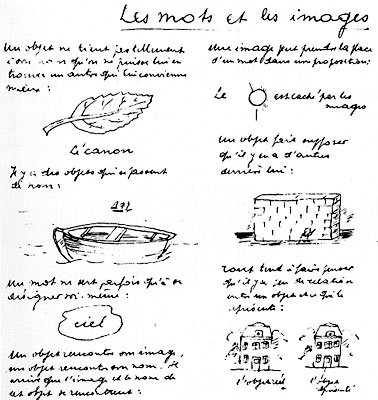
Les Mots et les Images 1928, published in La Révolution surréaliste 1929
In 1929, in La Révolution surréaliste, Rene Magritte published "Les Mots et les Images," accompanied by a number of funny little drawings. In this text Magritte declared, among other things, that "an object does not care so much for its name that another name could not be found that would be more convenient" (a notion that seems to have influenced Jasper Johns), that "a word is sometimes used only to designate itself," and that "sometimes the name of an object takes the place of an image."
While in Paris Magritte was still in touch with the Belgian surrealists who were unified behind Paul Nouge in 1925. His friend ELT Mesens was the director of Van Hecke's "Galerie L'Epoque" and Magritte attended several exhibits of his paintings in Brussels. Rene continued to do some advertising for Norine (see 1926 ad below) and along with poet Paul Nouge designed advertising catalogues for the Samuel Furrier company (the first for the 1926- 27 season, the second for 1928). Magritte supplied the images and Nouge the words [another source states the first Samuels catalogue was a collaboration with Camille Goemans].
His first painting done in Paris was the Muscles of the Sky (1927) where he cut pieces of the sky and gave turned the pieces into comic life forms. His stay in Paris produce several of his most popular works including: his word and image paintings The Interpretation of Dreams- 1927 and This is Not a Pipe- 1929; Man with Newspaper 1927; Attempting the Impossible- 1928; The False Mirror- 1928; Threshold of Liberty- 1930 and The Annunciation-1930.
The economic international downturn resulting from the Great Depression closed Camille Goemans gallery in April 1930 and other galleries that displayed Magritte's work. Rene had lost his monthly stipend from Van Hecke, and had a falling out with Andre Breton and the Paris surrealist group in Dec. 1929. Homesick, Rene and Georgette returned to Brussels in July 1930.
Magritte Gallery 1926-1930
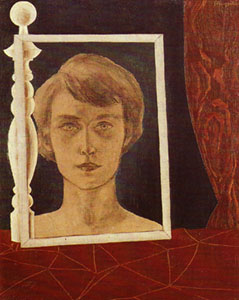
Georgette with Bilboquet- Jan. 1926
In a small portrait of Georgette as a picture within a picture, painted in the first weeks of 1926, the bilboquet standing on the table is partly within and partly out of the picture frame making it an impossible object.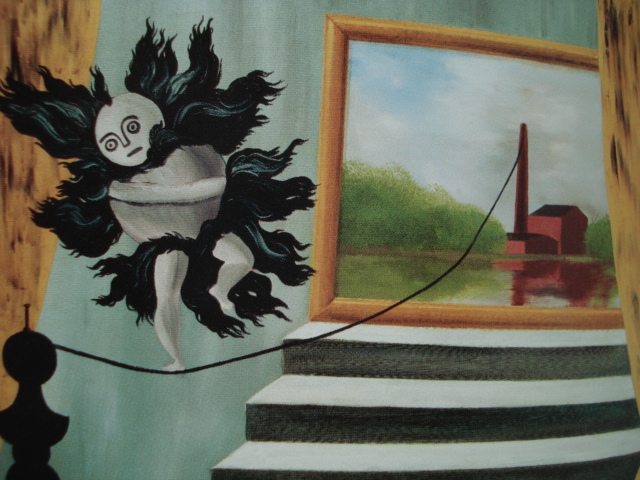
Master of the Revels (Le Maitre du Plaisir)- Early 1926
In The Master of the Revels, which was painted within the first couple of months of 1926, the picture world is connected, literally, to the real world with a piece of black string. The Master walks the tightrope between the painting's reality and outside world. Curiously Magritte's central figure (the Master) is based on a drawing of a masked tribal dancer performing for a European guest. The drawing was found in a book by Waldemar Dreyer published in 1898. Bizarre as the Master appears, he really looks like the tribal dancer. The drawing is reproduced by David Sylvester in his 1992 catalogue of Magritte's work, Catalogue Raissone.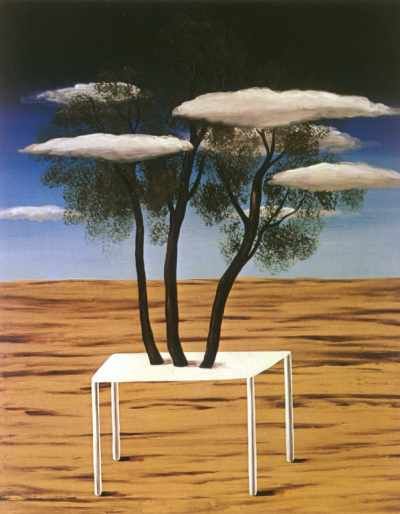
The Oasis (L'Oasis) 1925-1927
The important concept of The Oasis is the intentional distortion of the perspective of the table creating an illusion with the table legs. The other obvious distortion is putting the clouds which should be behind the plant in front of it.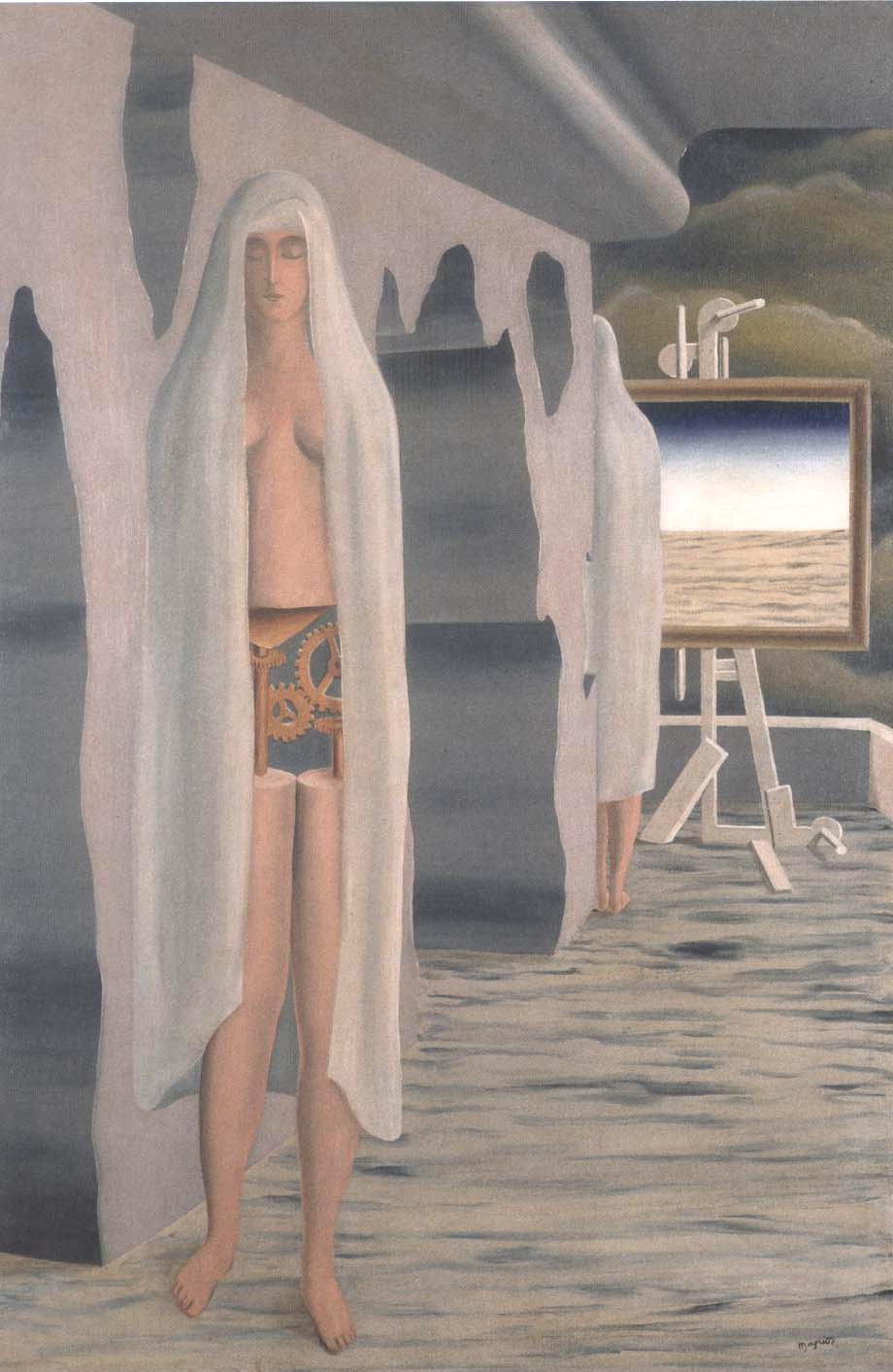
The Age of Marvels (L'Age des merveilles) 1926, 47.3 x 31.5 in. / 120 x 80 cm. private collection.
Two nude women stand shrouded back to back, their abdomens replaced by a clockwork mechanism. They may be one and the same figure shown as a reflection. Magritte's dismantling of the represented object, the deconstruction of anatomy, as it can be termed, is effected in gradual stages. It begins by tentatively moving away from the finiteness of form in a way that destabilises the individual shape: the unity itself of the object, however, is still respected.
In this painting there is both segmentation and stratification. The body is, once again, sliced horizontally, but instead of being dispersed, the parts retain their original sequence. They are distanced by means of divergent scaling. Whilst being firmly rooted in segmentation, the painting points the way to 'stratification.'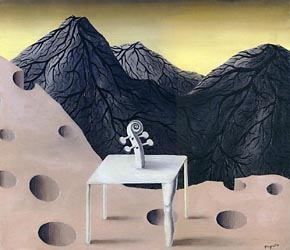
The Roof of the World- Le toit du monde 1926 oil, 65X75 cm
The Roof of the World Shares some similarities with his other 1926-1927 works, the human table leg is the same as in The Difficult Crossing (below). Curiously, the mountains are heart-like organs with veins.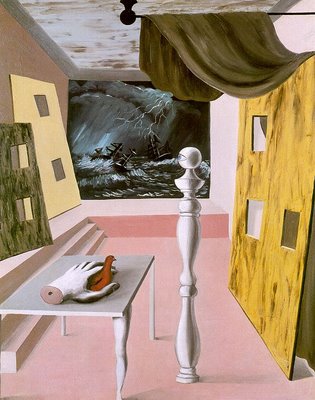
The Difficult Crossing- La traversée difficile 1926 Oil on canvas 80 cm × 65.3 cm (31.5 in × 26 in) Private collection
The Difficult Crossing (La traversée difficile) is the name given to two oil on canvas paintings by the Belgian surrealist René Magritte. The original version was completed in 1926 during Magritte's early prolific years of surrealism and is currently held in in a private collection. A later version was completed in 1963 and is also held in a private collection. The 1926 version contains a number of curious elements, some of which are common to many of Magritte's works.
The bilboquet or baluster appears many of Maggritte's early collages and paintings including The Lost Jockey (1926) The Secret Player (1926-27) The bilboquet sometimes resembles trees or plants. In other instances, such as here with The Difficult Crossing, the bilboquet is given the anthropomorphic feature of a single eye.
Another common feature of Magritte's works seen here is the ambiguity between windows and paintings. The back of the room shows a boat in a thunderstorm, but the viewer is left to wonder if the depiction is a painting or the view out a window. Magritte elevated the idea to another level in his series of works based on The Human Condition where "outdoor" paintings and windows both appear and even overlap. Note also that the front right leg of the table resembles a human leg and the hand resembles a mannequin hand.
In the 1963 version, a number of elements have changed or disappeared. Instead of taking place in a room, the action has moved outside. There is no table or hand clutching a bird and the scene of the rough sea in the ambiguous window/painting at the rear becomes the entire new background. Near the front a low brick wall is seen with a bilboquet behind and a suited figure with an eyeball for a head in front.
There is ambiguity as to whether the suited figure is a man or another bilboquet. Some bilboquet figures, for example those in The Encounter (1929), have similar eyeball heads, however the suit covers the body and no clear identification can be made. Both versions of The Difficult Crossing show a strong similarity to Magritte's painting The Birth of the Idol, also from 1926. The scene is outside and depicts a rough sea in the background (this time without ship). Objects which appear include a bilboquet (the non-anthropomorphic variety), a mannequin arm (similar to the hand which clutches the bird) and a wooden board with window-like holes cut out which is nearly identical to those flanking both sides of the room in earlier version.
All three paintings may have been inspired by Giorgio de Chirico's Metaphysical Interior (1916) which features a room with a number of strange objects and an ambiguous window/painting showing a boat. Magritte was certainly aware of De Chirico's work and was emotionally moved by his first viewing of a reproduction of Song of Love (1914).
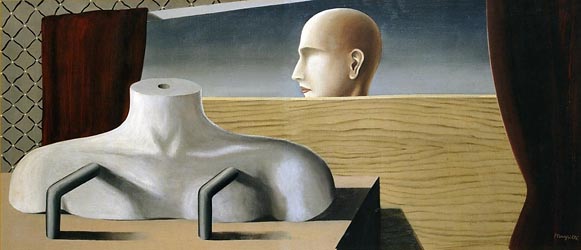
The Migrant Angel, 1926
In 1926 Magritte painted Dawn at Cayenne and The migrant angel. Together with this, an increasing severity and simplicity of composition - especially in The migrant angel- make the images more austere.
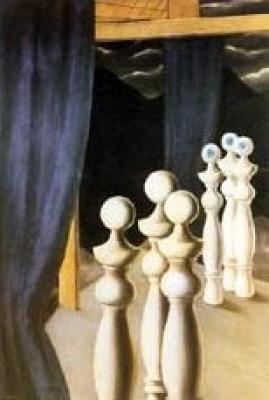
The Encounter (La rencontre) 1926: oil
In La Recontre (The Encounter) the bilboquets hae taken human form with one eye as in the Difficult Crossing. Clearly the encounter is the group of three bilboquets meeting the the other group. Again this is a stage setting with curtains found in many of Magritte's work.
Music (Design for a Review cover) 1926
This is the original design for the heading for page six of the January 1927 issue of Music, a monthly review of dance and music edited by E.L.T. Mesens, and published between October 1926 and January 1927. According to Sylvester, the collage elements are taken from the piano score of The Girls of Gottenberg, a source frequently used by the artist in his papiers collés.
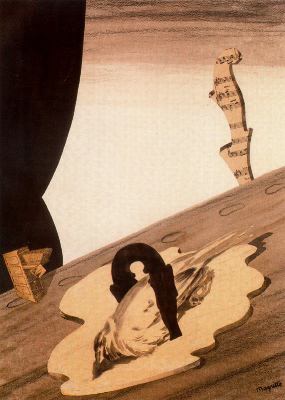
Untitled Collage- circa 1926 Probably a collage of The dead bird (L'oiseau mort), 1926 below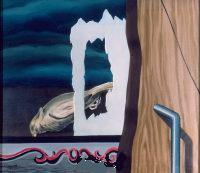
The Dead Bird (L'oiseau mort) 1926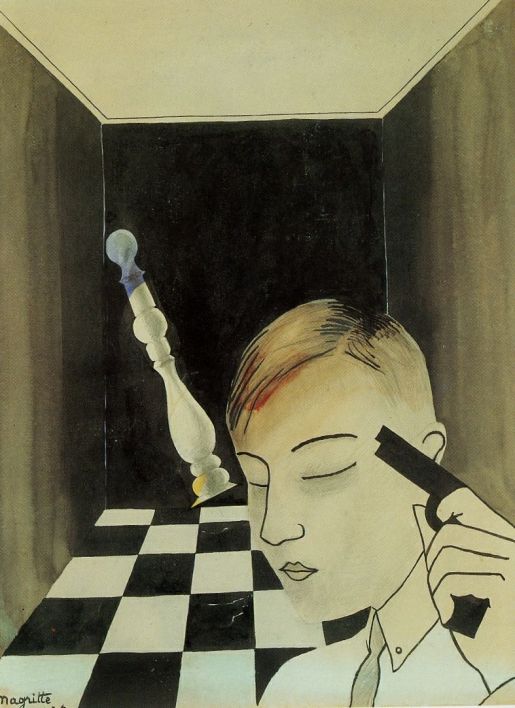
Checkmate 1926
Magritte was an avid chess player and several of his paintings use chess references. The versatile icon, the bilboquet, in this instance resembles a chess piece...the falling king.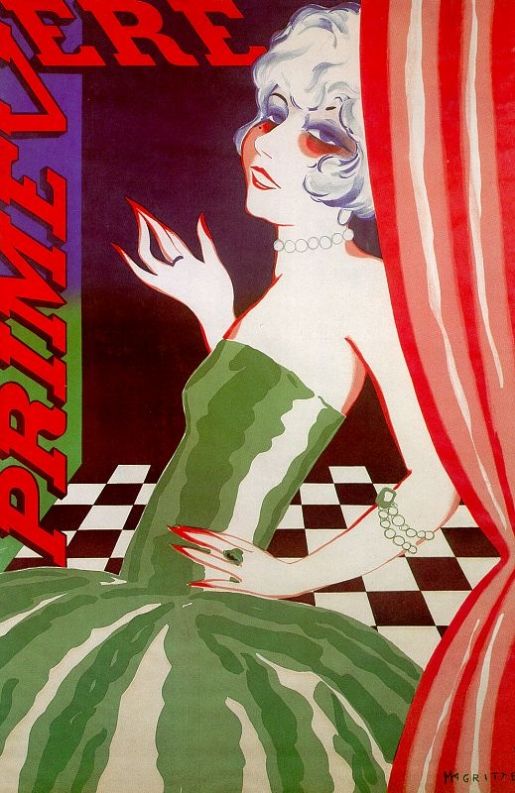
Primevere- 1926
This is a poster done in the Art Deco style that Magritte used in his advertising for Norine. Magritte designed the poster for Primevere, a singer for the agency: Publicite Meunier Brussels.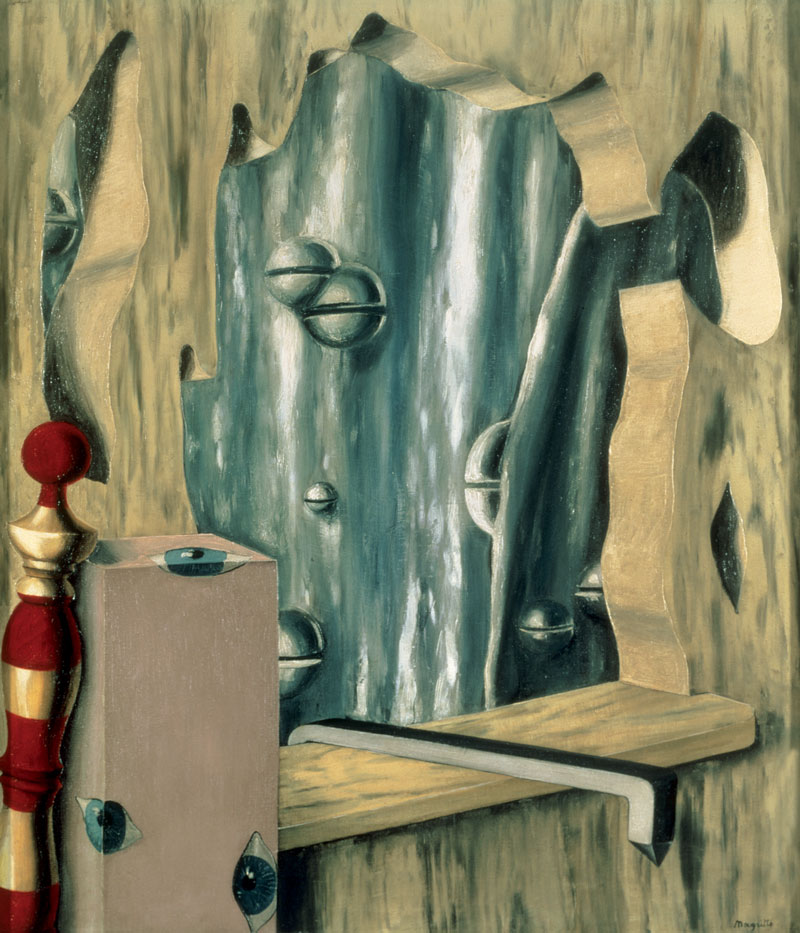
Silvered Chasm (Le gouffre argenté) 1926 75 x 65 cm. Musée Collection Berardo, Lisbonne
Silvered Chasm also called the Silver-plated Pit features the icon, the bibloquet, peering through a cutout window at the silver pit. Another icon, the bell, is attached to the silver column.
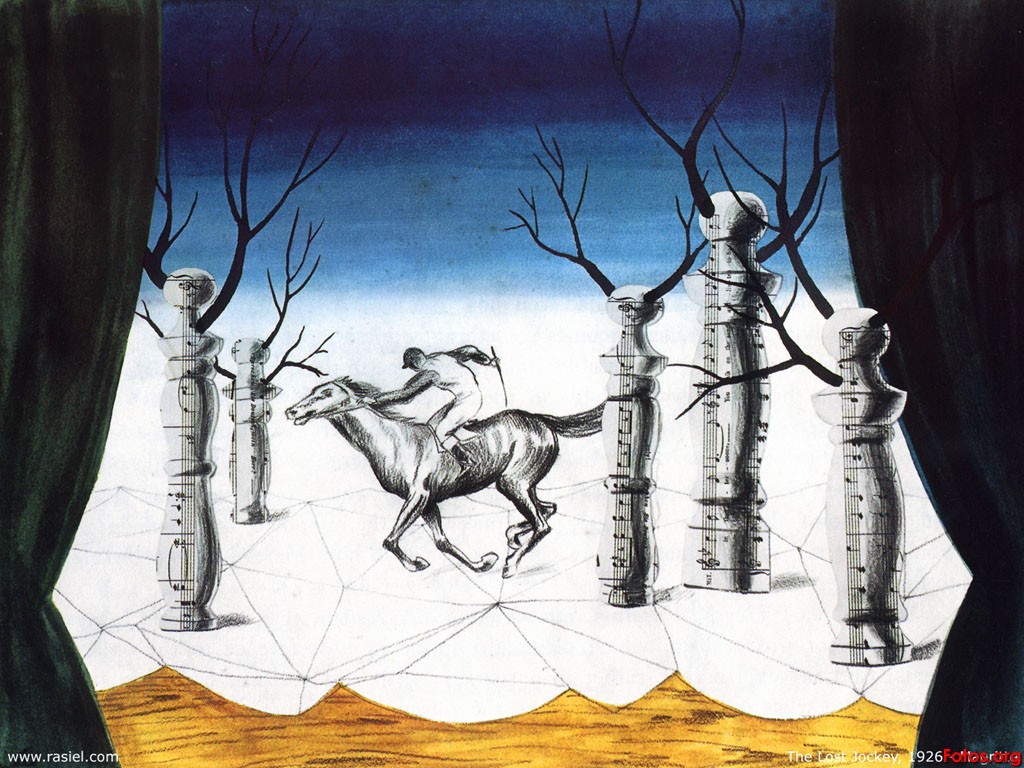
The Lost Jockey (Le jockey perdu) 1926 Collage
The lost jockey is clearly riding on a wooden stage with curtains. The stage is covered with a white cloth with geometric patterns that are umbrella-like. The bibloquet on the right is an impossible object, existing behind and in front of the right curtain.
Inspired by the collages of Max Ernst and the paintings of Giogrio De Chirco, Magritte began his new direction in art around 1925 (according to a quote by him). Magritte was an active participant of Dadaism and the Belgian branch surrealism which united in 1925. The Lost Jockey (Le jockey perdu) was one of a series of collages that contained the bibloquet or balluster that Magritte created in 1925-1926. He considered The Lost jockey to be his first surrealist work although several of his earlier collages would certainly qualify.
Magritte did two versions of the the Lost Jockey in 1926- a collage (above) and an oil (fairly primitive). He revisited this painting theme many times; sometimes to paint a copy as a request for a patron. When he would redo the painting, he would usually change the new version slightly from the earlier version.
Rene designed theatre sets in Brussels in the early 1920s for Theatre du Groupe Libre. The Lost Jockey is one of many theatre settings with a curtain that Magritte produced in his early works. It also uses bilboquets that resemble trees with musical notation as bark, possibly as a tribute to Mesens, the pianist and composer and his brother Paul, a musician who studied with Mesens.
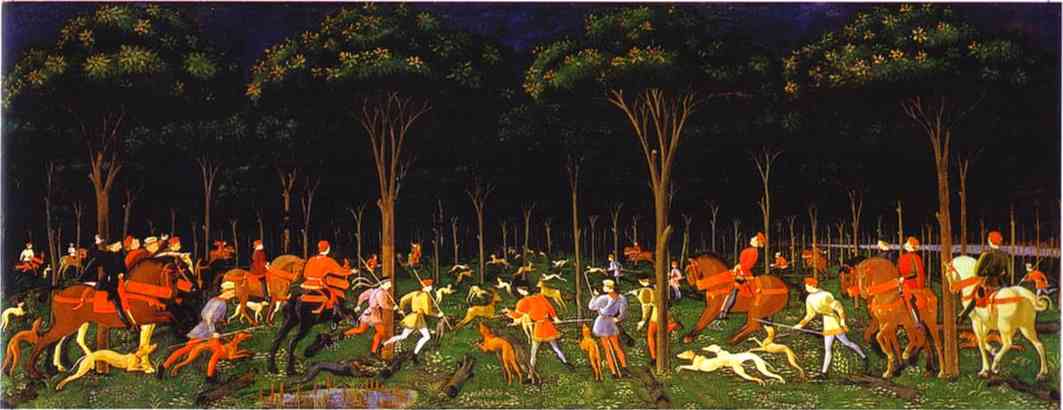
According to David Sylvester, a Magritte scholar, this painting "A Hunt in the Forest" by early Renaissance painter Uccello is the basis for the Lost Jockey.
Notes from another source: Le jockey perdu is one of the largest format gouaches by René Magritte, a variation of one of the artist's favourite themes, the crazily displaced horse racing with its rider through an incongruous landscape. In this gouache, Magritte has introduced several other motifs as well: floating above the lost jockey of the title is a mysterious sphere, while the entire scene is shown through a strange, rocky portal, as though the viewer were in a colossal cave at the edge of this flat scrubland.
Magritte first tackled the theme of Le jockey perdu in 1926, a watershed period for the artist, in which he suddendly found a means of exposing the mysteries of the world, the poetic associations between the objects that form our reality and which we take all too much for granted. His strange juxtapositions challenged the viewer, demanding that we consider afresh the properties of the everyday elements of the world around us. So, in this gouache of Le jockey perdu, it can be seen the racetrack that would usually play host to a jockey is absent, the racer taken out of context. At the same time, a strange new planet hovers as though within the atmosphere of the Earth; this ball has replaced the sun and the moon; its looming presence adds a cosmic oddness to the entire picture.
It is a tribute to the importance of this theme that Magritte himself would write, with reference to his original oil of the subject, that 'Le jockey perdu (The Lost Jockey) is the first canvas I really painted with the feeling I had found my way, if one can use that term' (R. Magritte, quoted in H. Torczyner, Magritte: Ideas and Images, translated by R. Miller, New York, 1977, p. 48). Magritte's own revelation had occurred when he had seen a painting by Giorgio de Chirico. Presenting the viewer with an eccentric assortment of seemingly unassociated objects, de Chirico's Le chant d'amour introduced the viewer to a realm in which another hidden logic appeared dominant. While the mysticism of de Chirico did not influence Magritte, the break with perceived reality and the use of juxtapositions did. For this reason, Magritte denied the open influence of de Chirico, making specific reference to his first version of Le jockey perdu:
'If one takes into consideration what I've painted since 1926 (Le jockey perdu-1926-- for example, and what followed), I don't think one can talk about 'Chirico's influence' I was 'struck' about 1925 when I saw a picture by Chirico Le chant d'amour. If there is any influence it's quite possible there's no resemblance to Chirico's pictures in Le jockey perdu. In sum, the influence in question is limited to a great emotion, to a marvellous revelation when for the first time in my life I saw truly poetic painting. With time, I began to renounce researches into pictures in which the manner of painting was uppermost. Now, I know that since 1926 I've only worried about what should be painted. This became clear only some time after having 'instinctively' sought what should be painted' (R. Magritte, quoted in ibid., p. 258).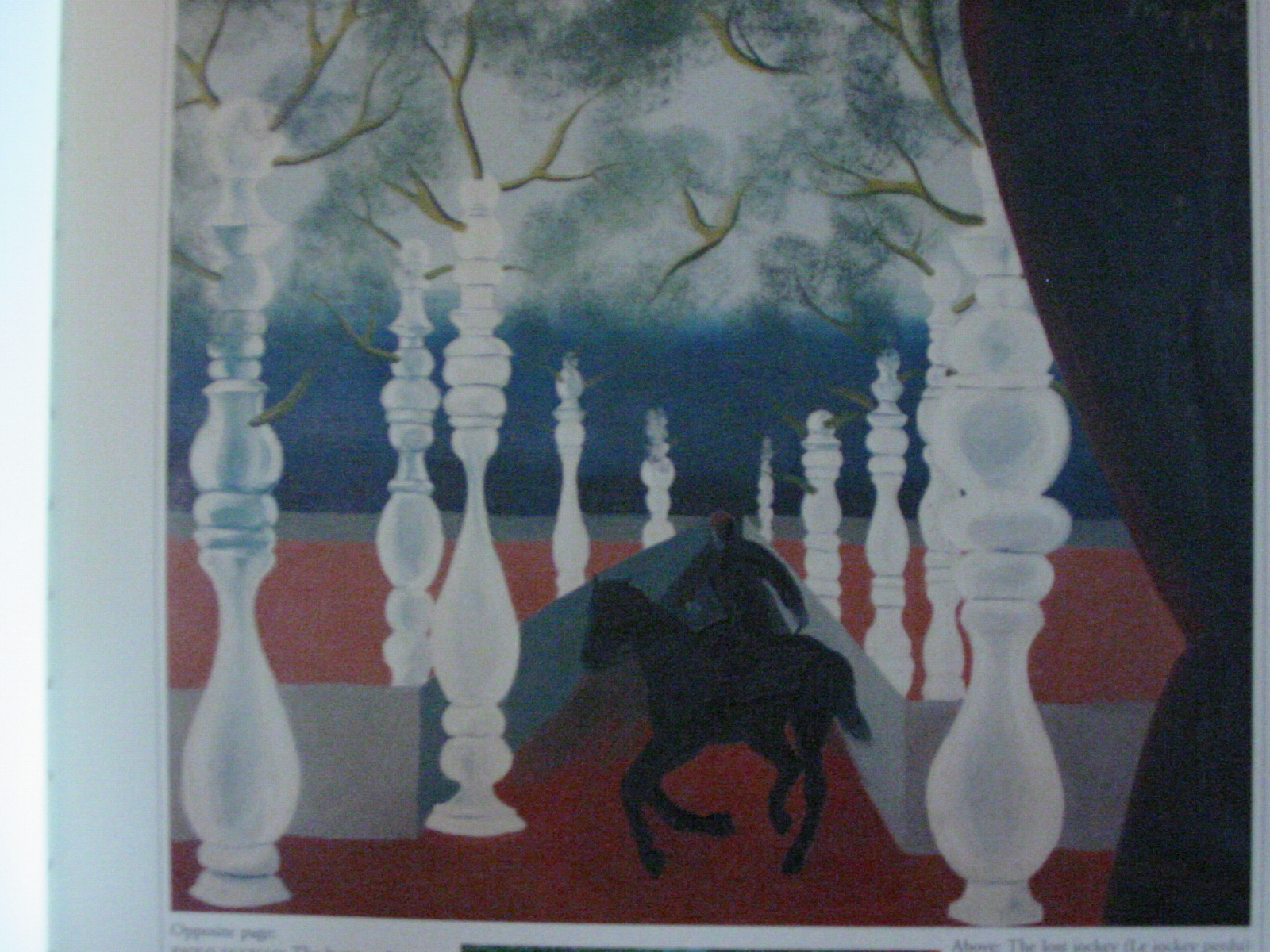
The Lost Jockey 1926 oil
Magritte's oil painting of the Lost Jockey is rarely featured when discussing the painting that he considered to be his first surrealist painting. He redid this painting in 1942 to better effect. The real problem is the clumsy treatment of the horse and rider.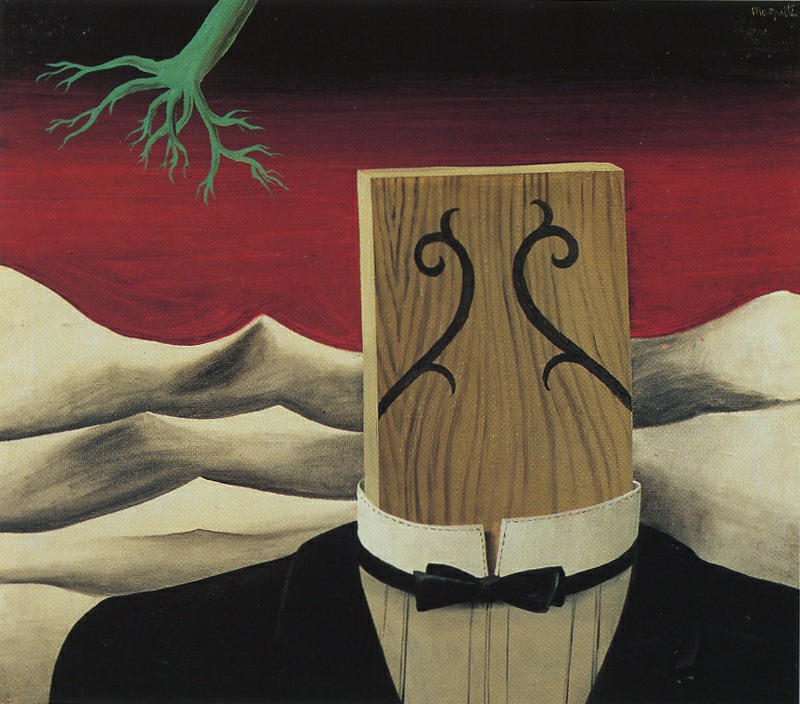
The Conqueror (Le Conquerant), 1926
The Conqueror depicts a musician dressed in formal attire, sporting by a black bow tie. A wooden plank replaces the head with two plant like, violin like, decorations. It reminds me of a tenor about to sing an aria.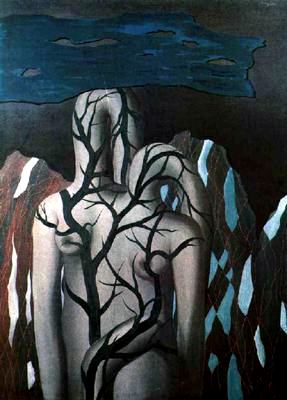
Landscape- 1926
Magritte used veins in several paintings, noteably the Blood of the World. It's one of several effects he borrowed from Giorgio de Chirico. See: De Chirico's 1914 "Span of the Black Ladders" for one example.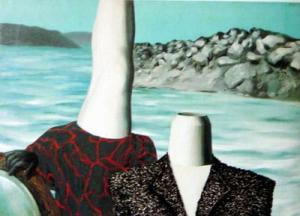
The Denizens of the River (Les Habitantes du fleuve) 1926, 28.7 x 39.4 in
The Denizens of the River features a figure that has a leg for a head. The figure's right hand enigmatically points to what appears to be a mirror. Both figures seem to be mannequins modeling clothing items.
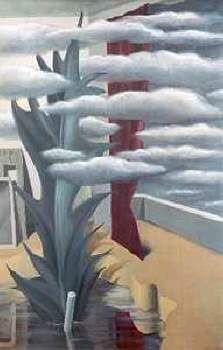
After the Water, the Clouds 1926
After the Water has a cut-out image that is tuned into a lake with a lever.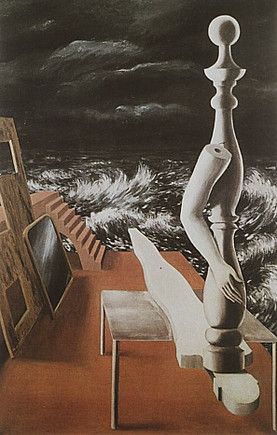
Birth of Idol (La naissance de l'idole) 1926 oil 47.2 x 31.5 in
The Birth of Idol feaures a bilboquet with a mannequin detached arm walking the plank into a raging sea. It's very similar to The Difficult Crossing and The Encounter both done the same year- 1926.

Popular Panorama (Panorama populaire) 1926
This interesting study gives three simultaneous horizon lines and is the type of illusion popular with artists today. The painting was purchased by his friend ELT Mesens who bought 150 of Magritte's paintings after his return to Brussels in 1931. It is now in a private collection.
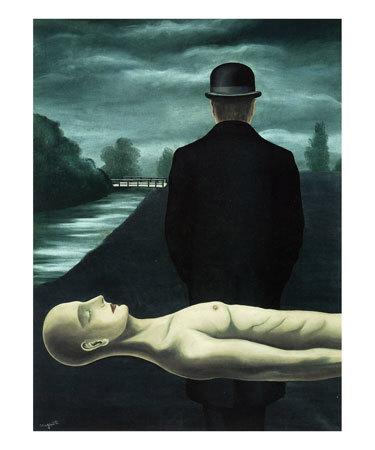
The Musings of the Solitary Walker- 1926
This painting is Magritte's private reflection on the suicide of his mother in 1912 when he was just thirteen years old. On the left is the Sambre River where she she was found 17 days after she disappeared. Magritte in his famous Fantomas bowler-hat garb has his back turned from the image of his mother as if by avoiding the pain he free himself from the memory. He never liked to discuss his past largely because of this incident.
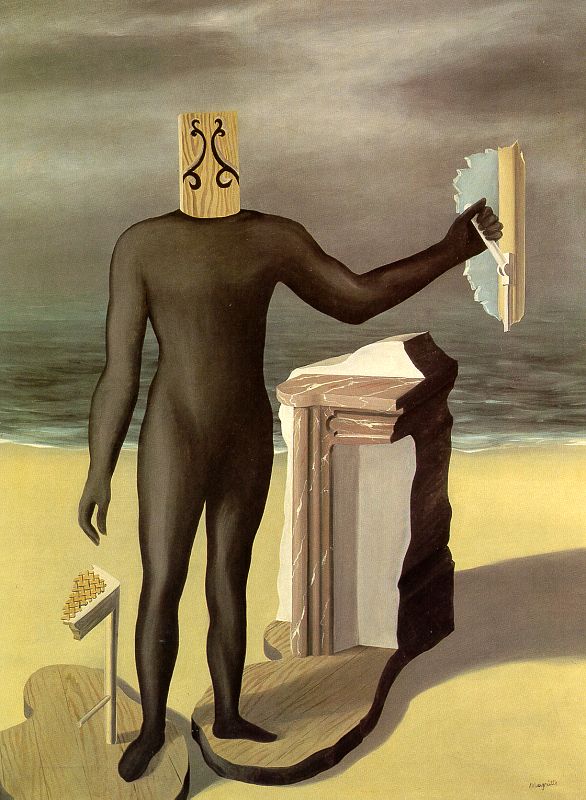
Man of the Open Sea (L'homme du large)- 1926
In his 1926 painting Man of the Open Sea (L'homme du large- the tile comes from the 1920 silent film by Marcel Herbier) Maggrite employs elements from the final scene of Feuillade's second Fantômas film Juve contre Fantomas, in which the Man in Black raises his arms in triumph after throwing the lever that destroys a house in which Juve and Fandor are trapped. In the painting below we see that Fantomas in his black garb is preparing to pull the lever to blow up the house.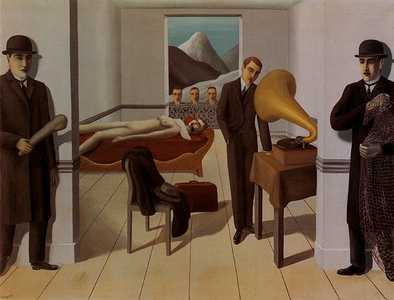
The Threatened Assassin (L'assassin menacé)-1926
The painting The Threatened Assassin (1926-27) is another of Magritte's paintings that captures the mystery of Fantomas. The painting is derived from a scene in Louis Feuillade's Fantômas film of 1912. It depicts two figures concealed by the doorway, armed with strange weapons, watching the "murderer," who is dressed in a business suit. Fantômas , the film, was based on the thirty-two-volume series written by Pierre Souvestre and Marcel Allain, each of whom wrote alternate chapters. Magritte was fascinated by the character of Fantômas who can pass unseen through matter, defy the establishment, and subvert its order.
Here's an analysis from Levy: Magritte's room, portraying the "stabbed mannequin," by its very complexity, sets up resonances that echo throughout Robbe-Grillet's text. It matters little that the latter's narrative contradicts details in the painting or adds to them, since the picture is subverted in the same manner that reality is contradicted. The three men looking in the window of The Threatened Assassin are not mentioned in Robbe-Grillet's text and the bowler-hatted man on the left, outside the door, is holding a baluster, not a club. Robbe-Grillet invents the sound of the phonograph that the young man inside the room is listening to and the narrator says it is replaying the woman's cry. This cry animates the painting and the naked mannequin which becomes a "real" woman. Although there is no sewing machine in the picture, the narrator tells us that the phonograph is the same age as the sewing machine, an allusion to Lautréamont's dissecting table where the fortuitous encounter of an umbrella and a sewing machine generates the ultimate spark of Surrealist beauty and activity.
Here's mine: Magritte provides this narrative- Fantômas has just killed a woman, and having placed a pure white cloth over her upper chest, pauses to listen to a record on the phonograph. Outside the room, three witnesses stare into the inner room. Juve and Fandor (two detectives closest) threaten to capture Fantomas, one with a cudgel, the other with a net. Clearly Fantômas is surrounded (threatened) but is he worried? No..."because he always escapes and even passes through walls." [The Beribboned Bomb By Robert James Belton] Belton relates that Magritte's painting may be based on the case of murderer Henry Landru who in 1922 was executed for murdering several women for their money.
David Sylvester, Magritte's biographer, suggests that this painting and the 1927 "Girl Eating Bird" were scripted from a set of violent and erotic poems by Paul Nouge finally published in 1956. The poems were written circa 1926-1927 when both Magritte and Nouge were working together designing catalogues for Samuels, a fur company. Here are some of the poetry lines:
[In the background, at the level of the window sil,
Four heads (Magritte only had room for three) stare at the murderer.
In the corridor on either side of the wide pen door,
Two men are approaching unable as yet to discern the spectacle.
They are ugly customers.
Crouching, they hug the wall.
One of them unfurls a huge net, the other brandishing a club.
All this will be called, "The Threatened Murderer."] Paul Nouge
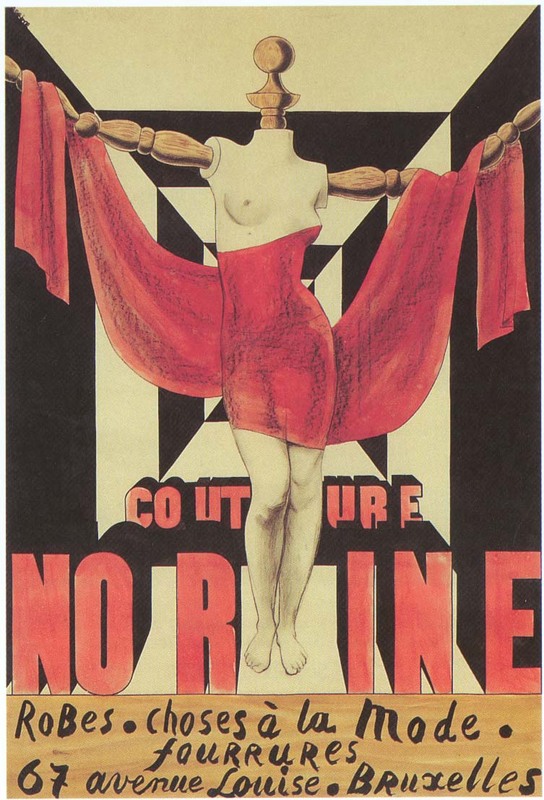
Norine Advertisement 1926
Magritte began designing posters and ads for Norice in 1924. Norine was run by a charismatic couple: the cultural and intellectual Paul-Gustave Van Hecke, who became a patron of Magritte's art, and the grande couturière Honorine “Norine” Deschrijver. They established their couture business during World War I. For the first time, a Belgian couture house created its own designs instead of buying them from Paris, and offered an attractive and highly original local alternative. After the war, they became one of the most important couture houses in the country. Their avant-garde designs boldly transcended the modest conventionality of Belgium. The national and, to some extent, international artistic intelligentsia were their customers. The history of Belgian avant-garde fashion begins with Norine.
Norine was a prominent representative of the Modernist movement in fashion. In fact, Van Hecke and Norine’s environment was entirely modern and was a hub of Surrealism and Expressionism: their private home, Van Hecke’s art galleries and journals and the couture house’s salons featured work by national and international contemporary artists.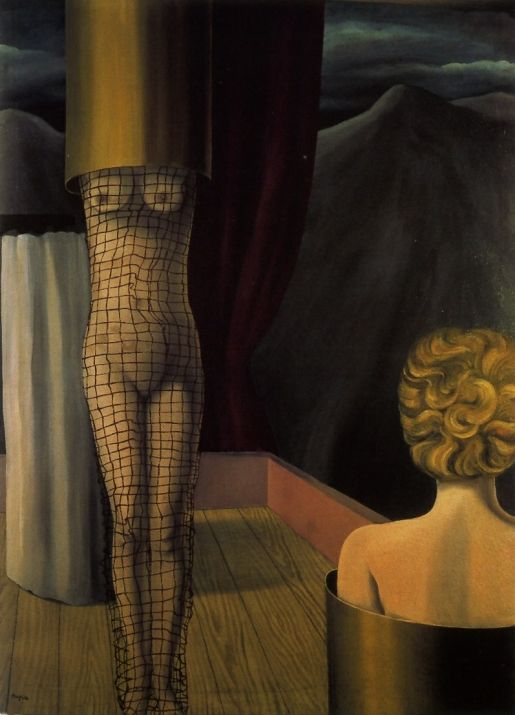
The Magician’s Accomplices 1926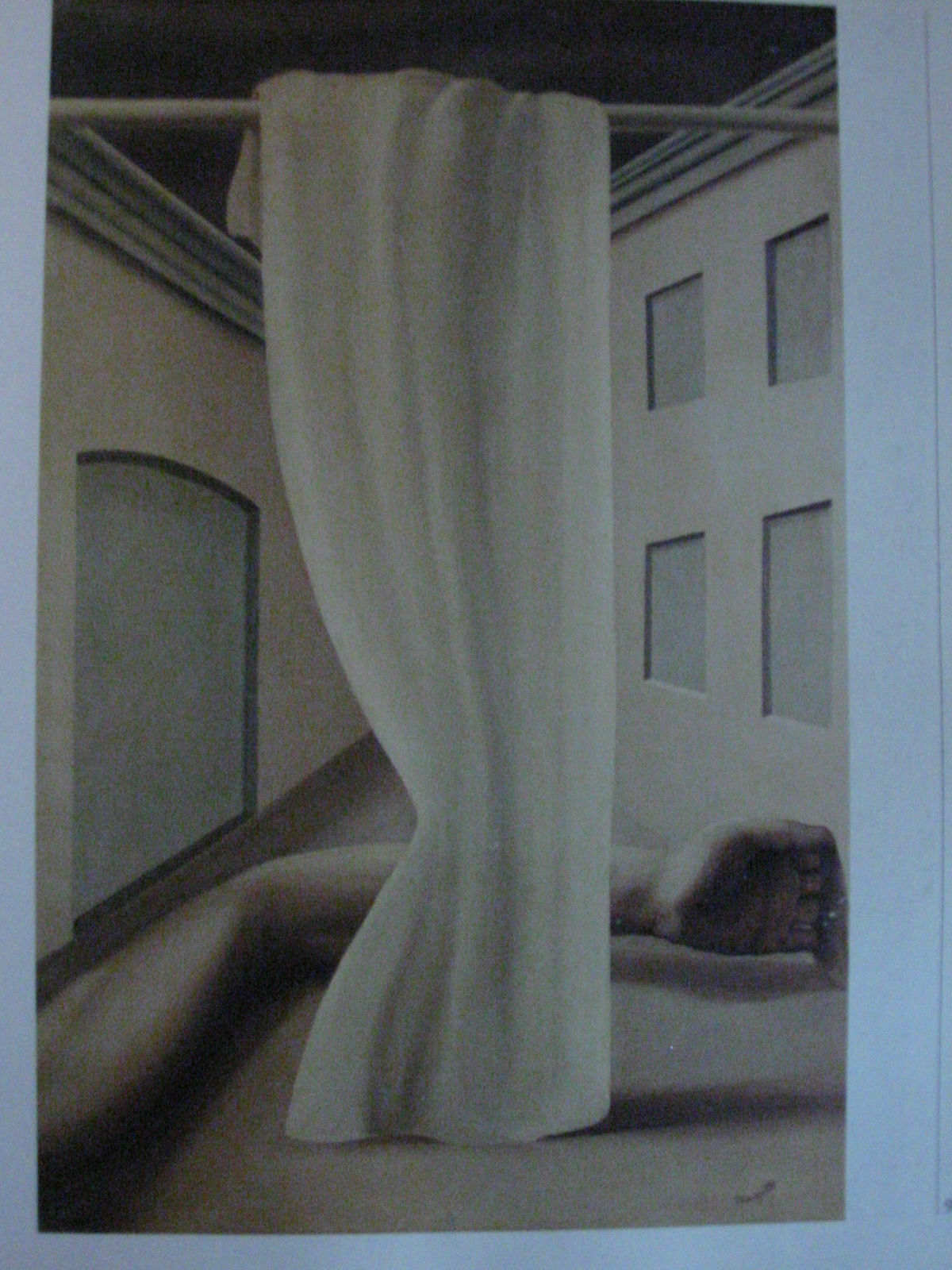
The Village of the Mind 1926
The village of the mind is simply Magritte's early attempt to make normal objects become huge. The giant arms occupies the stage behind a curtain on a rod. The fingers dissolve through the wall as if it was invisible. Magritte does this much later in his career in a more sucessful way and even his first The Giantess (1928) created this ilusion to better effect.
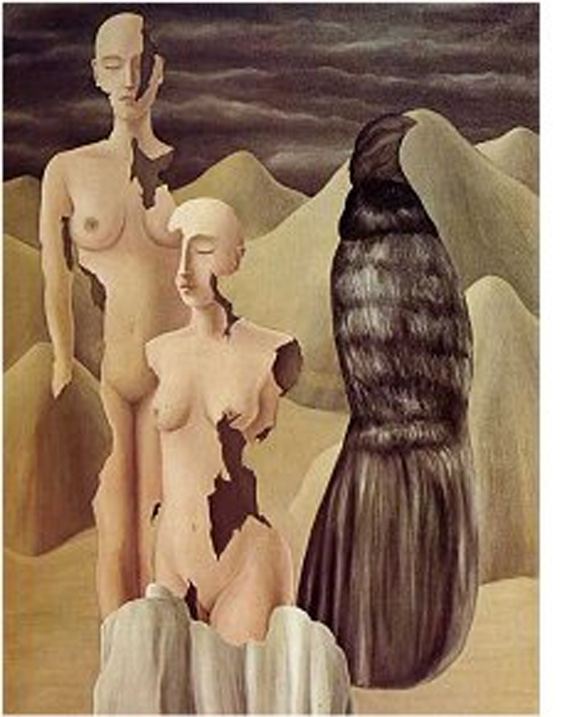
Polar Light (La lumière du pôle) 1926 or 1927
Taken from the 'Nouveau Larousse Universel' (Great Universal Dictionary of the 19th Century). Polar Light features more experimentation with the deconstruction of the human image. Again the image features resemble mannequins and since Rene worked for the fashion designer Norine, it can expected. For another example see: A Taste for the Invisible 1927.
The figure with a bird’s head wearing fur, is a work that can be found with some variations in one of Samuel’s catalogues, in which a woman with a bird’s head is used to advertise leather coats. Compare the image below: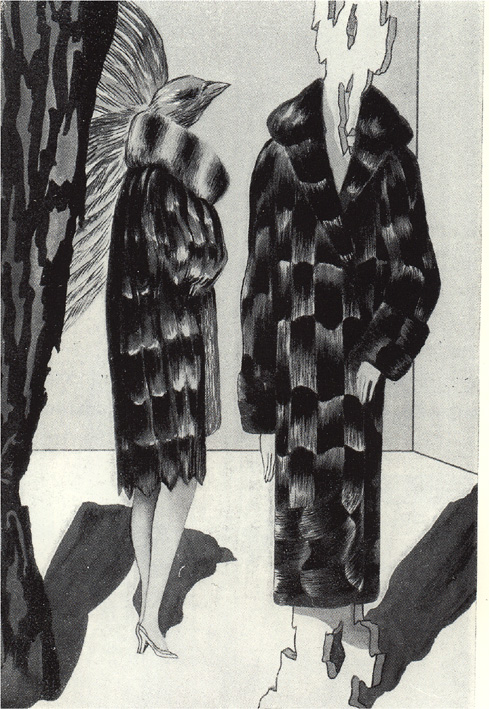
Samuel's Ad by Magritte 1926-1927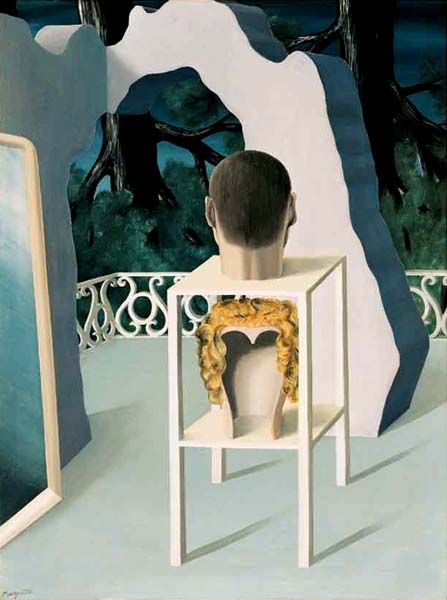
Midnight Marriage (Le Mariage du Minuit) 1926
Magritte often paired a back view of a head with a front view of a head.
There's is some similarity to De Chirico's The Two Sisters (1915):
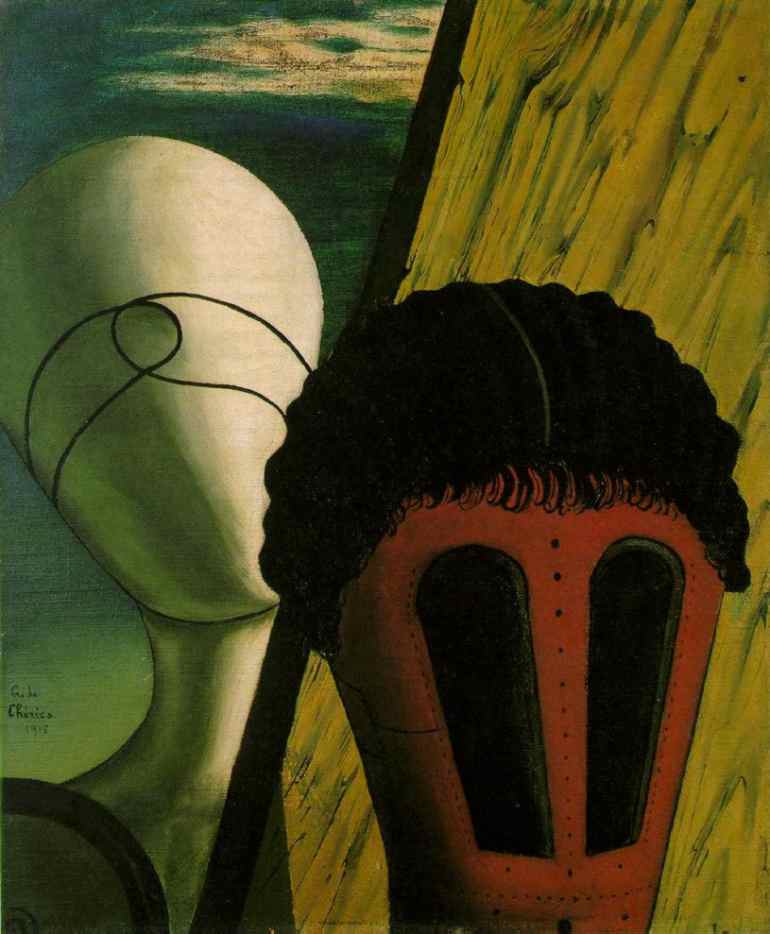
De Chirco's images are used in other Magritte paintings. Here the faceless woman (bride) image bears a resemblance to the closest sister. The back view of a decapitated male head stares into a deconstructed facade. The table is slightly out of porportion and the shadow makes no sense. To me the most interesting part of the background is the trees are upside down.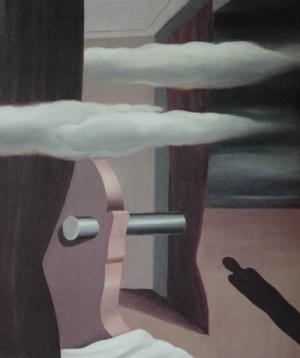
Desert Catapult (La Catapulte du desert) 1926, 29.5 x 25.6 in. / 75 x 65 cm
The Desert Catapult is plays with the laws of perpective. The clouds and setting are used in better effect in Magritte's 1931 painting the Tempest. Magritte experiments with the clouds several times in 1926 with his painting "After the Water, The Clouds" and "The Oasis." Here there's a stage within a stage with a mysterious object and a mysterious shadow. This is also one of his earliest paintings featuring the mysterious icon- the sheet. Magritte uses the sheet to cover up objects that can usually be seen. The mysterious object is partially hidden suggesting that there is part of the object that we will never know. Porbably the mysterious object in some way resembled a catapult (maybe suggested by an associate or friend) so as a joke it was so titled.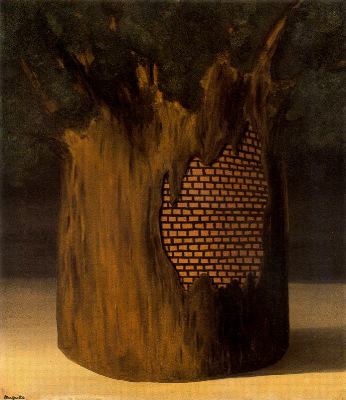
Threshold of Forest (Le Seuil de la foret) 1926- 29.5 x 25.6 in. / 75 x 65 cm
Threshold of a forest is another painting defying perspective- the tree trunk is upside down and placed on some type of board. Behind the facade of the tree is a brick wall, an unexpected reality.
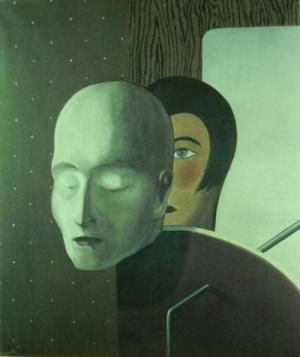
He Is Not Speaking (Il ne parle pas) 1926- 29.5 x 25.6 in
This image is also found in photographs done by Magritte, noteably 'The Shadow and it's Shadow" taken a few years later. The male figure has a female shadow. Curiously, this is something I've also done in one of my paintings. Unfortunately this is a fairly weak painting by Magritte done early in his career.
Wreackage of the Shadow (Les Epaves de L'ombre)- 1926
The Shadow's Wreckage is significant because the odd shaped bird in the foreground is outlined in the mountain on the left. This mountain/bird transformation would be revisited with Magritte's famous Domain of Arnheim in 1938.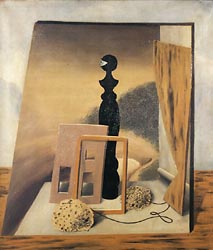
The Loftiest Game (La sommet du regard) 1926
Magritte was an avid chess player. This time the versatile bilboquet represents a chess bishop. The painting within a painting (in this case it's- a painting within a painting, within a painting) theme is present- this time with a twist- the right side of the frame is in a different perspective than the rest of the painting.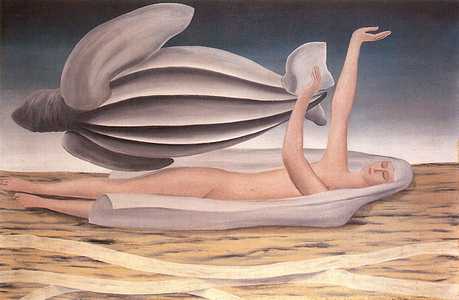
The Garment of Adventure 1926, oil on canvas
This odd giant turtle form (actually a Shargis) shows up again in the Secret Player (see several pics below) one of Magritte's more important early works.
After the ball (apres le bal) 1926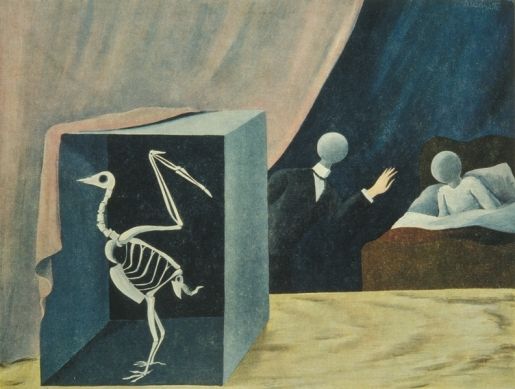
The Sensational News (La Grande Nouvelle), 1926. Oil on canvas, 62 x 81 cm. Private collection, Belgium
The Poetic World I (Le Monde Potique) 1926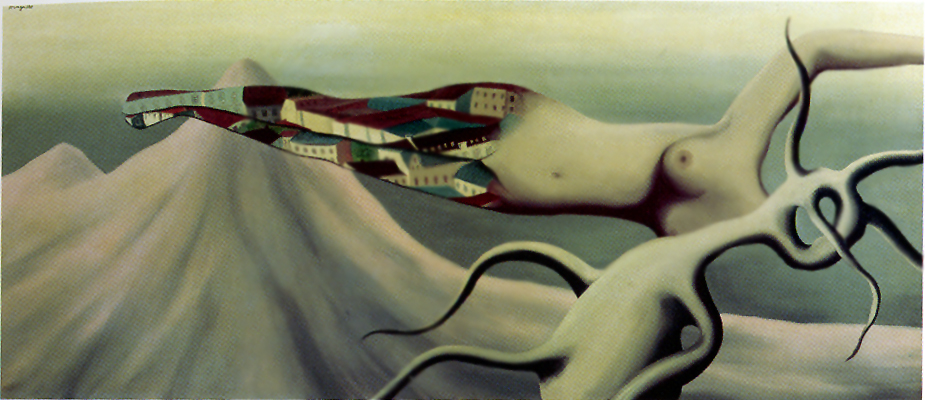
Great Journeys (Les Grande Voyages) 1926, 25.6 x 59.1 in. / 65 x 150 cm
Great Journeys has a whole new world (another dimension) inside of the horizontal figures lower extremities.

The Ordeal of Sleep- 1926 or 1927 oil on Canvas
The Ordeal of sleep is a painting of Georgette sleeping with the mysterious white sheet (which represents perhaps Magritte's mother's white night gown) caefully watching her. This iconic image (the white sheet) also represented the hidden (unconscious) activities of the mind.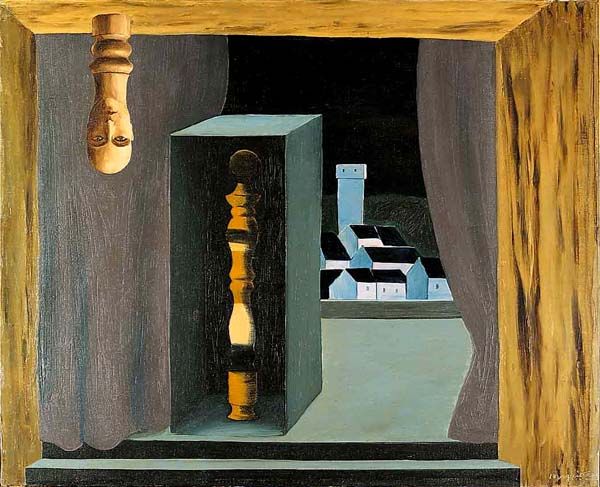
L'Homme Celebre- 1926
Max Ernst when describing Magritte's work, called him "A painter of collages." This painting certainly looks like a collage.
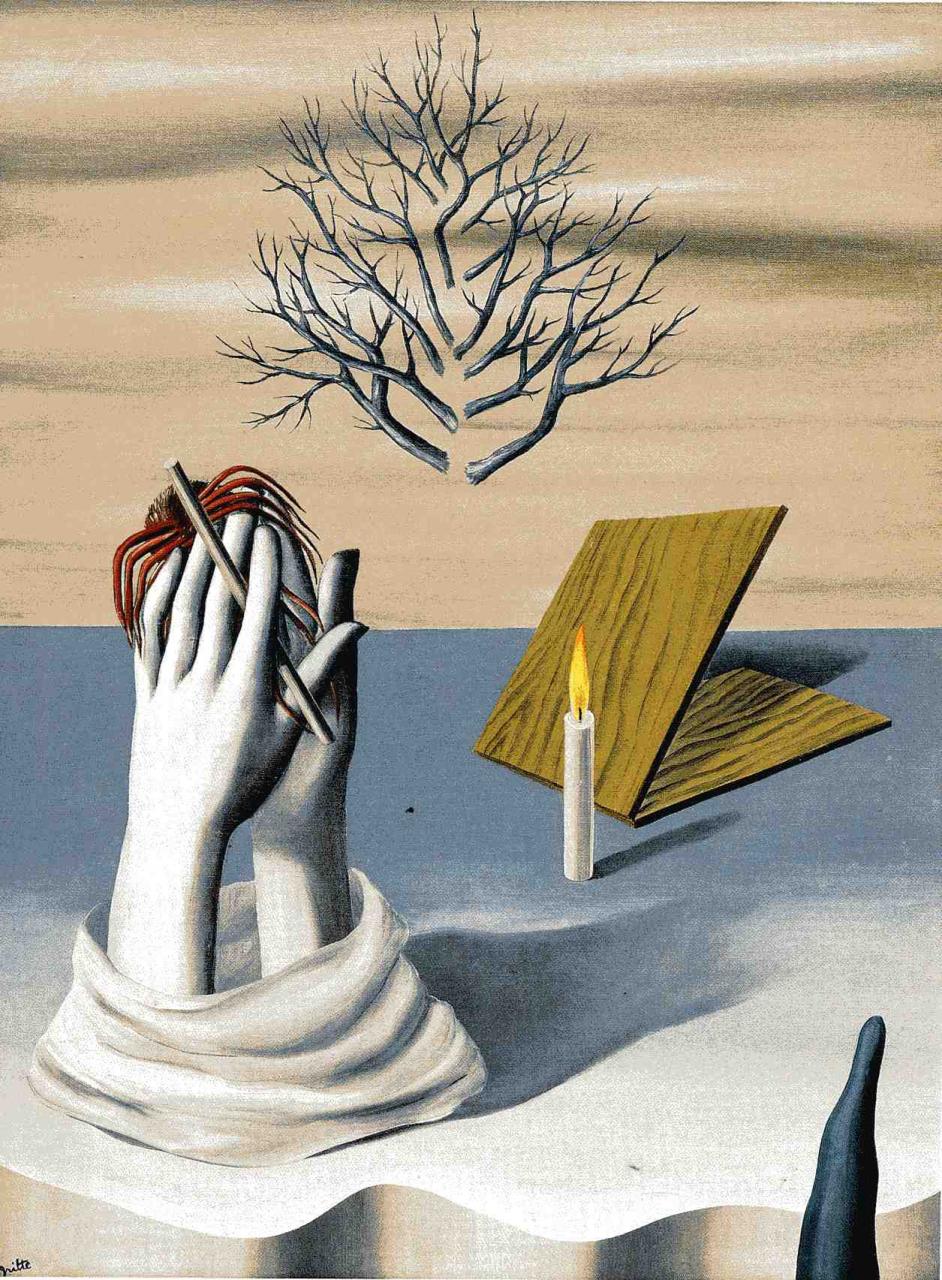
The Dawn of Cayenne (L'Aube a Cayenne) 1926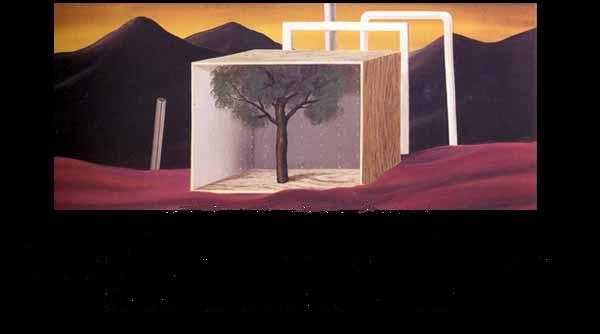
The Vulture's Park- 1926
Please ignore the black border around the image.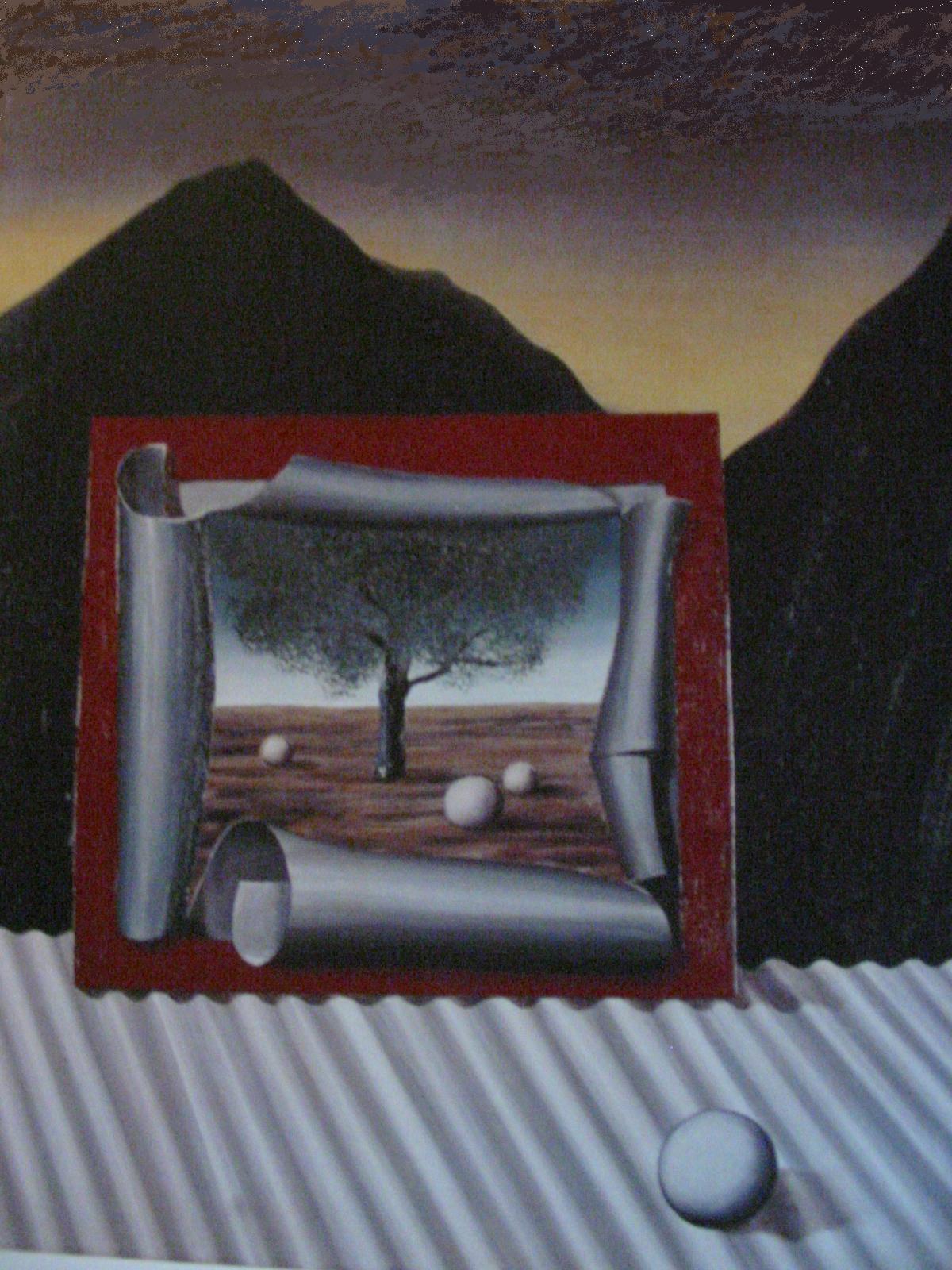
The Signs of Evening 1926
Another painting within a painting, one of Magritte's favorite mysteries.
The Message to the Earth 1926
Magritte uses his favorite trick, the painting within a painting. A bright red meteorite has fallen to earth and is trying to send a message via a few wires behind the picture fram and a tacked up curtain. The curtain is used for two trompe de l'eoil tricks: 1) at the top of the frame it's in front of the meteor but at the bottom the meteor is behind- impossible of course.; 2) the curtain is tacked up to thin air- with bright red tacks.
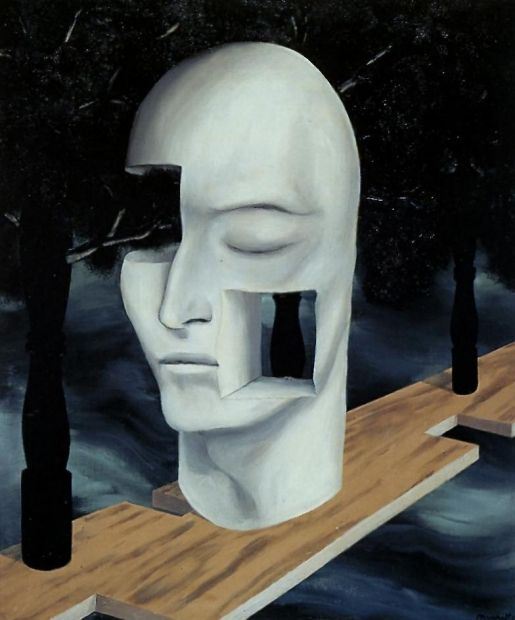
The Face of Genius- Le Visage du Genie, 1926-27, 29.5 x 25.6 in. / 75 x 65 cm
The Face of Genius has a similar bald mannequin characteristics and pose to He is not Speaking To Us (see Above).
In 1924 Magritte began doing illustrations for Norine, leading fashion designers. The genius appears to be a mannequin's head placed on a sheet of ply-wood between black bilboquets with branches.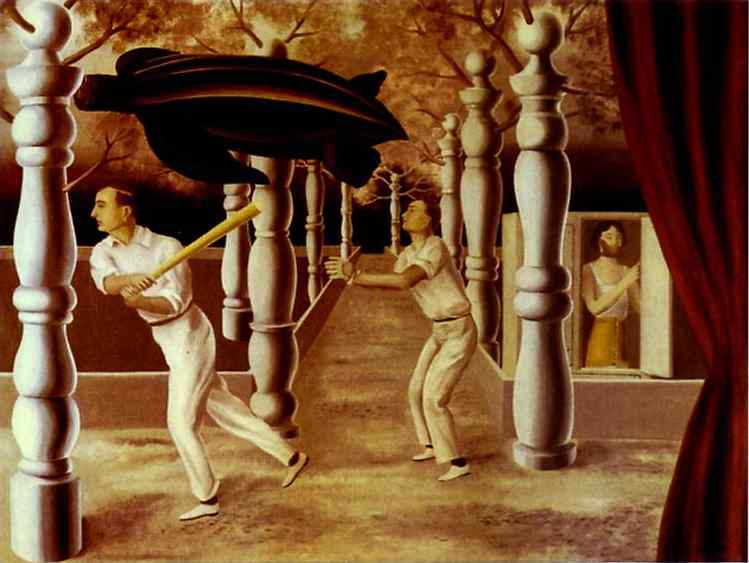
The Secret Player Le Joueur secret, 1926-1927, 59.8 x 76.7 in. / 152 x 195 cm
In a similar setting as The Lost Jockey (1926), The Secret Player features a cricket game in a forest of bilboquets with a large turtle form (Sphargis) swimming secretly overhead. A mysterious woman opens a window on the right hand side. Her mouth is covered with a mask.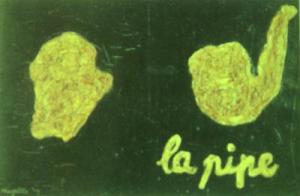
La Pipe 1927
In 1927 Magritte made the first of the 'pipe' paintings, a crude image with the words 'la pipe' scrawled underneath it. This is one of his earliest painting with words. This painting might derive from Mallarme's nostalgic prose poem, "La Pipe." In 1929 he would painting a refined image and label it "This is not a pipe," which became one of his best known images.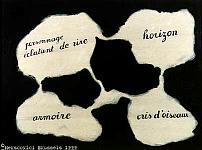
The Living Mirror- La Miroir Vivant, 1927 Oil on canvas 54 by 73 cm
The Living Mirror is one of Magritte's first word paintings from the 1927 period. In this painting the four concept or dialogue blobs each have a concept (Love) (Horizon) and are linked together.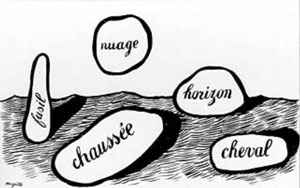
The Use of Speech- L'Usage De La Parole 1927
In the Use of Speech 1927 the dialogue blobs are more distinct, the horizon blob is actually on the horizon line. Magritte would come back to this creating other versions titled the Use of Speech.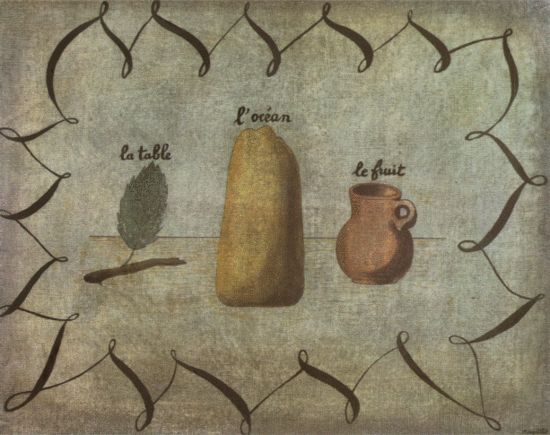
Table, Ocean and Fruit (La Table, L'ocean, et le fruit) 1927 oil on canvas, 50 x 65 cm. Brussels, private collection.
Another of Magritte's early words and image experiments; the leaf is labeled the table, the object is labeled the ocean and the cup is labeled the fruit.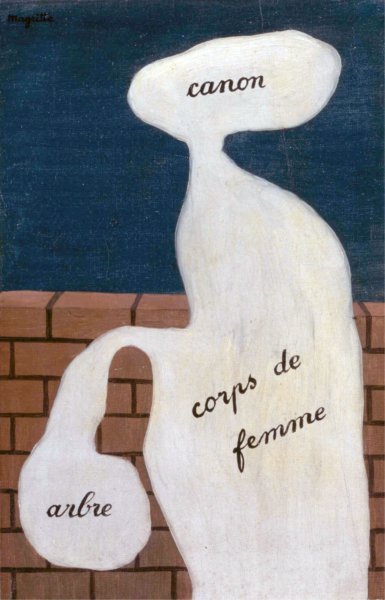
L'Usage de la Parole- 1927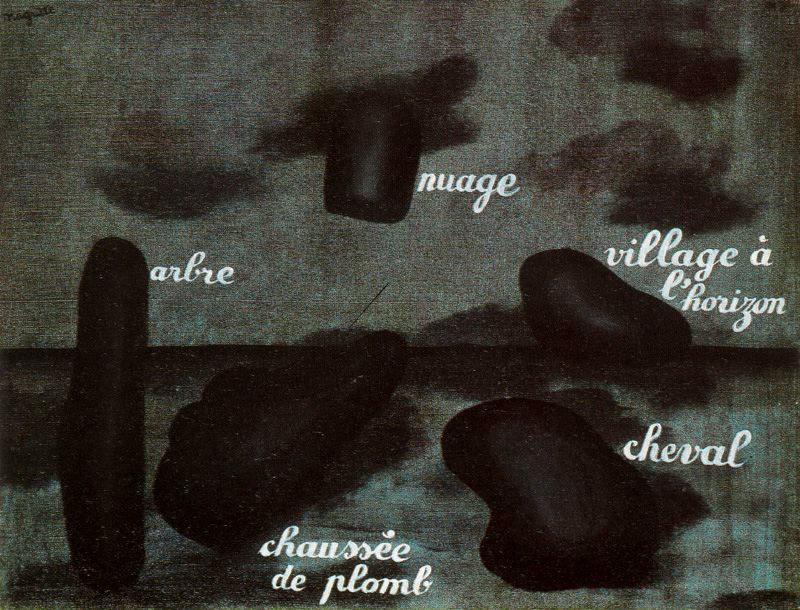
The Swift Hope- 1927 L'Espoir Rapide
Magritte's L'Espoir Rapide (Swift Hope) makes a similar reduction. It offers a very inarticulate image, just about the minimum that will qualify as a pictured scene. And to emphasise the point, Magritte labels the image with some paradoxically specific words. But ignore the white labels for the moment. Concentrate on the deep-blue scene. How inarticulate is it really?
It's not a complete mess. It shows five clear elements, five rounded forms, with distinct shapes and different sizes. They have a hint of solid volume, a lighter patch swelling out of the middle of each one. You can't say precisely what they are, but they're not just anything. They're definitely something blobby " like megaliths, or inner organs, or amoebae.
You can say more. The long thin one is standing upright. Three are lying on the ground at various distances. The small one is off the ground. In other words, the scene doesn't only consist of these five blobs. It situates them within a view and a three-dimensional space. L'Espoir Rapide has the same spatial structure that you find in many pictures. It divides into two parts. Below, there's a ground level; above, there's a backdrop.
It is the standard picture stage-set, a template that's used in various types of scene. In a landscape, it corresponds to the surface of the earth, stretching to a horizon, with the sky beyond. In an interior, it is the floor of the room, meeting the back wall. In a still life, it is the table, and the wall behind it. The content changes, but the structure remains, and within it objects can be located as near or far, on the ground or in the air.
And Magritte's apparently elementary image holds another kind of information: shadows. Each of the five blobs has an area of darkness behind it that registers as a shadow cast on the adjacent surface. These bits of shadow aren't put down very precisely or consistently. There are isolated dark areas that aren't near to any object. But the effect is enough to stick the blobs to the ground they sit on, to make them seem more solid, to create a sense of dim light-fall.
Even without the labels, you'd probably have an idea that this scene was a landscape. And when you read them, what they declare isn't so paradoxical. Tree, lead road, horse, village on the horizon, cloud: the words correspond pretty well to the shapes and sizes and positions of the five blobs. The tree is a tall thing. The horse-form almost has a head. The village is indeed on the horizon.
True, it's weird to have a road represented by a long solid object, but it points away into the distance as a road might well do. And the cloud is funny, being such an abrupt lump, and apparently casting a shadow on the sky, but it's where a cloud should be. There isn't a sharp disjunction between the things and what they're meant to stand for " rather less sharp, actually, than in the breakfast battle scene.
L'Espoir Rapide is like a world in embryo. It feels thwarted and straining, a nocturnal, pupal landscape where things have not yet emerged into their destined identities. It's like Alexander Pope's lines about 'the Chaos dark and deep,/ Where nameless somethings in their causes sleep'. But Magritte's somethings are not quite the forms of things unknown. You can see how these blobs could fulfil their waiting names. They just need licking into shape. By contrast, the title of the picture is utterly baffling.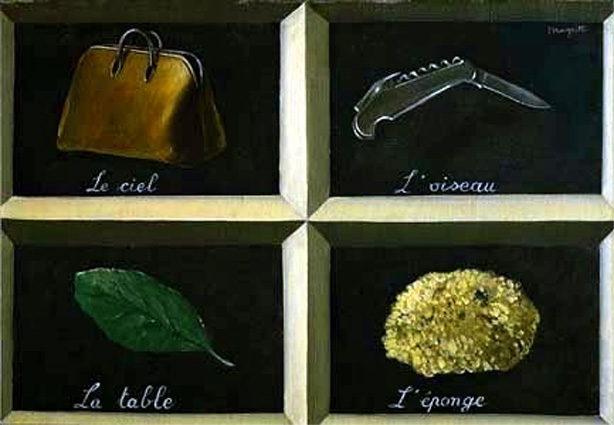
The Interpretation of Dreams I (La clef des songes)- 1927
According to David Sylvester, this was one of the first is not the first word and image painting by Magritte painted by Magritte in August 1927. He says that Table, Ocean and Fruit was probably the second. Another version of The Interpretation of Dreams-I mysteriously appeared in a 1954 exhibit and was catalogued as being painted in 1930 but Sylvester has tracked down a 1927 date.
Magritte creates one traditional way that words and images can share a frame, namely with the word as name or legend of what is also depicted in the fashion of vocabulary flash cards or early reading workbook sheets. Pierre Sterckx says they are images from the Petit Larousse. Not just an equivalence of word and thing, but an exact match is implied.
It is, as Sylvester says, a school reading primer gone wrong—but, as so often, not completely wrong, the lower right-hand cell is correct. Several other versions followed, see the six frame Interpretation of Dreams II- 1930 version below.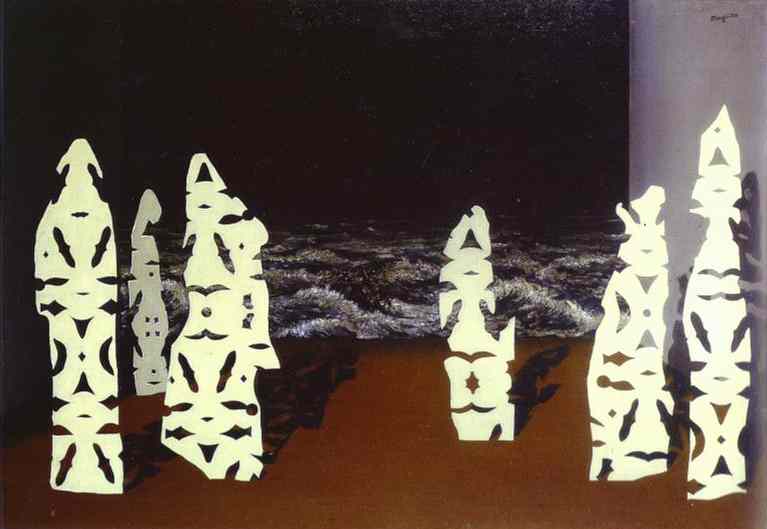
The Regalia of the Storm (La Parure de l'orage) 1927
It's difficult to see but there's a ship wrecked on the shore in the storm. The collage-like characters stand on the shore watching.
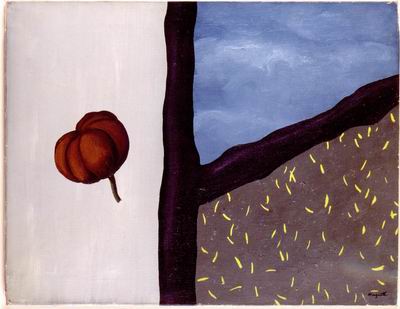
The Quandary of Painting (Les embarras de la peinture) 1927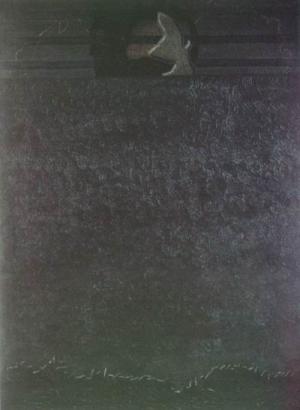
The Fruit of Dreams (Le Fruit des reves) 1927- 28.4 x 21.6 in. / 73 x 54 cm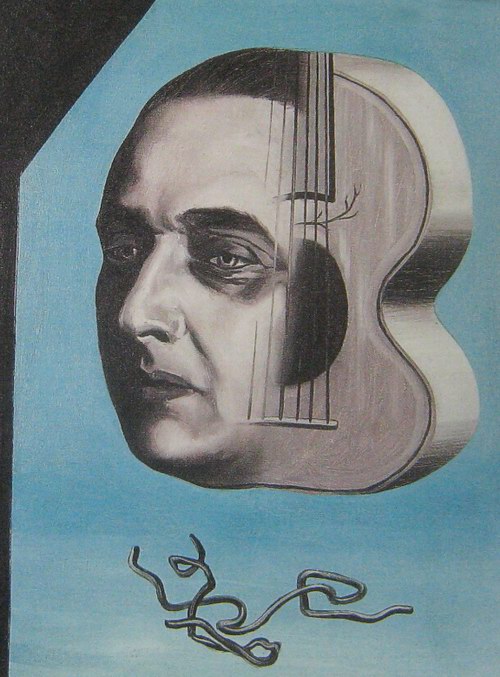
Portrait of Paul-Gustave Van Hecke 1927
By 1924 Rene Magritte was working as a design artist for Norine, run by a charismatic couple: the cultural and intellectual Paul-Gustave Van Hecke and the grande couturière Honorine “Norine” Deschrijver. They established their couture business during World War I (1918). For the first time, a Belgian couture house created its own designs instead of buying them from Paris, and offered an attractive and highly original local alternative. After the war, they became the most important couture house in the country.
Norine was a prominent representative of the Modernist movement in fashion. In fact, Van Hecke and Norine’s environment was entirely modern and was a hub of Surrealism and Expressionism: their private home, Van Hecke’s art galleries and journals and the couture house’s salons featured work by national and international contemporary artists. They firmly embedded art in fashion; this symbiosis with modern art gave their creations high art status. The couture house’s beautiful graphics were conceived by Belgian artists such as Frits Van den Berghe, Leon de Smet and—most importantly, by René Magritte.
In Van Hecke's early fiction the characters smoked expensive cigars, drank champagne and had powdered noses. In his manifesto 'Fashion' from 1922, he ranted against the long, black coat as a symbol of male Flemish backwardness. He was a close friend of ELT Mesens, Magritte's friend and eventual patron. In 1927, Mesens became the manager of Van Hecke's new gallery L'Epoque and organised the promotion of Van Hecke's magazine Variétés.
Van Hecke with his friend André De Ridder possessed the most successful avant-garde business in Belgium. It is not without reason that Flemish expressionism was already institutionalized in the 1920s. Van Hecke's propaganda machine consisted of a gallery, a magazine and a publishing house. Mesens did not feel committed to Flemish expressionism however, and the purposes and the functioning of Van Hecke's gallery alone would be the sole source of inspiration for him. 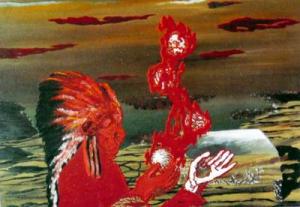
The Age of Fire (L'Age dufeu) 1927, 28.7 x 39.4 in. / 73 x 100 cm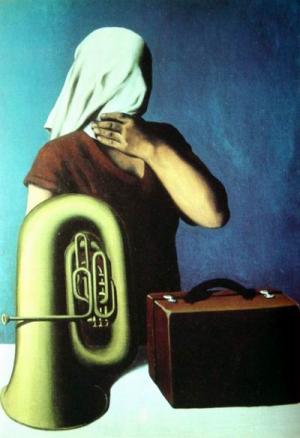
The Central Story (L'histoire centrale) (1927)
According to Sylvester this painting referes to his mother's suicide. The woman, whose face is obscured by a white cloth (also found in some of The Lovers paintings) has her left hand around her throat as if choking herself.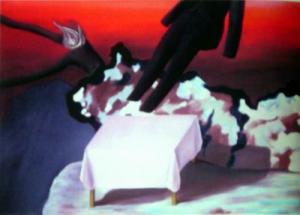
Weariness of Life aka La Fatigue devivre, 1927, 28.7 x 39.4 in. / 73 x 100 cm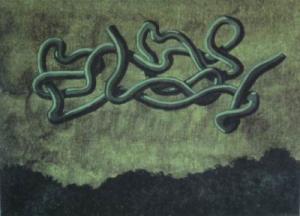
Secret of Clouds (Le Secret des nuages) 1927, 21.3 x 28.7 in. / 54 x 73 cm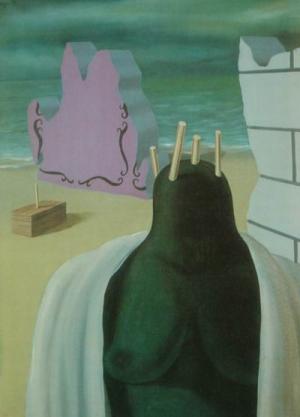
Torturing of Vestal Virgin (Le Suppfice de la vestale) 1927- 38.6 x 29.5 in.
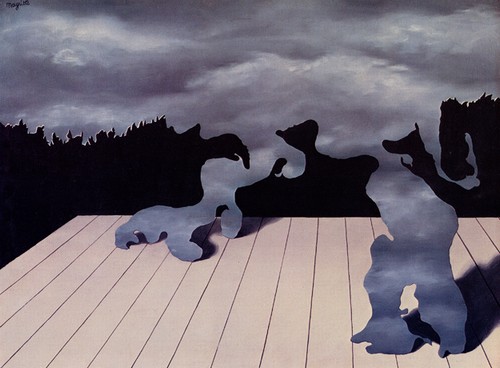
The Muscles of the Sky (Les Muscles celestes) 1927, 21.3 x 28.7 in. / 54 x 73 cm
Magritte's first painting done in Paris in 1927 Les Muscles célestes transposes 'sky' into an alternative pictorial element, the Albertian 'pavement' in this case, so a portion of sky breaks away from the far distance, crosses the black middle distance and anchors itself to the foreground. This immediately contradicts the depth that the receding pavement insistently conveys. As a result, the principal function of the pavement, to accommodate objects and to establish their recession in space, is overridden by spatial instability. Solid objects have no place in this environment and, not surprisingly, Magritte omits them altogether. The subject of the painting is the 'legs of the sky' as Magritte had put it. They hint at the characteristics of wood: they have clear-cut outlines, they cast shadows and, in all respects, conform to the idea of a rigid plane. But also, like sky, they have a furling, unspecifiable configuration. Quite unlike flat planes, they make contact with the pavement at various points in depth. In effect, they are implicit zones of 'melting', places where contradictory meanings are fused.
What is significant, moreover, is that such loci of representational contradiction, where finite plastic interpretation becomes impossible, are not rendered as an imprecise blurs or as haziness. On the contrary, they are independent entities in the painting. Les Muscles célestes presents the paradoxical constituent as a 'limb' attached to a larger corpus. Even if, one would imagine, the final severance were made and the limb allowed to exist freely, it would still have finite presence. Magritte, therefore, invokes the notion of free units of meaninglessness that, nevertheless, can inhabit a fully articulated pictorial space. It is in this way that Magritte's 'discovery' could be seen to have ultimately resulted in a transition from planes to 'blobs', a term coined by Robert Roseblum (Roseblum 16). Planes, it has been shown, had been first isolated and then fused, with the result that a paradox of 'substance' was brought about. The ensuing pictorial contradiction was then seen to lead an absence of representational meaning. Finally, the resulting state of zero representation was seen to acquire autonomy within the painting. Having reached this point in his progressive denudation of representation, Magritte is in a position to advance the concept of paintings peopled wholly by semantically dysfunctional elements. [Silvano Levy]
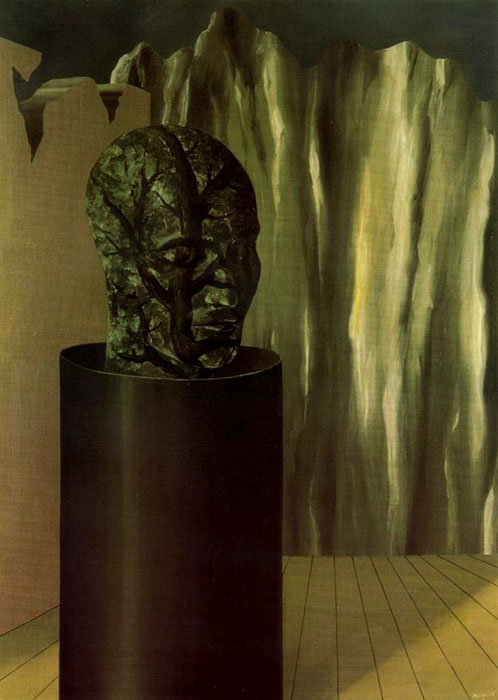
The Forest- 1927 (La foret)
The painting is of a Napoleon death mask from an earlier work. The head has veins as if it is an organ of the body. It's one of several effects he borrowed from Giorgio de Chirico. See Magritte's "Blood of the World" and De Chirico's 1914 "Span of the Black Ladders" for other examples.
The painting was purchased by Pierre Crowet who met Magritte in 1926 when Pierre was a student in Brussels. According to Pierre, "I ran into Rene Magritte from time to time (both of us being from Charleroi, we hit it off quite well). I admired his work and wanted to purchase one of his paintings but did not have any money. To help me out, he sold The Forest to me fro 500 Belgian francs payable in installments of 50 francs per month. This was my first purchase and the start of my collection." Pierre was a lifelong friend and commissioned of his wife and daughter who was the inspiration for The Ignorant Fairy which later in 1956 became the central theme for Magritte's large mural commissioned by the Musee de Charleroi with the same title.

An End To Contemplation- 1927
A collage version of An End To Contemplation was also done in 1927 (see below). This painting sues deconstruction of the image and is similar the 1926 Polar Light (La lumière du pôle). It also uses duplication of the image or as Magritte thought: "the image and the mirror image." Sylvester suggested that the image is based on the ancient stone bust of Prince Ankh-haf circa 2600 BC.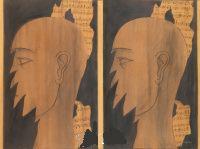
An End To Contemplation- Collage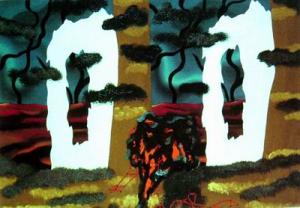
A Taste for the Invisible (Le Gout de l'invisible) 1927
A different collage version of A Taste for the Invisible was also done in 1927.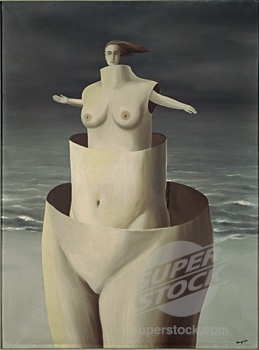
The Importance of Marvels (L'lmportance des merveilles) 1927.
This Magritte's version of Botticelli's "The Birth of Venus." Note the windblown hair and the sea waves in the background. Sylvester proposes of possible sources from the inspiration: It could be 1) based on Russian nesting dolls or 2) the figure in Max Ernst 1921 "Elephant of Celebes." It's possible Magritte may have used more than one source for his idea.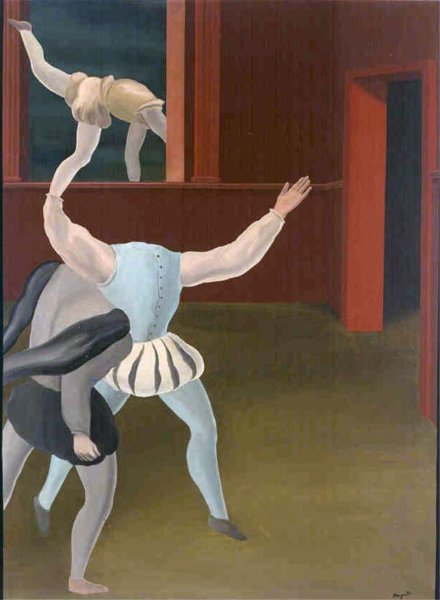
A Panic in the Middle Ages (Une Panique au Moyen-Age) 1927
This painting was taken from "The Death of Pissaro" illustration after an old print in Jules Verne, "Decouverte de la Terre" 1878.
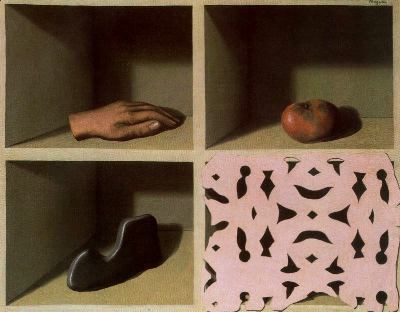
"One Night Museum" also known as Relics of the Night (Le musee d'une nuit) 1927 19 x 25 Collection Marcel Mabille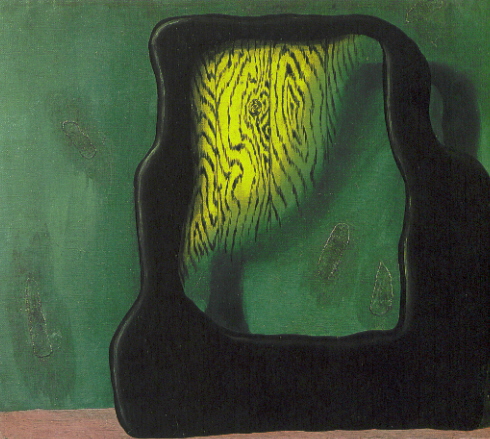
Prince of Objects (Le Prince des Objets) 1927
The mirror turns to wood or is it just a reflection? It's like one of the trick mirrors at the House of Mirrors.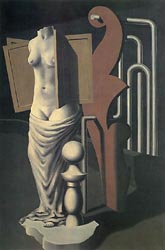
The Flying Statue (La statue volante) 1927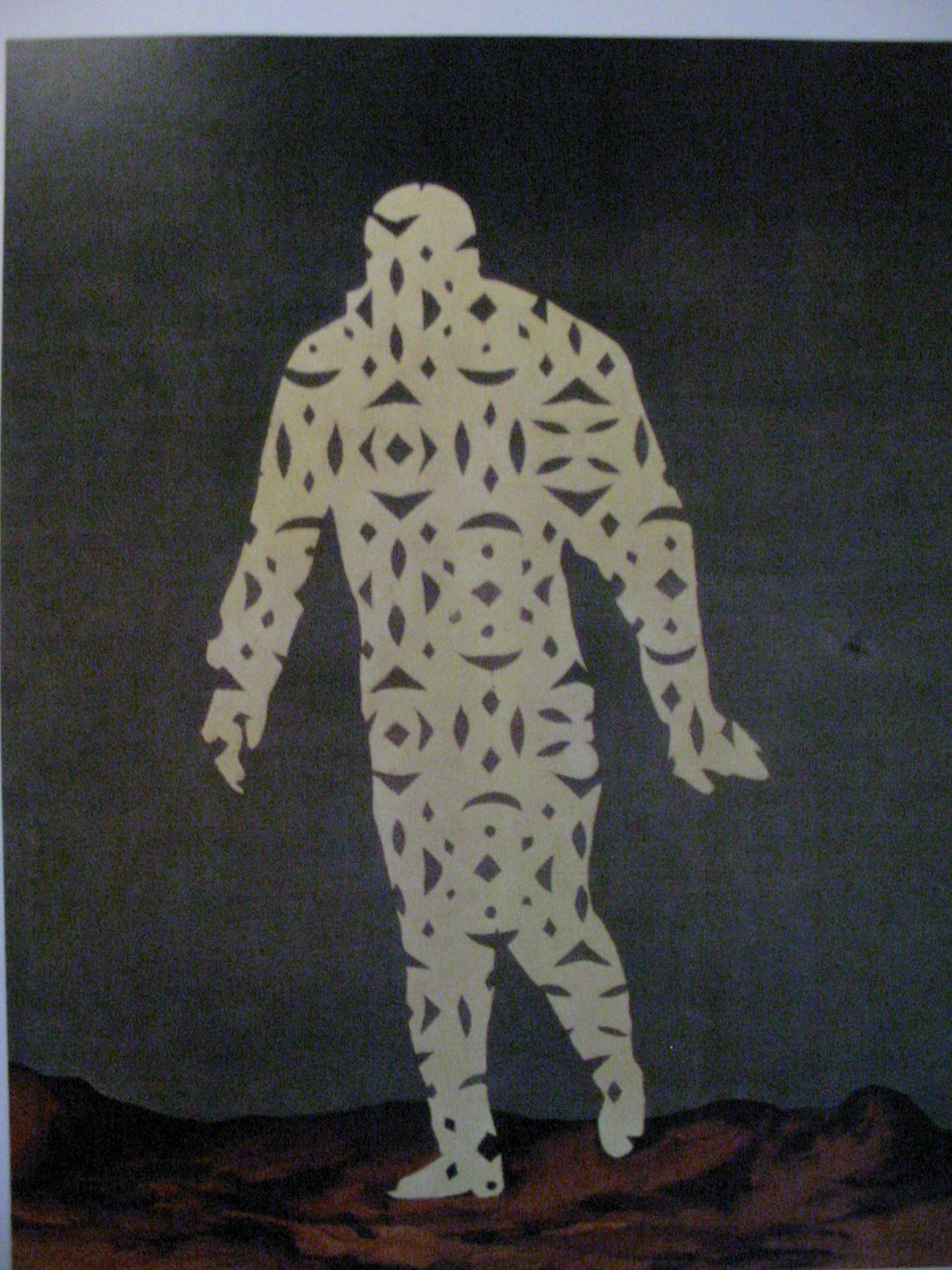
The Comic Spirit (L'espirt comique) 1927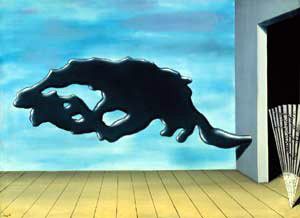
Leaving school (La sortie de L'Ecole) 1927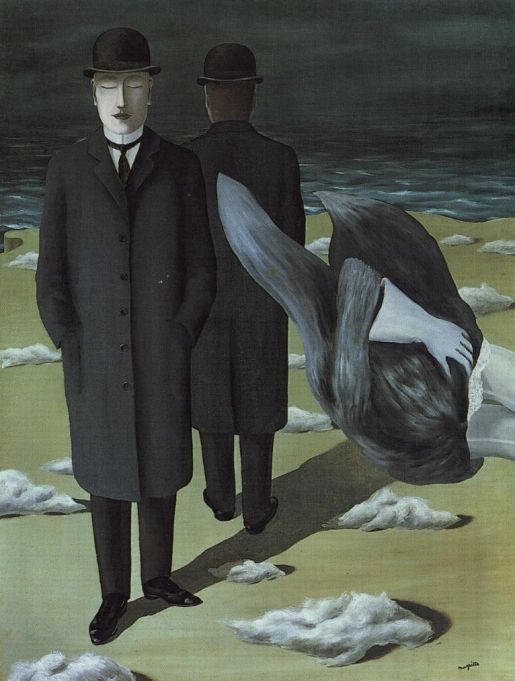
The Meaning of Night 1927
Magritte did advertising for the Samuels Fur Company in 1926 and 1927. The Meaning of night seem to be a reaction against the fur trade; the two men (representing the company executives) stand blindly beside a mannequin wearing a fur coat that's coming alive as if to exert some amount of revenge upon the men.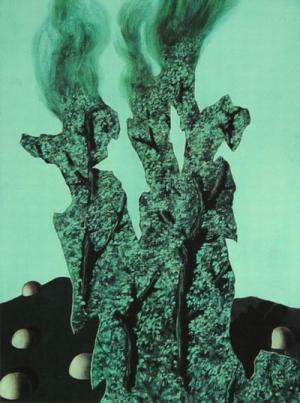
Countryside II (Campagne II)- 1927
Magritte did a series of Countryside paintings in 1927.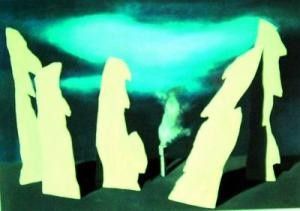
The Secret Walkers (The Secret Procession) Le Secret du Cortège 1927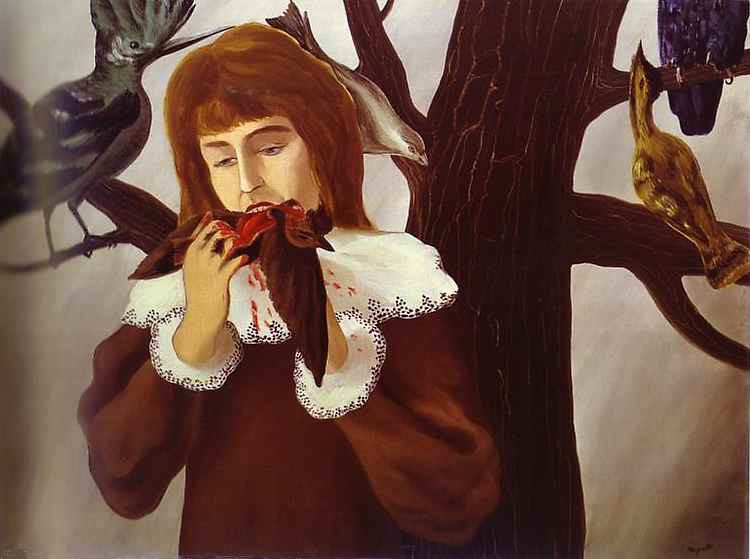
Young girl Eating a Bird- The Pleasure (Jeune fille mangeant un oiseau- Le Plaisir) 1927
Wiki says this painting was started in 1925 and calls it Young Girl Eating a Bird- The Oasis. Certainly it is the most gruesome painting Magritte ever did. It's a companion piece to The Murderous Sky (immediately below) depicting four identical bloody dying birds flying in front of a mountain of rocks. Sylvester says Girl Eating Bird was completed weeks after the Threatend Muderer (Menaced Assassin). According to other sources the explanation behind this painting is rather simple: One day Magritte saw his wife eating a chocolate bird, so he decided he would do a painting of a young woman eating a live bird. Evidently he decided not to use an accurate portrait of Georgette because of the graphic nature of the subject material.
David Sylvester suggestes that this painting might be scripted (based) on a poem by Paul Nouge which was written about at the same in 1927 (published in 1956). It's possible that the poem could also be based on the painting.
Poem by Paul Nouge, "The Girl Who Ate Birds": We find her in the heart of summer, in the shadow of a sturdy tree thronged with calmed birds unalarmed by her presence. He schoolgirl demeanor would be excuse enough, and her modesdt dress, her neat hair... It is then thatone notices the pallor of joy, the eyelids closed over the cruelty of her dreams, the teeth pressed to the blood-stained lips, the woman engrossed in her pleasure and savoring, through the caress of its plummage, a ceature docile to the point of continuing to live. Since one has to hold one's own, one invents, as an afterthought, the girl who ate birds."
If the painting is based on Nouge's poem perhaps Magritte wouldn't want this information public. Rene usually avoiding interpreting his paintings preferring to keep his mysteries intact.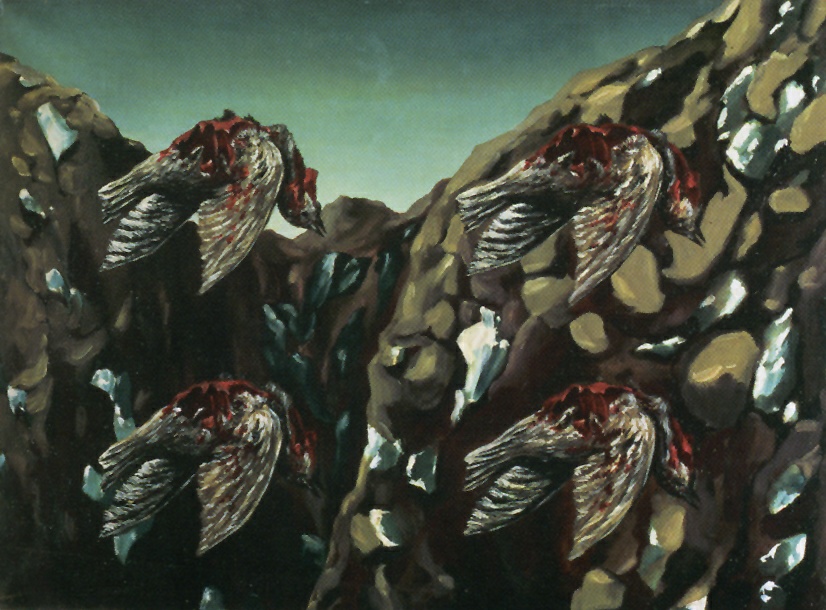
The Murderous Sky (Le ciel meutier) 1927
Magritte used duplication (repeated images) as a technique and in 1927 also painted Foolhardy (see below). He later commented on his use of multiple images as a form of using refections of the primary object to evoke mystery.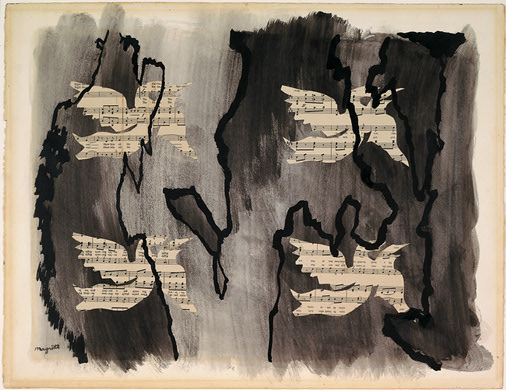
The Murderous Sky- Collage (Le ciel meutier) 1927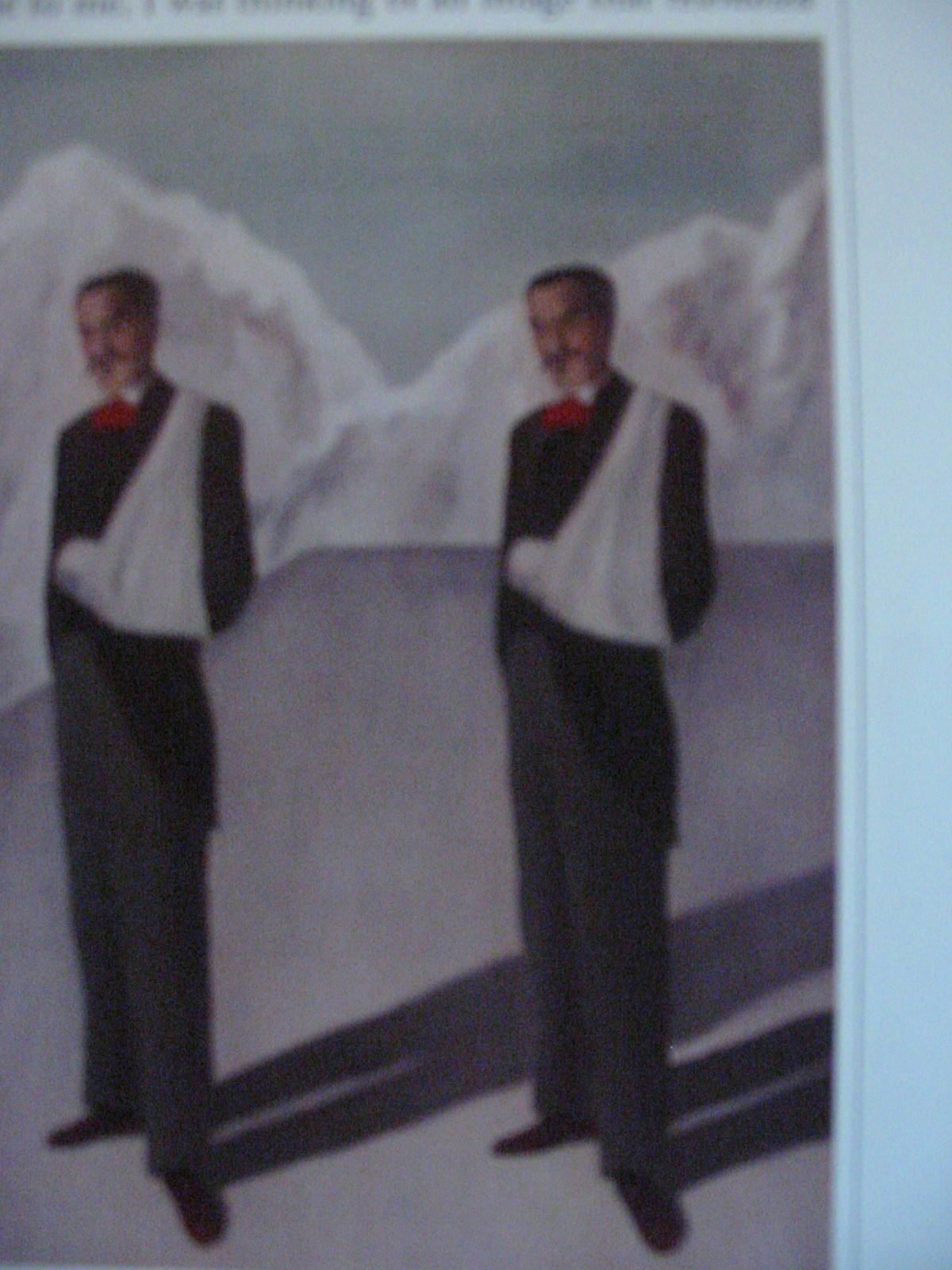
Foolhardy (L'imprudent) 1927
Dispite the poor quality of the image, it's easy to see the exact duplicate (reflection) of a man with a moustache with his arm in a sling. About the painting Magritte commented, " When the ideas for Foolhardy came to me, I was thinking of an image that resembled a person with his arm in a sling beside his reflection as a reflection in a (non-distorting ) mirror, This person and his reflection are standing on a terrace, beyond which a mountain and sky delimit the field of vision. This is exactly what I visualized and it enabled me to paint Foolhardy. If I had to interpret this image I would say that the appearance of the figure acquires its charge of mystery when it is accompanied by its reflection. The fact that a figure that appeaars does not evoke the elelment of mystery when its appearance alone is presented. The figure found in Foolhardy if it were alone, would be reduced to something peticular- a slightly comic person. Alone it would not evoke what it has in common with every other person, that is to say: their mystery." [Sylvester 66-67]
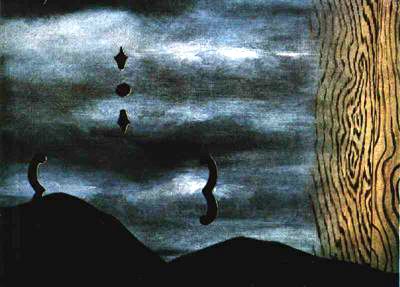
The Lining of Sleep (La doublure du sommeil)- 1927 oil on canvas 50 x 65 cm
Magritte used images morphing in wooden objects, in this painting it's the sky. The mysterious cut-out images resemble the cut-out sound holes of musical stringed instruments like the violin.
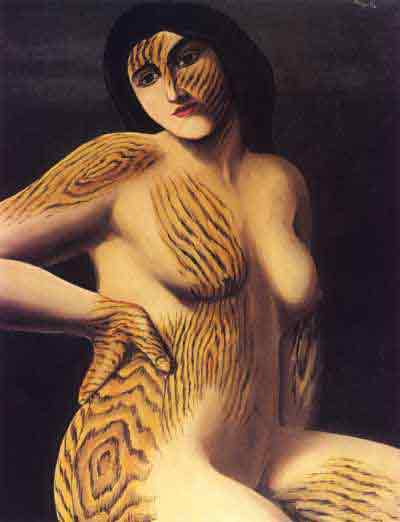
Discovery- 1927
In 1927 Magritte painted "Discovery" depicting a female nude whose skin has morphed into wood grain. Attributing human characteristics to animals, and objects is called “anthropomorphism.”
A Passion for Light 1927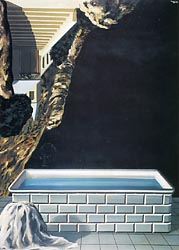
Atlantis (L'Atlantide) 1927
Magritte uses the reversed viewpoint in Atlantis (L'Allantide, 1927) which the painted architecture of the staircase in the upper left-hand upside-down. This image of a dome of draped cloth that looks as if it is covering an object made its first appearance in mid-1927 in this mysterious work. Also depicted is 'the mysterious void' a dark black on the right side similar to the 1928 Voice of Silence. 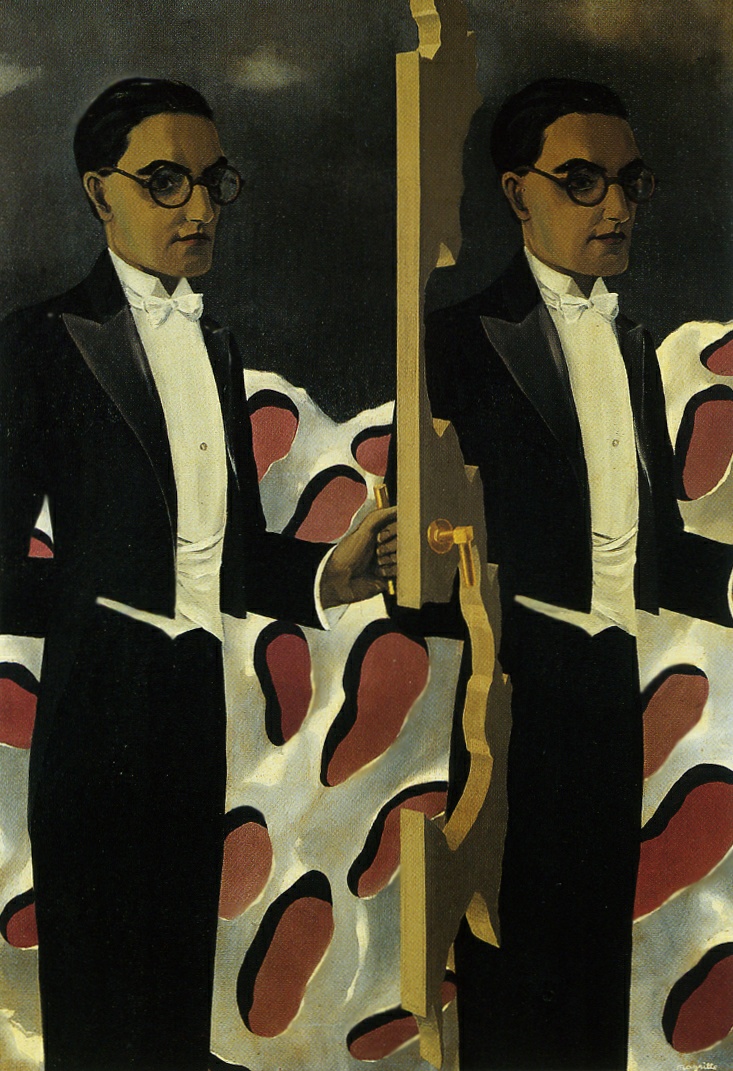
Portrait of Paul Nouge 1927
Poet Paul Nouge was the philosophical leader of the Belgian Surrealist group. In 1926 and 1927 Magritte and Nouge worked closely on two illustrated catalogues for the furrier Samuel.
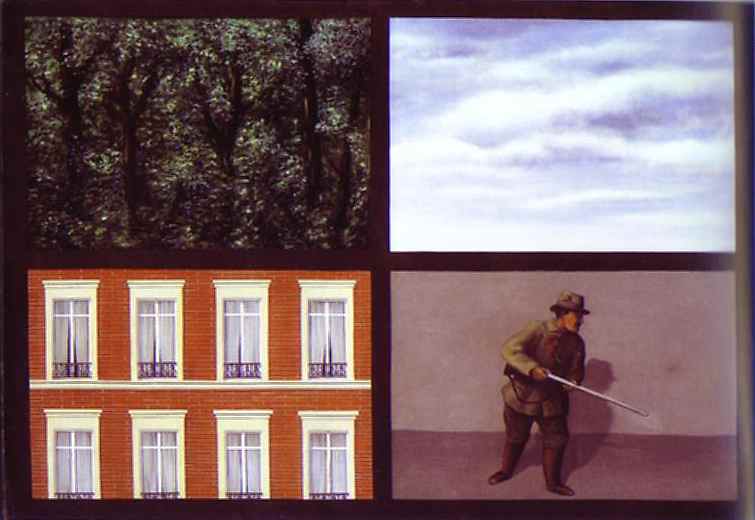
"The Obsession" also "The Fixed Idea" (L' Idee fixe) 1927 Oil on canvas, 31'/4x45'/4"
The Fixed Idea (1927) is similar to the two Empty Mask paintings done in 1928. It's a more rectilinear one that does have a human figure in it in place of the patterned cutout:
The figure of a hunter does alter the mix, but the representation of him is as stylized as it would be for a playing card and, like all the assemblies, the figure is placed a foot or so in front of a blank wall illuminated from over the viewer's left shoulder and with low horizon line. These bits of surfaces, even the hunter, begin to look like tokens in some game we don't know the rules for, or samples of "background" images for Web pages. They could all be made to tile very nicely. (Magritte made his living designing wallpaper at one time.) These images are all very flat even though framed, and framing suggests a window being looked into. This is one of the ways Magritte "paints representation." The purpose of the array is not to present alternatives for us to choose our favorite from (like a book of wallpaper samples) but to make them equivalent; so they are pages from the sample book of representation through resemblance. To be sure, not all the wallpapers resemble some general and familiar thing: the harness bells on corrugated galvanized sheet metal are hardly a common figure of daily life. It is one more instance of Margritte's asymmetry: so often his sets include one member that looks like the other members of the set but is not.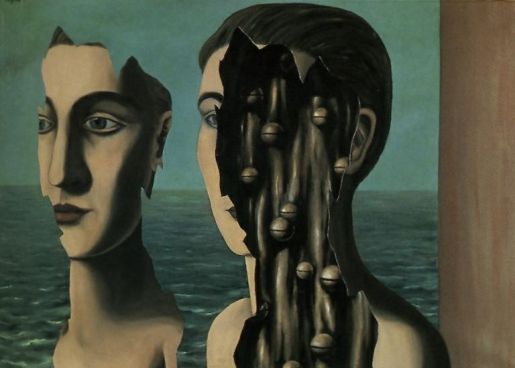
The Double Secret (Le double secret) 1927
Another way Magitte destructs the image is by removing part of it and placing the removed part entact in another area- much like taking a piece of puzzle up and moving it. This is easy to do in our computer age. The underlying area is mechanical, much like the Silvery Chasm 1926 (see above) with the inconic images of bells.
Intermission, 1927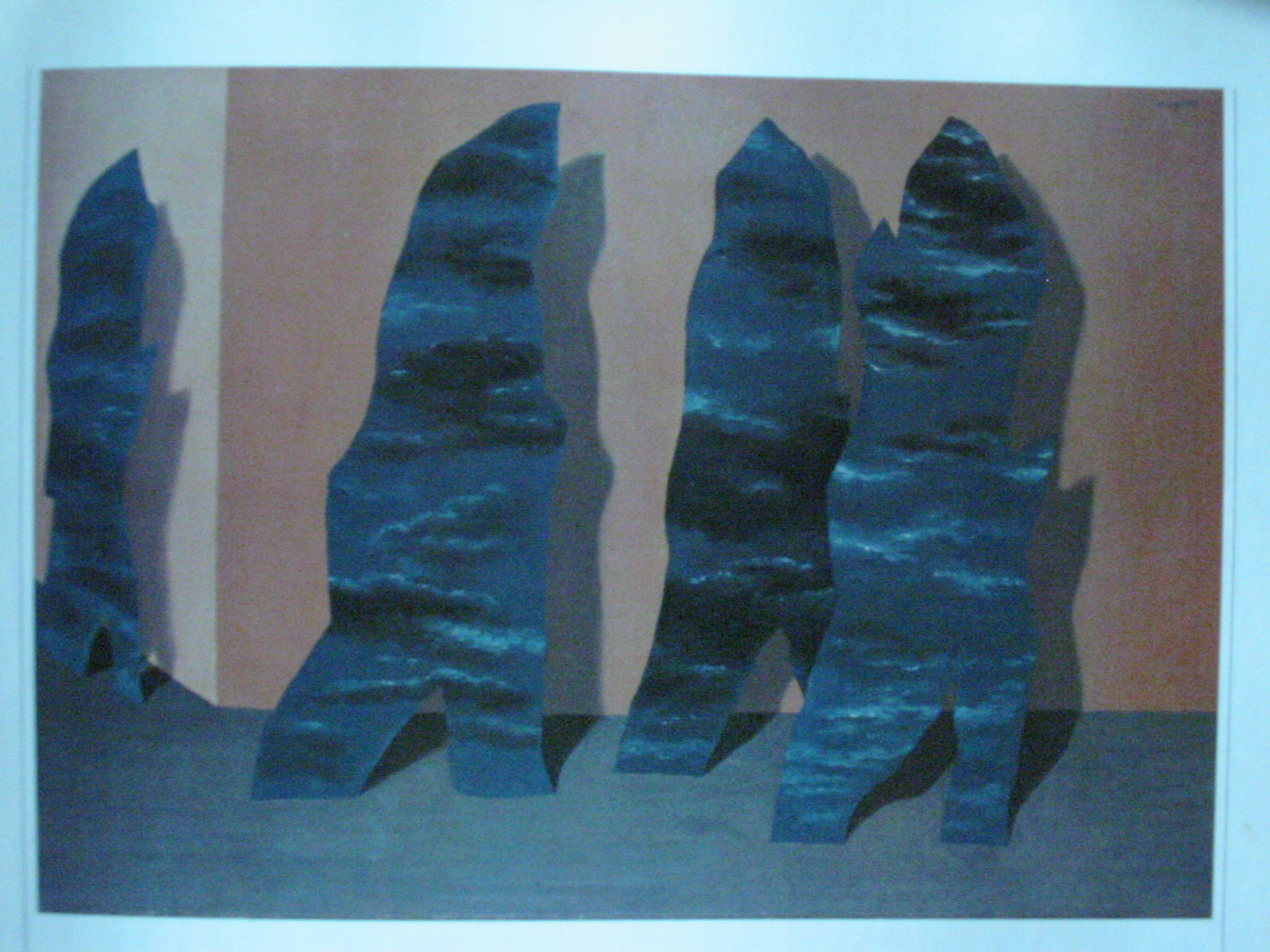
Figures of Night, 1927 oil
This is similar to Muscles of the Night. Muscles was one of the first paintings done when Magritte moved to Paris in 1927. Figures of Night also features cutout figures of the night sky.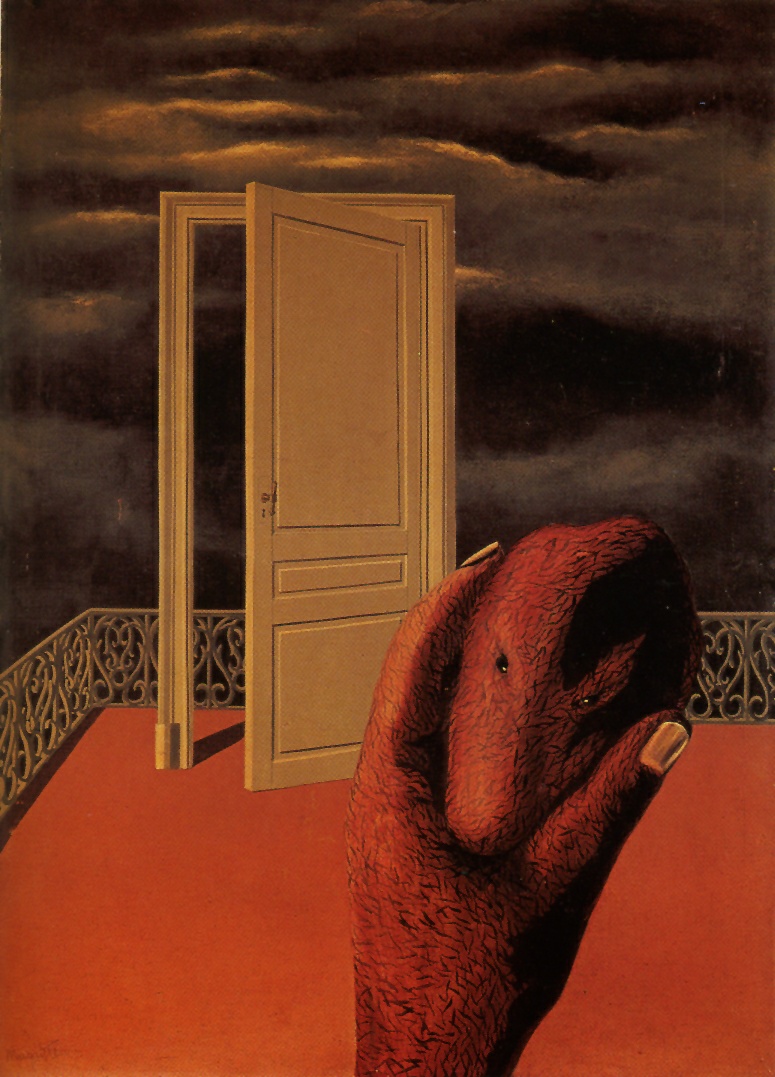
Scars of Memory (Les Cicatrices de la memoire) 1927 size 28.7 x 21.3 in. / 73 x 54 cm
This is one of first uses of "the door" as an iconic/symbolic image found in Magritte's paintings. Magritte was probably familiar to Marcel Duchamps, "The Door" on Readymades (the use of real objects as art). The most prominent example of Duchamp's association with Dada was his submission of Fountain, a urinal, to the Society of Independent Artists exhibit in 1917. Duchamp's door was a real door that he had a carpenter make. See Magritte's many othe "door" painting like "The Victory."
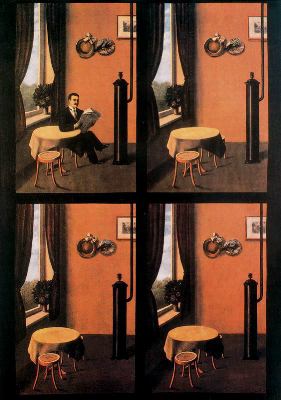
The Man with Newspaper (L'Homme au journal) 1927 Oil on canvas 1156 x 813 mm frame: 1279 x 940 x 75 mm
Magritte’s disconcertingly dead-pan style is seen clearly in these four simply-painted scenes, which seem to be indistinguishable apart from the disappearance of the man of the title. They suggest a subverted comic-strip and, indeed, were based on an illustration in a popular health manual. There are slight changes of perspective between the four panels, which add to the disquieting effect, and may relate to the displacement of images in early 3-D viewing devices. This subtle undermining of the everyday was characteristic of Magritte and his Belgian Surrealist colleagues, who preferred quiet subversion to overt public action.
This painting uses duplication or replication (repeated images). In this case there are four identical panels but only one has the man with the newspaper. Magritte was fond of repeating images usually as a reflection (exact duplication) of the image.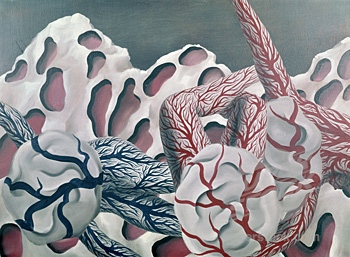
The Blood of the World (Le sang du monde) 1927 oil
Magritte uses the same backround here and in his Portrait of Paul Nouge. The human figures twisting legs and arms reveal their veins a technique Magritte used in other paintings that he probably learned from De Chirico.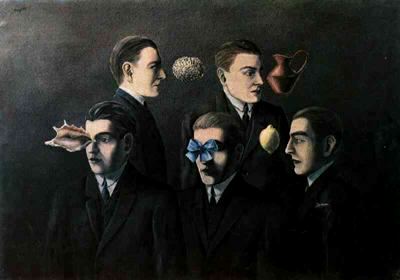
The Familiar Objects 1927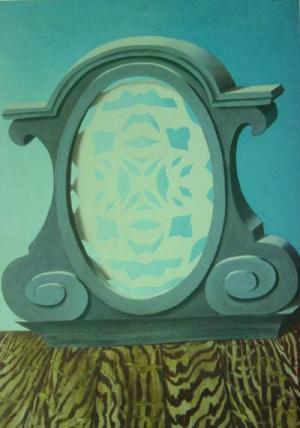
The End of Time, La Fin du temp, 1927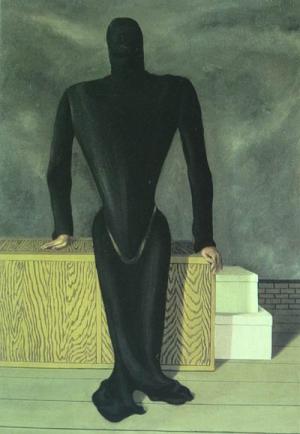
The Female Thief (La Voleuse) 1927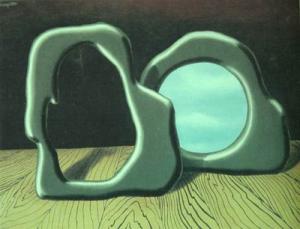
The Light-Breaker (Le Brise-lumière) 1927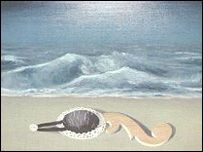
Reflections of Time (Les Reflets du Temps) 1927
In 2006 Reflections of Time was stolen from its storage place in south London. Scotland Yard recovered the painting a year later. Curiously a different painting, done in 1927, has the same title.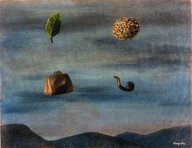
The Future of Voices 1927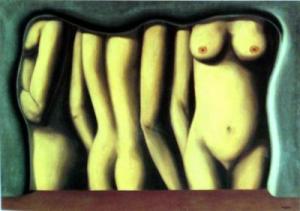
Adulation of Space (L'Eloge de t'espace) 1927-1928, 31.9 x 45.7 in. / 81 x 116 cm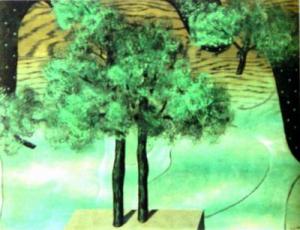
The cultivation of Ideas (La Culture des idees) 1927
La Culture des idees features two tree trunks that resemble a person standing at the edge of a platform.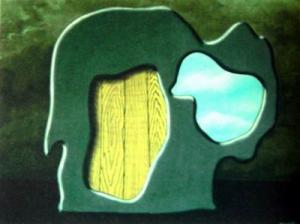
The Travel Season 1927
In 1927 Magritte did a series of cut-out piece containing small pictures. The next two paintings have similar concepts.
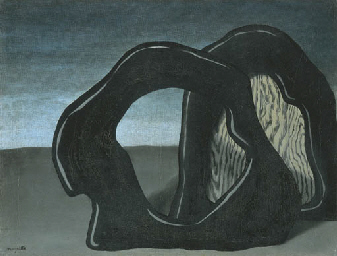
The Face Eternal (En Face des Murmurs) 1927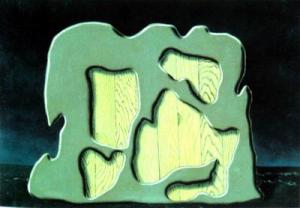
The Imp of the Perverse- 1927
The Imp of the Perverse is a metaphor for the common tendency, particularly among children and miscreants, to do exactly the wrong thing in a given situation. The conceit is that the misbehavior is due to an imp (a small demon) leading an otherwise decent person into mischief. The phrase has a long history in literature, and was popularized (and perhaps coined) by Edgar Allan Poe in his short story, "The Imp of the Perverse".
We have a task before us which must be speedily performed. We know that it will be ruinous to make delay. The most important crisis of our life calls, trumpet-tongued, for immediate energy and action. ... It must, it shall be undertaken to-day, and yet we put it off until to-morrow, and why? There is no answer, except that we feel perverse, using the word with no comprehension of the principle. ... [Then] The clock strikes, and is the knell of our welfare. At the same time, it is the chanticleer-note to the ghost that has so long overawed us. It flies - it disappears - we are free. The old energy returns. We will labor now. Alas, it is too late!
The Imp of the Perverse is also exemplified in The Bad Glazier, a prose poem by Charles Baudelaire. Magritte was also a reader of Baudelaire.
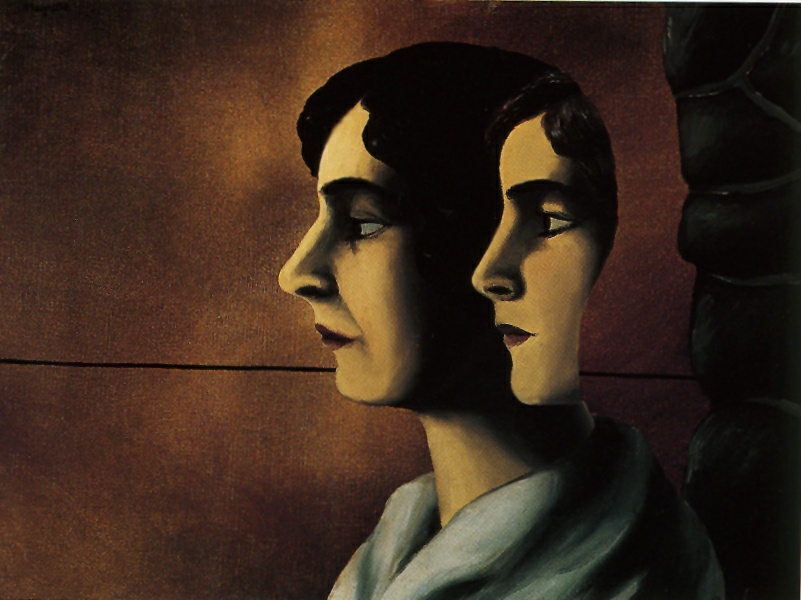
Faraway Looks (Les Regards perdus) 1927-1928, 19.7 x 23.6 in. / 50 x 65 cm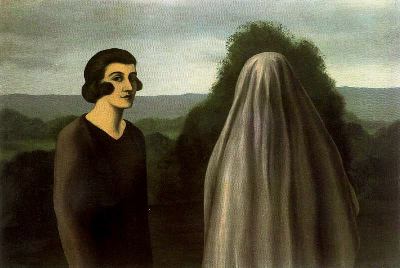
L'invention de la vie (The Invention of Life) 1928
Rene Magritte, in his 1928 painting L’invention de la vie (The Invention of Life), gives visual form to the notions of life and death. Using two female figures set in a somber landscape, one shrouded in gray fabric as the other eerily stares out at the viewer, Magritte evokes the very fragility of human life. As it has been noted that the female figure resembles the artist’s mother, who committed suicide when Magritte was a boy, this work may conjure Magritte’s own struggles with the death of his mother.
In Robert Gober’s sculptures Disappearing Sink, 1986 and Two Doors, 1989, the domestic landscape is exposed to reveal the ambiguities of everyday household objects and how one’s own memories are projected onto inanimate objects. By positioning objects such as doors and sinks out of context and stripping them of their ordinary functions, Gober challenges their familiarity, allowing them to act as a conduit to deeper psychological reservoirs. In a similar manner, a rare sculpture by Vija Celmins, from 1969-70, entitled Pencil is a six-foot long, artist’s pencil. By shifting the scale, a particularly surrealist technique, the ordinariness of a pencil is subverted, and the meaning of the object bizarrely displaced. The artist’s very own tool becomes a vehicle for self-portraiture.
In the 1963 sculpture Briques, Marcel Broodthaers crafts familiar objects such as bricks out of foam, stacking them on a wooden shelf complete with a bricklayer’s mortar tool. The physical relationship of his objects symbolizes their practical usage, but the strange situational context, void of any recognizable purpose, signals a deeper investigation of the thing itself.
The nightmarish landscape painting Aux Antipodes du Paysage, 1936 by Max Ernst, depicts a sublimely exotic netherworld. The reference to the term “antipodes”, which means ‘two places that are at opposite sides of the world’ or ‘diametrically opposed’, displays Ernst’s life-long interest in the unification of the conscious and unconscious side of the human psyche, a key proponent in the Surrealist Manifesto. Jardin Gobe Avions, 1935, combines irrational juxtapositions of splayed airplane wings and anthropomorphic decorative floral motifs in a stylized desert setting.
The human body, and especially the female body, was a central subject throughout Surrealism. Hans Bellmer’s use of the female anatomy in his perverse adolescent doll sculptures of the 1920s and 30s, where naturalistic body parts are reassembled in unnaturalistic forms, reveals many of the Surrealists’ libidinal preoccupations with death and eroticism. In the work Doll, 1936 (cast in1965), the female body has been reduced to a dismembered torso with several genital areas, whose only potential function is sexual.
Louise Bourgeois’ 1968 work Fillette (Sweeter Version) consists of a phallic object crossed with the textures and colors of a slab of raw meat, suspended from the ceiling. Mixing female and male elements, breasts and penis, the androgynous nature of the work hints to more universal ideas, namely the passive and active, yet complementary, components of the individual. Similarly, Robert Gober’s Untitled, 1990, is a wax torso that is both male and female. Whereas Bourgeois seeks to disclose a symbolic harmony, Gober sets out to disrupt our normal visual associations, skewing our perception of the human body by morphing both sexes.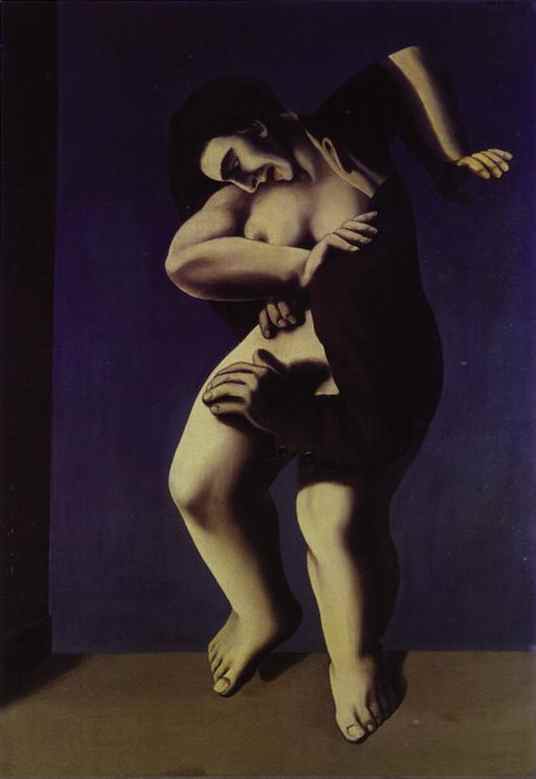
The Titanic Days (Les Jours gigantesques) 1928
Titanic Days shows a nude woman struggling with a male attacker who exists only within the contours of her own body. Originally titled "Fear of Love (Le Peur D'Amour)" it was first a 1928 drawing titled "L'Aube desarmee" (Defenseless Dawn). Ellen Handler Spitz suggests this is the primal conflict between mother and father over sex that the man controls but the female tolerates and overcomes. It's certainly one of Magritte's most violent paintings depicting male aggression visable only in the female form. This is what Magritte wrote about the painting (letter to Lecomte):
"I've treated this subject, the terror that grips the woman, by means of a subterfuge, a reversal of all the laws of space, which serves to produce a quite different effect from what this subject usually creates. The man seizes the woman he is in the foreground, so he necessarily conceals a part of the woman, the part where he is in front of her, between her and our vision. But the novelty consists of the fact that the man doesn't overlap the coutours of the woman."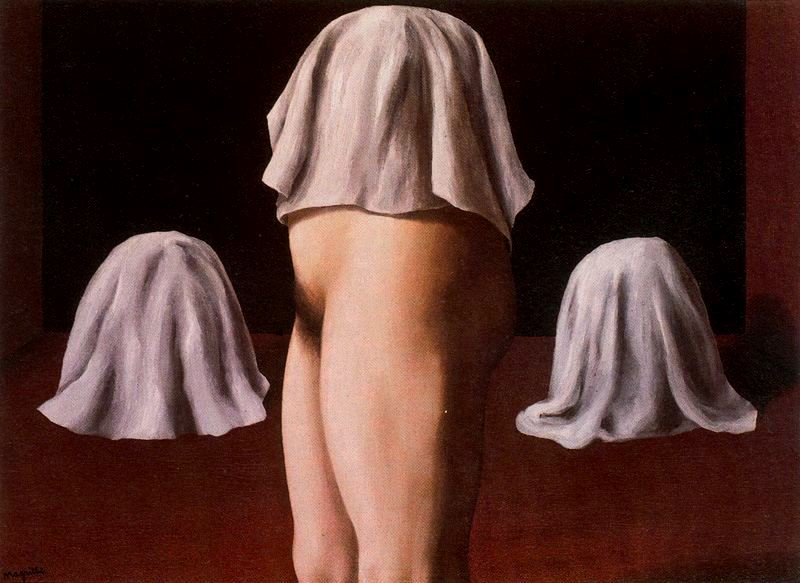
Symmetrical Trick (La Ruse symemaue) 1928, 21.3 x 28.7 in. / 54 x 73 cm
This painting features the famous white sheets that hide people and objects, obscuring the view. Here, it's almost like the shell game- under which sheet is the naked woman?

Green Night (La Nuit verte) 1928, 21.3 x 28.7 in. / 54 x 73 cm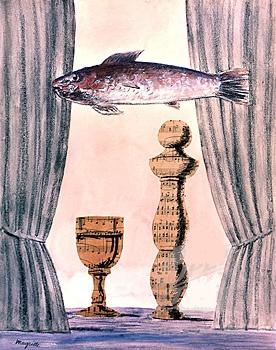
The Spirit and Form (L'Esprit et la Forme) 1928 Collage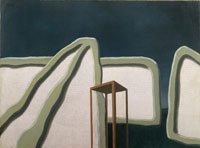
The Prisoner (Le Prisonnier) 1928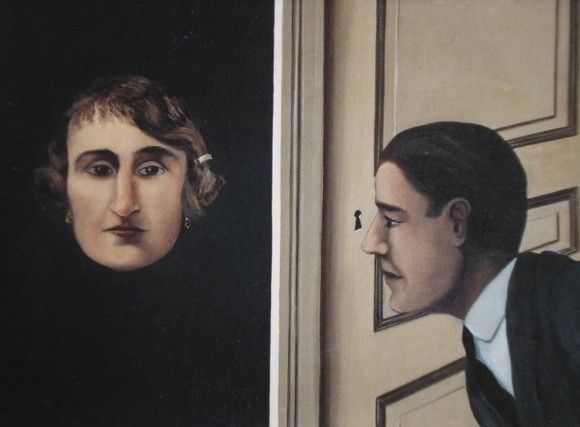
The Spy 1928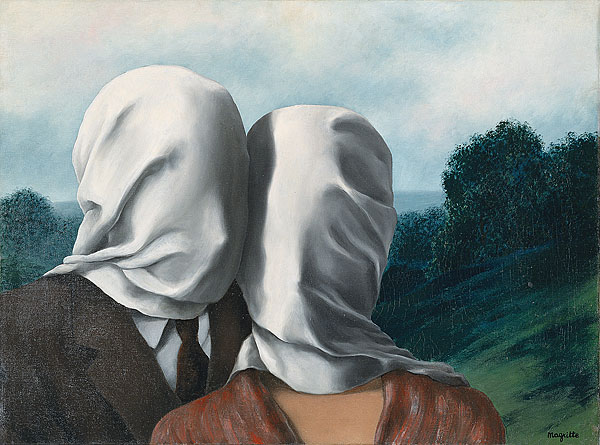
The Lovers I (Les amants) 1928 Oil on canvas 54 x 73 cm
Much has been written about the Lovers relating the sheets covering the lovers' faces to the the nightgown found covering the face of Magritte's mother after she was found drowned in the Sambre River when Rene was 13 years old. Although this may be an unconscious icon for Rene, his main interest is coving up the face to make the knowable- unknowable. He uses a number of images to cover faces including flowers, birds and apples. It makes the viewer yearn to see what is behind the object, and gives the object or person... mystery.
David Sylvester proposes that Magritte might have also copied the idea from a Nick Carter Detective magazine (similar to comic book) where the dying hereoine mysteriously has her head covered with a sheet (it's featured on the cover of a magazine- Sylvester p. 20). Magritte, a big fan of detective novels and Fantomas, wrote an article about Nick Carter.
Below are different versions of The Lovers: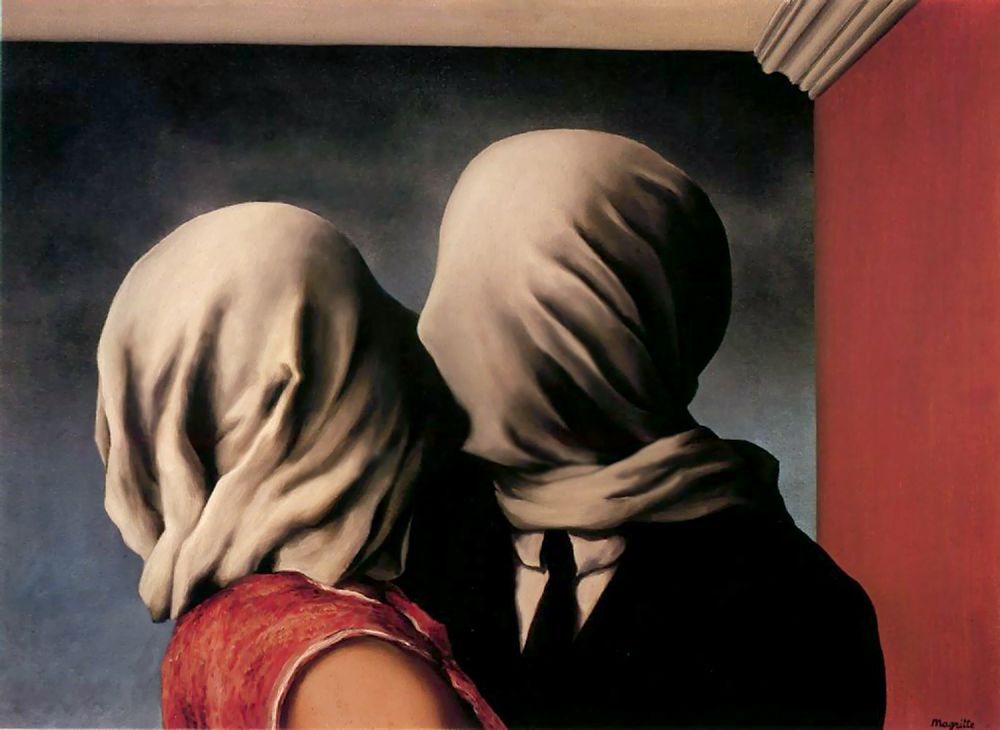
The Lovers II (Les amants)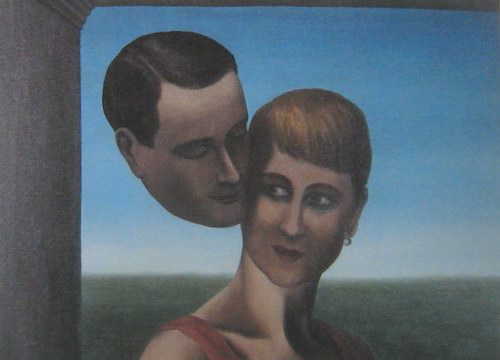
The Lovers III (Les amants) 1928
Instead of covering up Magritte does the opposite, he removes or makes invisible the body of one lover.
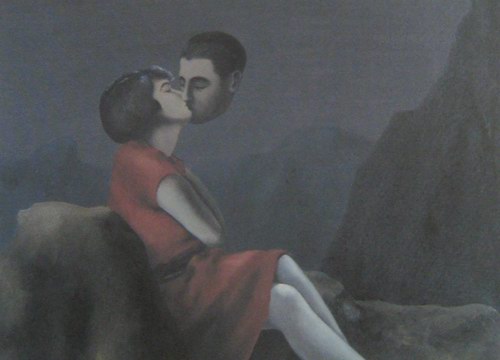
The Lovers IV (Les amants)
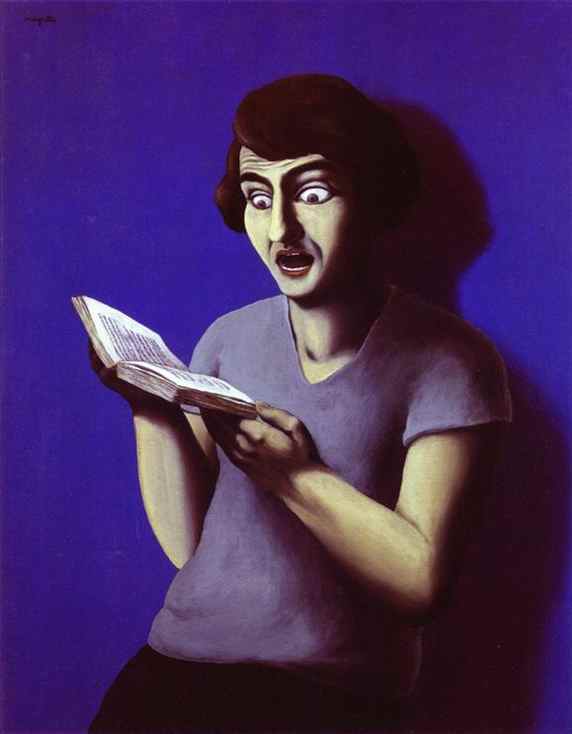
La Lectrice Soumise- The Submissive Reader - 1928
Magritte painted this oil on canvas in 1928. He based the image on a postcard that he had seen, a common source of inspiration for many Surrealists, like Dali and Eluard. This is suppossed to represent a woman who is shocked by the suppossedly erotic novel that she is reading.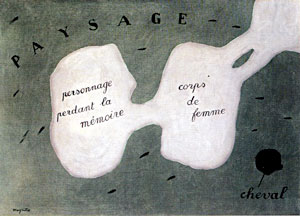
The Lost World I- 1928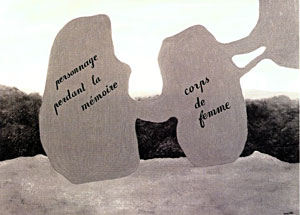
The Lost World II- 1928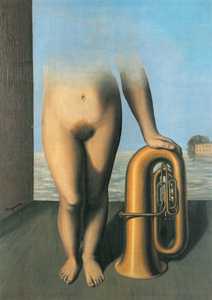
The Flood (L'Inondation) 1928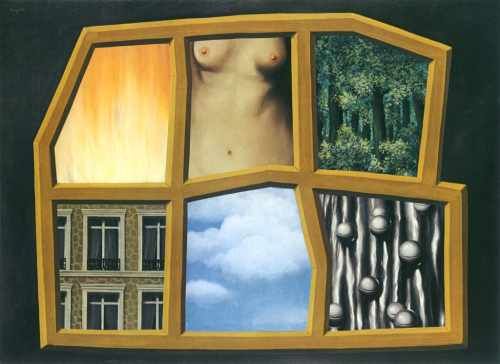
The Six Elements 1928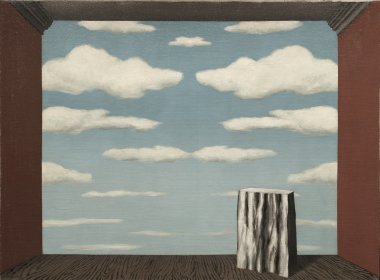
The Secret Life I- 1928
The Secret Life II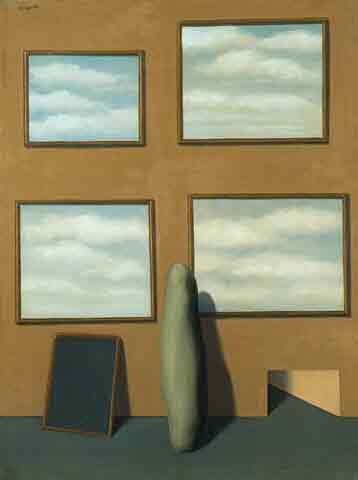
The Secret Life III
This painting, titled The Secret Life is the precusor to Magritte's individual panels of related paintings as found in the 1930 "Eternally Obvious" and "The Depts of the Earth."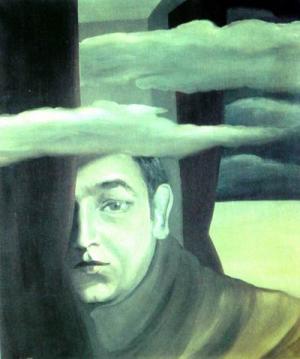
Portait of Paul Max- 1927-1928
Paul Max was associated with Magritte as one his brother Paul's musical friends. Rene illustrated Magritte's Blues with music by his brother and others. Paul Max was mentioned in the program.
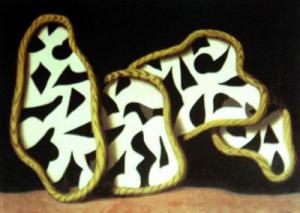
Magic Light (La Lumiere magique) 1928 Oil on Canvas 21.3 x 28.7 in. / 54 x 73 cm
A variation of the words on panel, in this painting Magritte presents four panels with abstract design. Two of the panels mysteriously float in the air.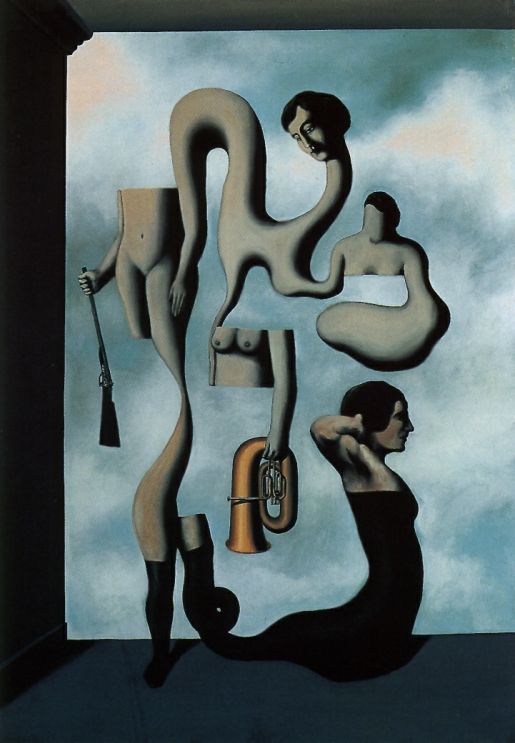
The Acrobat's Ideas 1928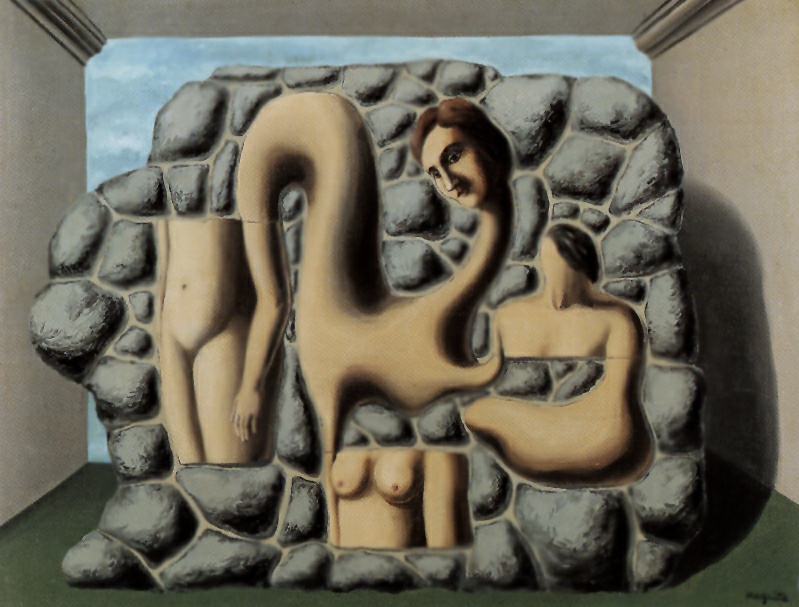
The Acrobat's Rest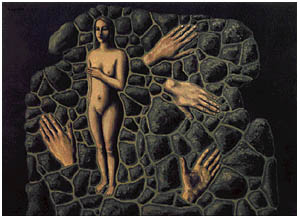
The Elusive Woman (La Femme Introuvable) 1928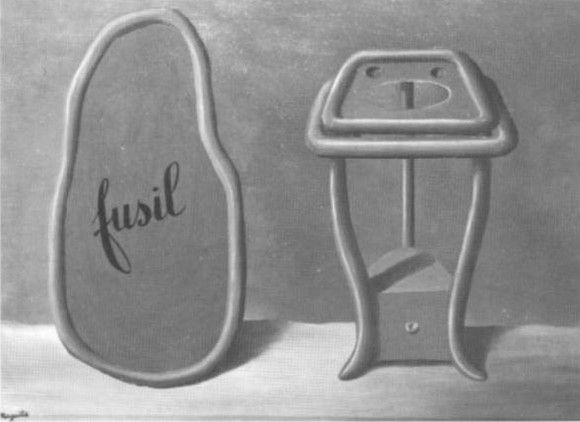
The Two (Le Duo) 1928
The Voice of Silence (La Voix dusilence) 1928, 21.3 x 28.7 in. / 54 x 73 cm
One of Magritte's early masterpieces the painting is one of his early depictions of the "mysterious void." The entire left half of thr painting is engulfed in total darkness. The silence is deafening!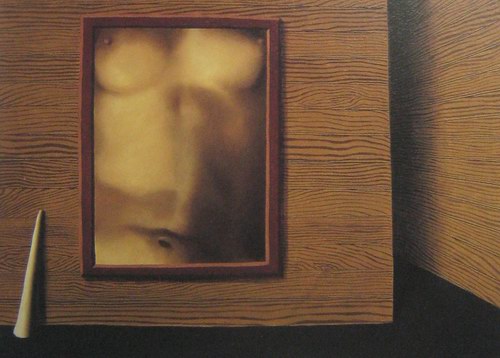
The Courtesians Palace-1928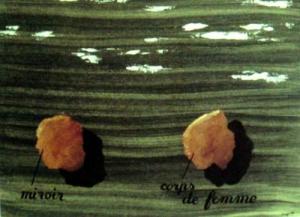
Use of Speech (L' Usage de la parole) 1928, 21.3 x 28.7 in. / 54 x 73 cm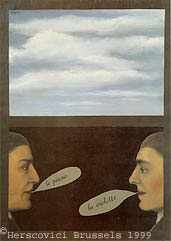
Use of Speech II (L' Usage de la parole) 1928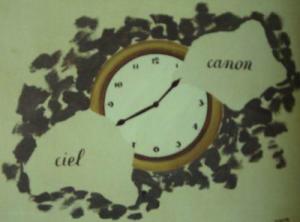
Reflections of Time (Les Reflets du temps) 1928, 21.3 x 28.7 in. / 54 x 73 cm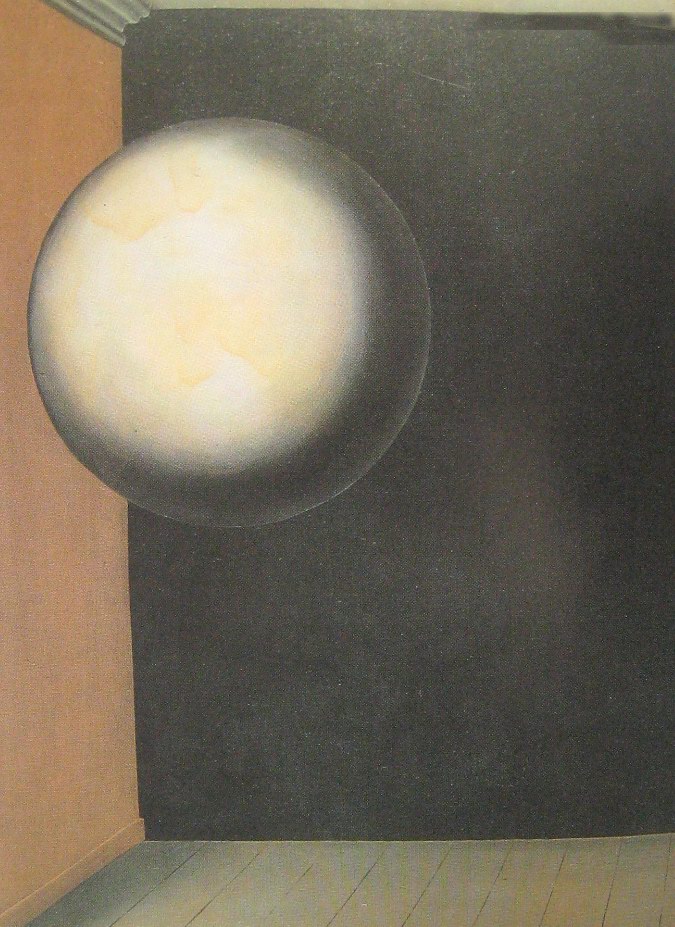
The Secret Life II- 1928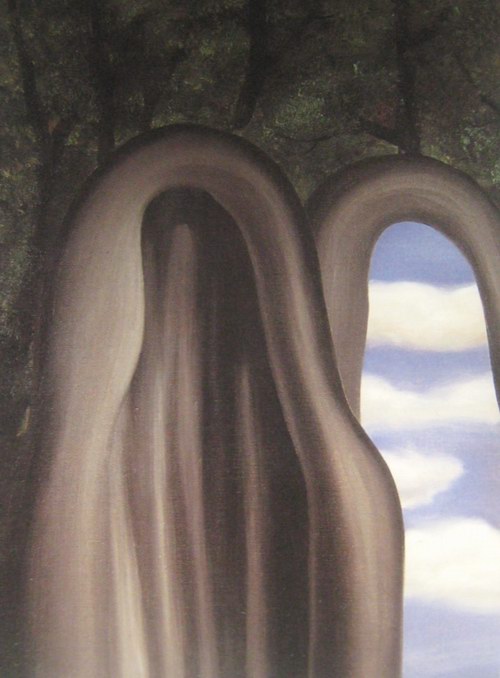
Palace with Curtains I- 1928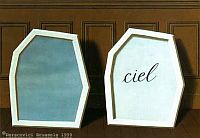
Palace with Curtains II- 1928-1929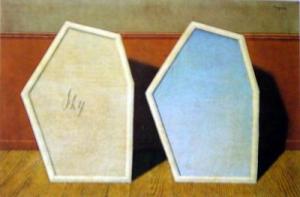
Palace of the Curtains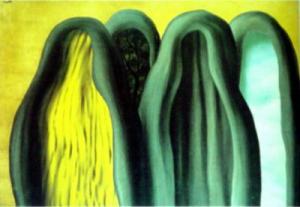
Palace of the Curtains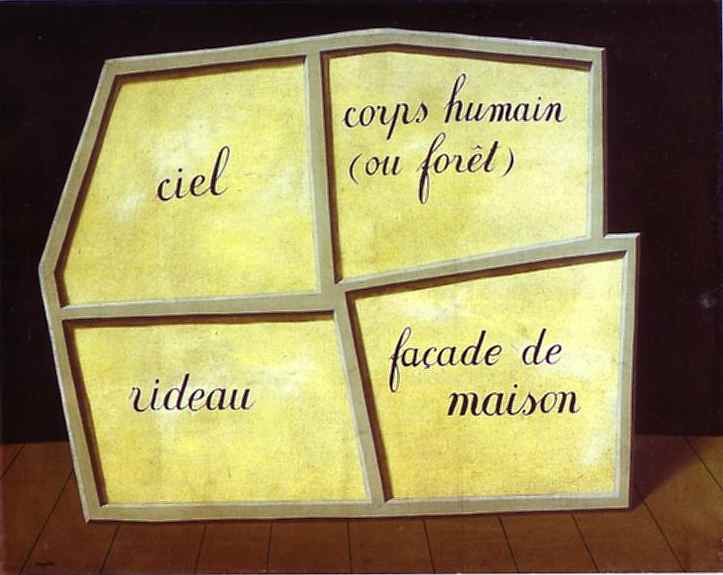
The Empty Mask I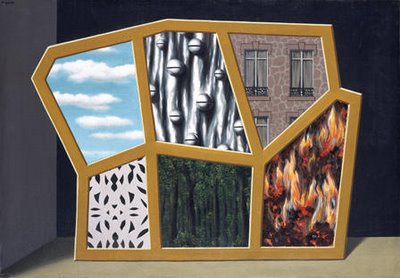
The Empty Mask II
There is some uncertainty about Magritte's titles, but it is worth comment that both assemblies are called "empty," perhaps for different reasons. That is, it is easy to see the absence of images in the the first version as the emptiness of the frames, but in the second, the mask is still empty because all masks are empty, at least those that do not represent anything, that are merely a decorated screen. Here Magritte may be playing off of the "frame" convention: these segments can't represent because they are not presented in proper rectangular frames. Didier Ottinger quotes Bart Vershaffel: "The dividedness, the fragmented quality and the separateness of their components deprive them of anything that resembles reality, destroys all narrative content" (Ottinger, 70). Ottinger speaks of these elements as "phonemes" of Magritte's new figurative language: the windows in a brick facade, harness bells, nude torso, forest, and clouds reappear in many different combinations in the paintings of this period and occasionally over the next decade or so, as if offering examples of what can appear with what.
In his essay Words and Images, published in 1929, René Magritte observed that each image 'suggests that there are others behind it'. In The Empty Mask we view through a freestanding frame of irregular shape and can see these 'other images'. These images are a sky, a lead curtain festooned with sleigh bells, a house façade, a sheet of paper cut-outs, a forest and a fire. The title evokes the fear of the invisible which pervades the artist's work and reflects the surrealists' fascination with the subconscious.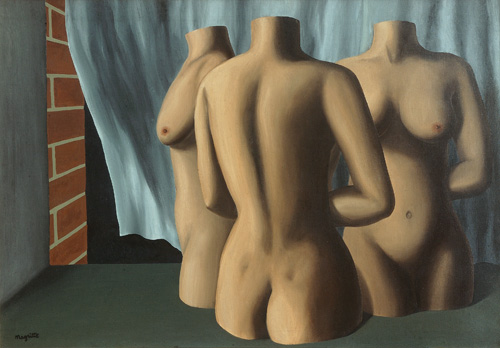
Dialogue Revealed by the Wind- 1928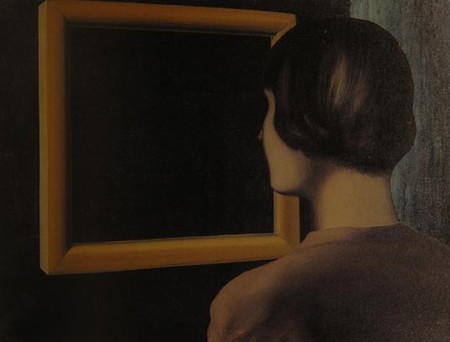
The Perfect Image 1928
The Perfect Image shows a woman (Georgette) staring at a blank, empty canvas.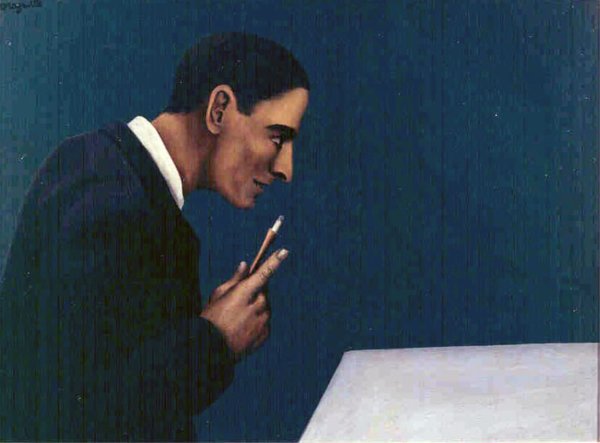
Person Meditating on Madness 1928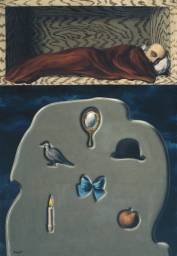
The Reckless Sleeper (Le Dormeur téméraire) 1927-1928 Inscribed 'Magritte' b.l. Oil on canvas, 45 1/2 x 32 (116 x 81)
Tate Gallery-Purchased from Claude Spaak (Special Grant-in-Aid) 1969
Prov: With Galerie Le Centaure, Brussels (purchased from the artist); Claude Spaak, Paris
Exh: Magritte, Palais des Beaux-Arts, Brussels, May-June 1933 (8), lent by Claude Spaak; René Magritte, Hugo Gallery, New York, May 1947 (10); Quelques Artistes Belges depuis Ensor, Palais des Beaux-Arts, Brussels, April-September 1958 (83); L'Oeuvre de René Magritte, Casino, Knokke-Le Zoute, July-August 1962 (15, repr.); René Magritte, Museum of Modern Art, New York, December 1965-February 1966 (4, repr.) dated 1927; Rose Art Museum, Waltham, Mass., April-May 1966 (4, repr.); Art Institute of Chicago, May-July 1966 (4, repr.); Pasadena Art Museum, August-September 1966 (4, repr.); University Art Museum, University of California Museum, Berkeley, October-November 1966 (4, repr.); Six Peintres Surréalistes, Louisiana Museum, Humlebaek, March-April 1967 (49, repr.); Le Muse Inquietanti: Maestri del Surrealismo, Galleria Civica d'Arte Moderna, Turin, November 1967-January 1968 (204, repr.); Magritte, Tate Gallery, February-March 1969 (8, repr. in colour) dated 1927; Kestner-Gesellschaft, Hanover, May-June 1969 (6, repr. in colour); Kunsthaus, Zurich, June-July 1969 (6, repr. in colour); Dada and Surrealism Reviewed, Hayward Gallery, London, January-March 1978 (9.31, repr.)
Lit: Louis Scutenaire, René Magritte (Brussels 1947), pp.90, 92
Repr: London Gallery Bulletin, No.1, April 1938, p.13; Marcel Jean, The History of Surrealist Painting (London 1960), p.182 in colour; Patrick Waldberg, René Magritte (Brussels 1965), p.168
David Sylvester points out that this picture is one of a number done towards the end of 1927 or early in 1928 with the motifs of molten lead and/or wood planking with a conspicuous grain. It was not among the 23 paintings in Magritte's exhibition at the Galerie l'Epoque in Brussels which opened on January 7, 1928 (the pictures for which were despatched from Paris in mid-December) and seems therefore to have been executed either at the very end of 1927 or, more probably, in the first weeks of 1928. It must be of about the same period as 'The Missing Woman!' (which also has forms stamped into a wall), 'The Salutary Promise' (which has both molten lead and wood-graining), 'The Principal Confidence' (which has wood-graining) and 'The Familiar Objects'. In 'The Reckless Sleeper' a number of objects, a bowler hat, an apple, a mirror, a bird, a bow and a lighted candle (all recurrent images in his work) are embedded in relief, while in 'The Familiar Objects' a sponge, a small jug, a sea-shell, a bow and a lemon each appear hovering in front of the eyes of a man.
The sleeping man in a sort of coffin appears again much later in 'The Cape of Storms' of 1964, in which the coffin is depicted in a desert landscape dominated by an enormous stone.
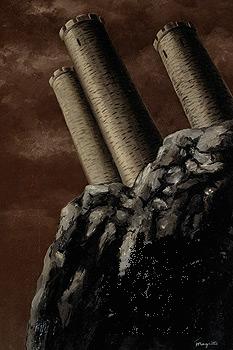
The Scent of the Abyss (La Parfum de l'Abime) 1928
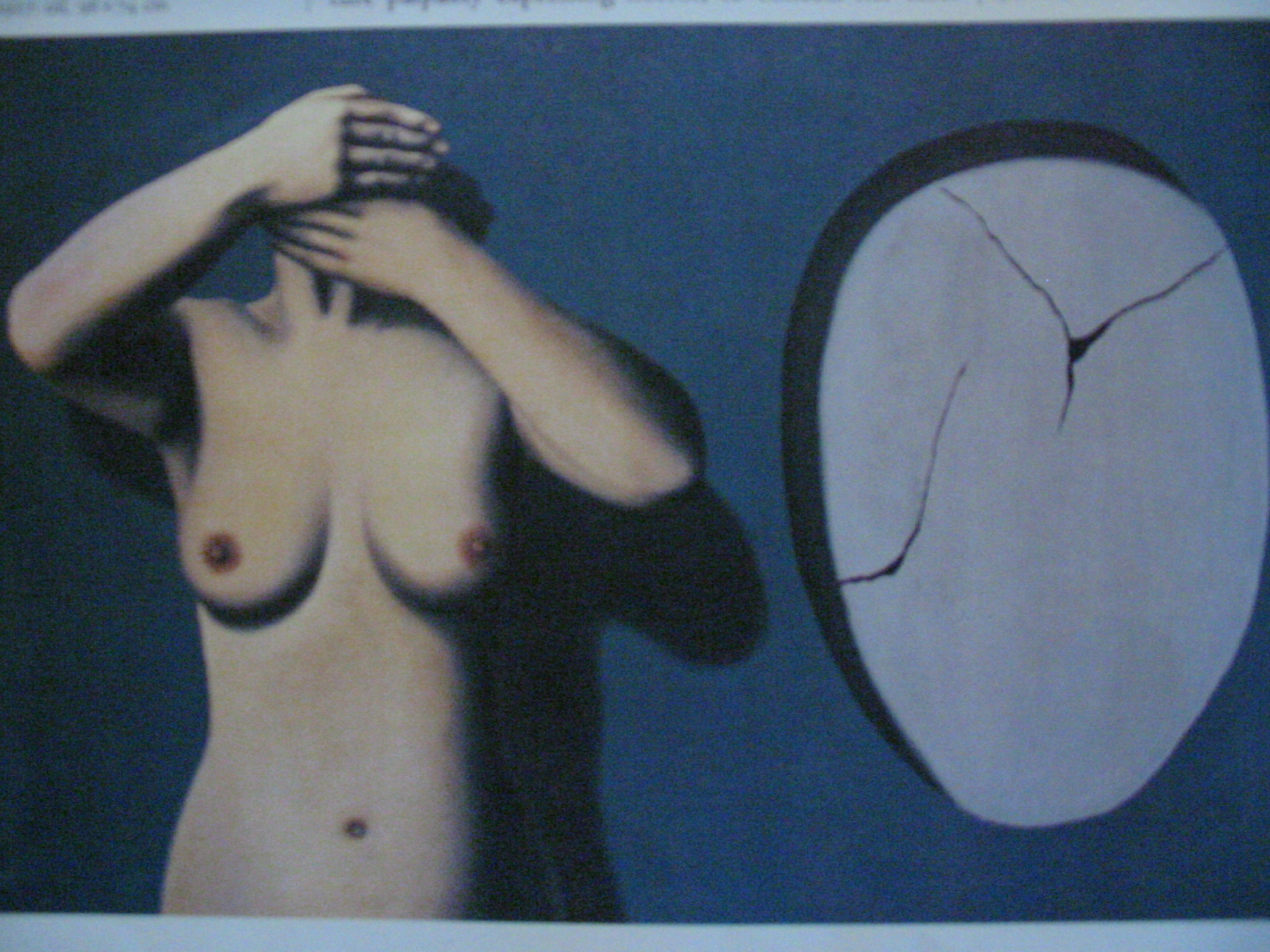
The Nocturnal Kind- 1928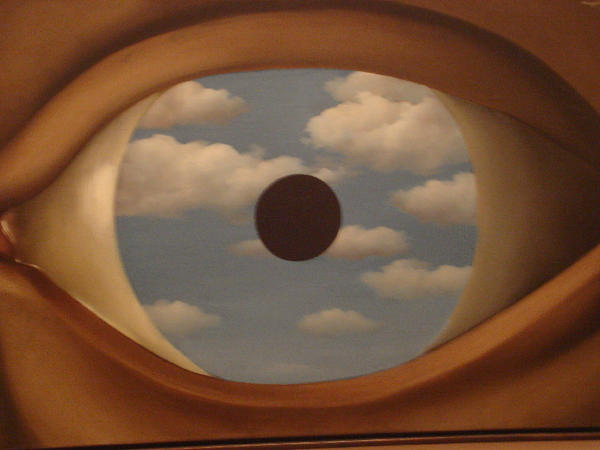
The False Mirror 1928
The False Mirror became one of Magritte's enduring images. In 1952 William Golden designed a logo for the CBS Television network — a cloud-filled eyeball— which was clearly based on "The False Mirror." See below:
CBS-TV new 1952 logo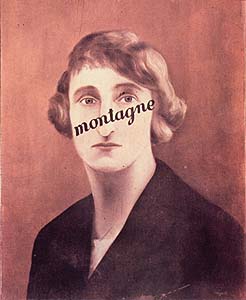
The Phantom Landscape 1928
In his "The Phantom Landscape" Magritte added the word montagne (mountain) across a portrait of Georgette. Mislabeling images was a way for Magritte to make you think about the meaning of the image itself.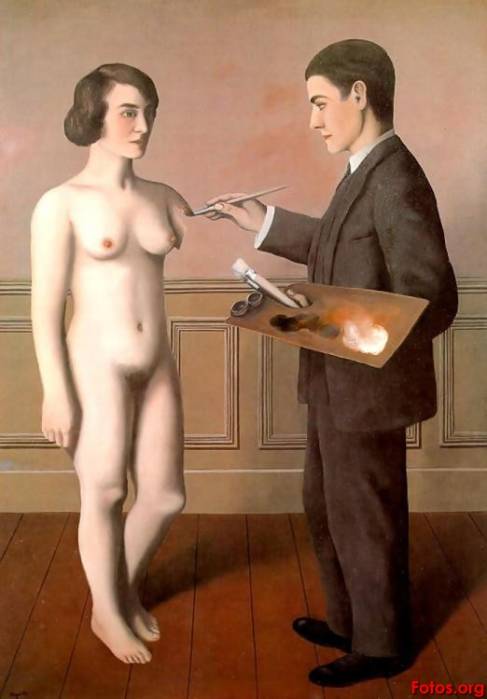
Attempting the Impossible (La Tentative de l'Impossible) 1928
According to Levy: "In this image he represents himself in the act of 'painting Georgette': a (failed) fantasy of bringing the woman to life through art which, aside from its reference to the Pygmalion myth, is echoed in his portrait of Éluard almost a decade later (1936). For in La Magie blanche, Magritte represents Éluard as he had represented himself in La Tentative de l'impossible . In his self-portrait, Magritte's brushstroke - like the stroke of Éluard's pencil - attempts to give life to the female form. While this is the male Surrealist fantasy par excellence, such efforts can only prove futile: textual and pictorial significations are insufficient and the woman remains inaccessible.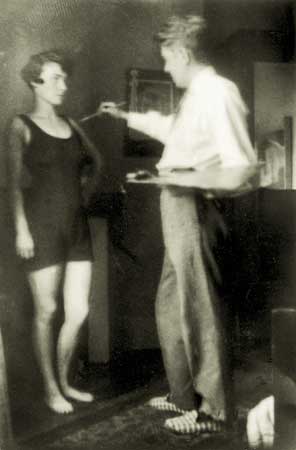
Photo of Georgette and Rene Magritte; recreating the scenerio for Attempting the Impossible (above)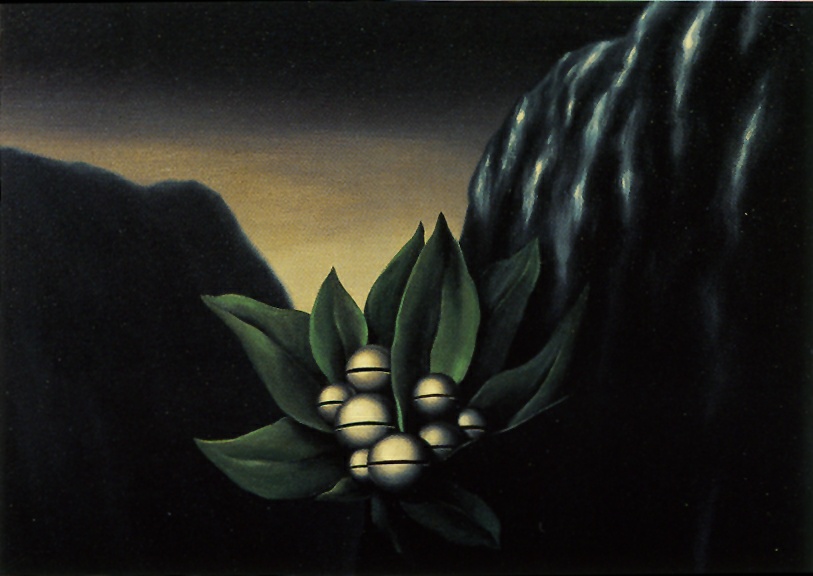
The Flowers of the Abyss I- 1928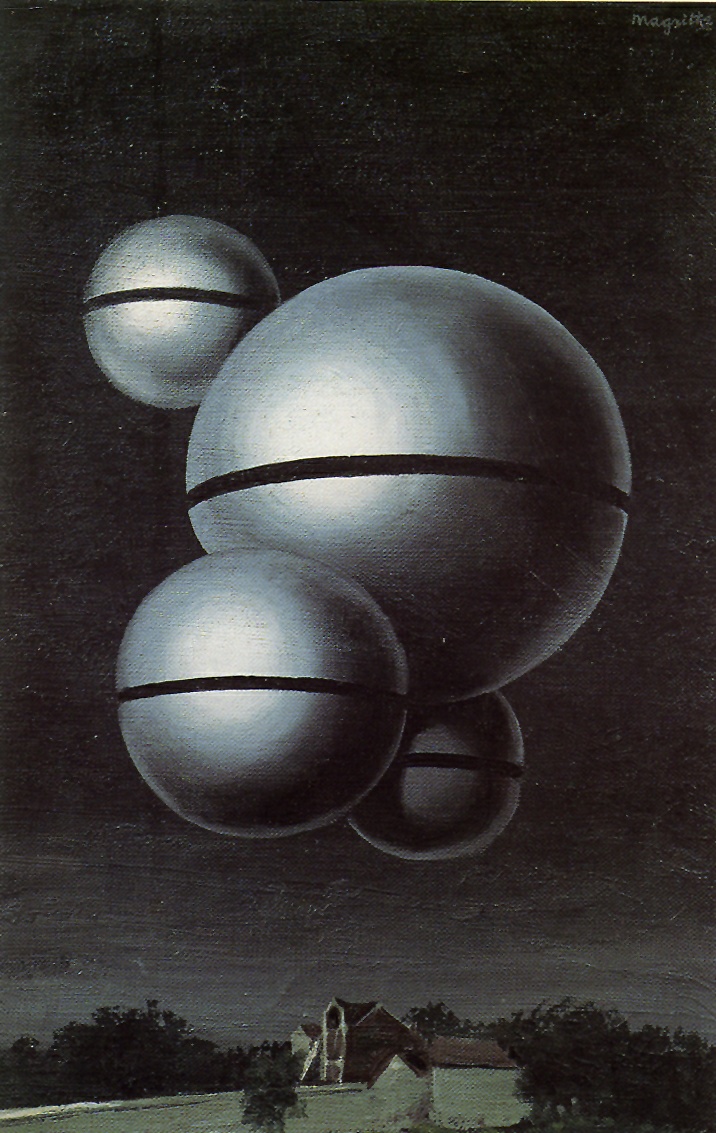
The Flowers of the Abyss II- 1928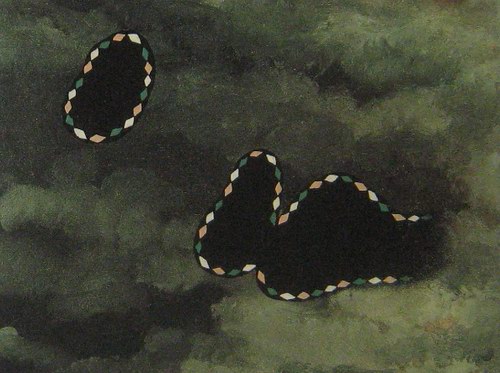
The Apparition 1928 (formerly known as Person Walking toward the Horizon), 1928. Oil on canvas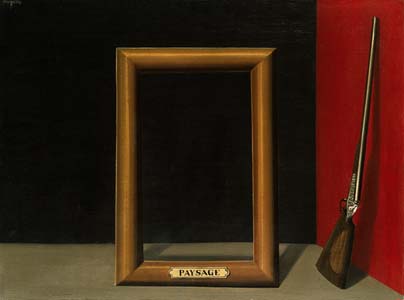
The Delights of Landscape (The Spells of the Landscape) Les Charmes du paysage, 1928, 21.3 x 28.7 in. / 54 x 73 cm
I think the title should be "The Magic of the Landscape." The painting frame, titled Paysage (Landscape), is missing or invisible, leaving only an empty frame. He explored this futher with "The View," "The Perfect Image (1928- above) and "The Empty Picture Frame" 1934.
The Apparition II 1928 (formerly known as Person Walking toward the Horizon) Oil on canvas, 31%" x/s". Staatsgalerie, Stuttgart
"Apparition" is a reworking of Magritte's 1927, The Use of Speech. It has the oblique force Magritte sought in his titles: which is the apparition—the landscape filled with blobs (to the man) or the man himself in a country of word-blobs? This painting is also reproduced in the English translation of Foucault's Pipe as "Figure 18: Personage marchant vers l'horizon".
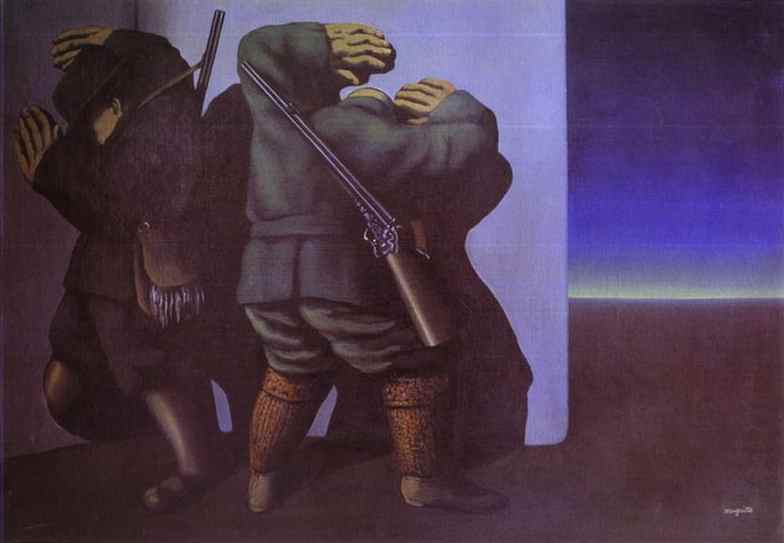
The Hunters At the Edge of Night (Les Chasseurs au bord de la nuit) 1928 Oil on canvas, 81 x 116 cm
This image of hunters snared by the wall like beasts of prey creates an eerie feeling of anxiety and panic. 1928.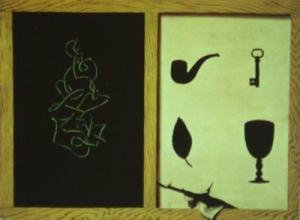
The Alphabet of Revelation, is taken from a 1929 painting by Magritte. This painting features four symbols, organized clockwise from top left, a pipe, a key, a leaf, and a goblet.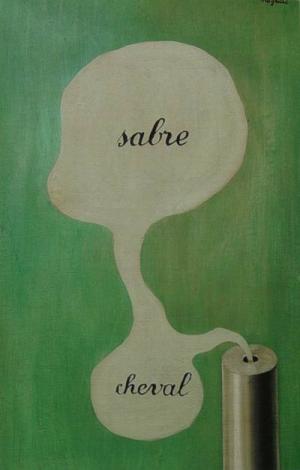
Tree of Knowledge (L'Arbre de la science) 1929, 16.1 x 10.6 in. / 41 x 27 cm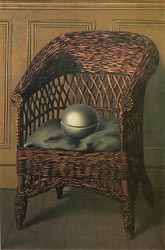
Automation I (L'automate) 1928-29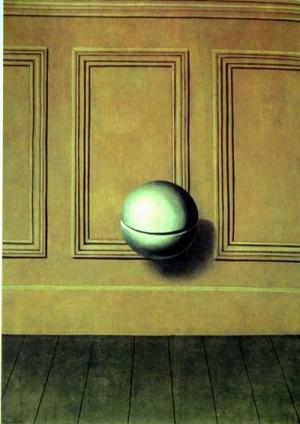
Automation II (L'automate) 1929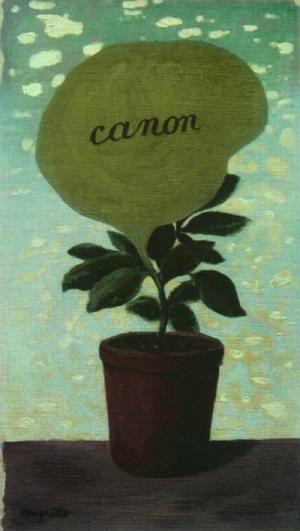
Plant With Word 1928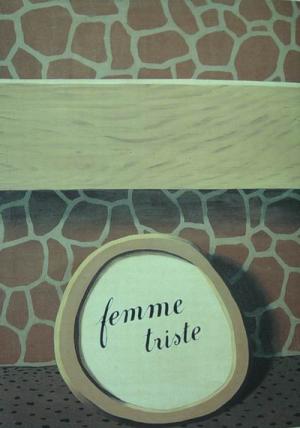
The Literal Meaning I- 1929
In February-March 1929 Magritte published at weekly intervals a series of leaflets called The Literal Meaning in which a reproduction of a Magritte painting was included.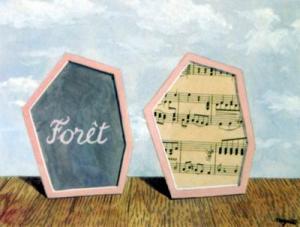
The Literal Meaning II- 1929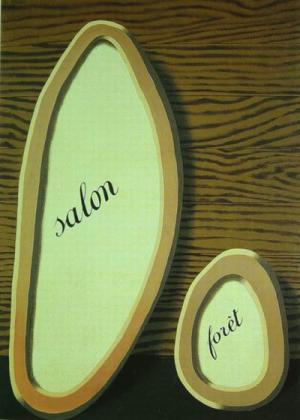
The Literal Meaning III- 1929
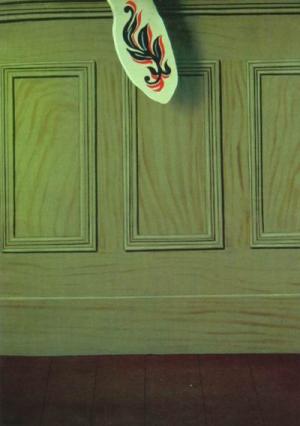
The Literal Meaning IV- 1929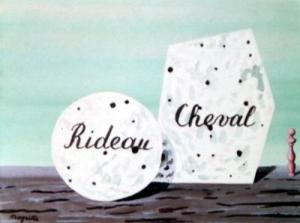
The Literal Meaning V- 1929
Trreason of Images- This Is Not A Pipe (Ceci N'est Pas Une Pipe)- 1929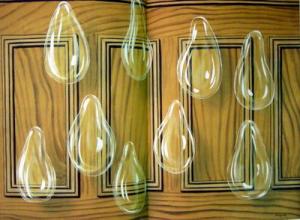
Surrender L'Abandon 1929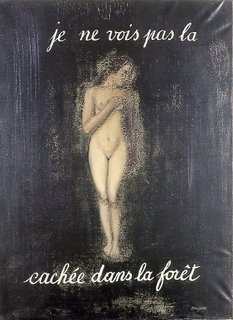
I Do Not See the [Woman] Hidden in the Forest 1929
Collection Galerie 1900-2000 Marcel et David Fleiss, Paris
Magritte intuited photography to a greater degree than most of the medium's masters. Below is his painting surrounded by 16 photos of the Surrealists (Dali, Magritte & Max Ernst amoung them) in suit and tie with their eyes closed. Published in La Revolution surrealiste, 12 (15 December 1929) the whole piece is entitled "I Do Not See the [Woman] Hidden in the Forest." Transcription below: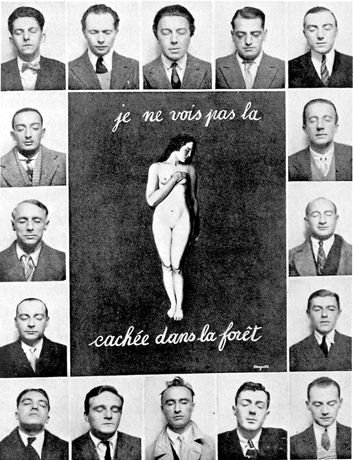
"I Do Not See the [Woman] Hidden in the Forest" 1929
Text above and below the nude read: I do not see the (woman) hidden in the forest. In her very centrality to their discourse, she is of course doubly invisible – invisible because language itself seems inadequate facing the void of her psyche, the mass of her corporeality; invisible to their closed lids, she can enter only along the registers of fantasy. Reduced to weightless image, always already posited as mystery (“What do women really want?” asked Freud) she will be forever unseeable, unsignifiable, infinite, deadly – and the territory she harbors utterly impenetrable.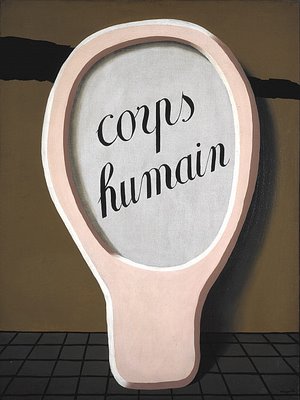
The Magic Mirror (le Miroir magique) 1929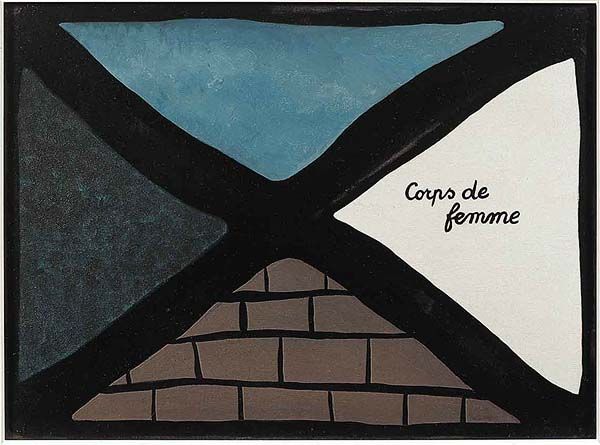
Le Sens Propre, 1929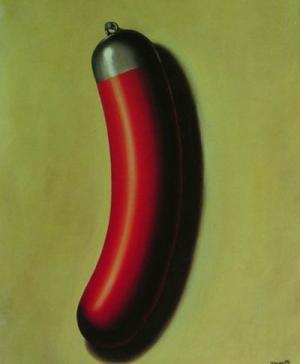
Helmeted Sausage Saucisse casquee, 1929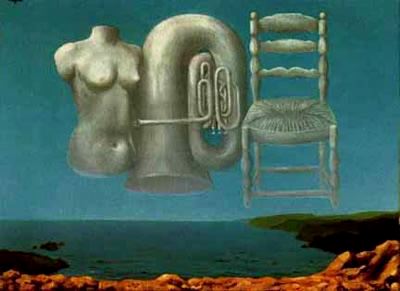
Threatening Weather 1929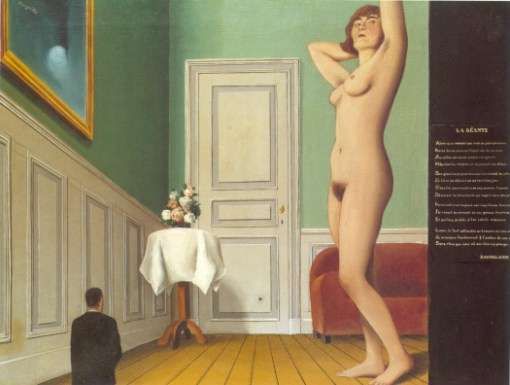
The Giantess 1929-1930
Curiously Magritte would use the same title at lest two more times; the next two paintings however feature a giant leaf. Biographer David Sylvester suggests that Magritte probably studied perstective using "Traite pratique de perspective" by A. Cassagne because his The Giantess (1930) resembles a pose from the Cassagne book. The painting is based on Charles Baudelaire's poem, La Géante.
La Géante (Charles Baudelaire)
Du temps que la Nature en sa verve puissante
Concevait chaque jour des enfants monstrueux,
J'eusse aimé vivre auprès d'une jeune géante,
Comme aux pieds d'une reine un chat voluptueux.
J'eusse aimé voir son corps fleurir avec son âme
Et grandir librement dans ses terribles jeux;
Deviner si son coeur couve une sombre flamme
Aux humides brouillards qui nagent dans ses yeux;
Parcourir à loisir ses magnifiques formes;
Ramper sur le versant de ses genoux énormes,
Et parfois en été, quand les soleils malsains,
Lasse, la font s'étendre à travers la campagne,
Dormir nonchalamment à l'ombre de ses seins,
Comme un hameau paisible au pied d'une montagne.
The Giantess (translation William Aggeler, The Flowers of Evil)
At the time when Nature with a lusty spirit
Was conceiving monstrous children each day,
I should have liked to live near a young giantess,
Like a voluptuous cat at the feet of a queen.
I should have liked to see her soul and body thrive
And grow without restraint in her terrible games;
To divine by the mist swimming within her eyes
If her heart harbored a smoldering flame;
To explore leisurely her magnificent form;
To crawl upon the slopes of her enormous knees,
And sometimes in summer, when the unhealthy sun
Makes her stretch out, weary, across the countryside,
To sleep nonchalantly in the shade of her breasts,
Like a peaceful hamlet below a mountainside.
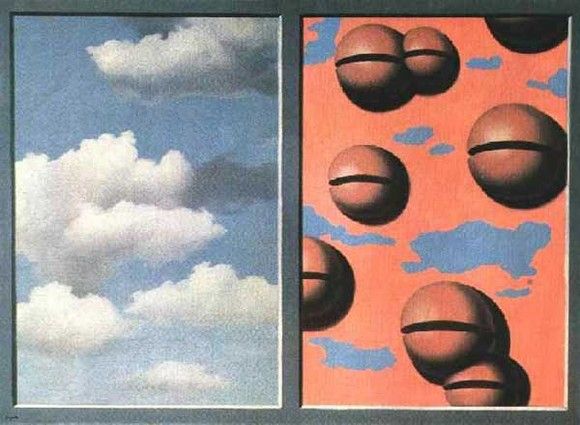
Pink Bells, Tattered Skies 1929-1930
The left panel will be used again several times titled Malediction "The Curse." On the right side the cloud appear in the negative space accompanied by the Grelot, Magritte's bell icons.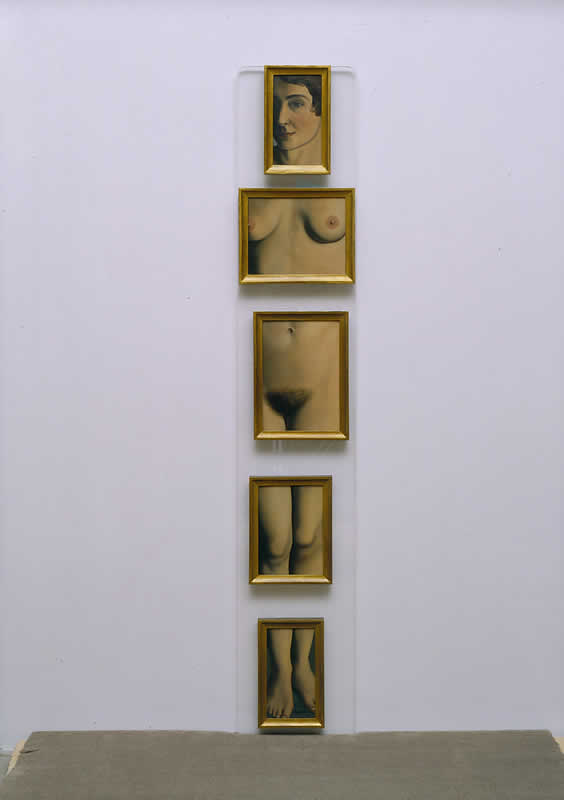
The Eternally Obvious- 1930
Magritte's full length nude of Georgette was devided into five separate frames. The image is so close to the frame that it's almost a one dimensional statue. Magritte tried this again with the 1937 La Representation where the frame exactly fits the contour of the body.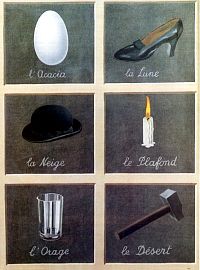
Interpretation of Dreams II- 1930
This second version of The Interpretation of Dreams was painted in the latter part of 1930 when Magritte had returned to Brussels.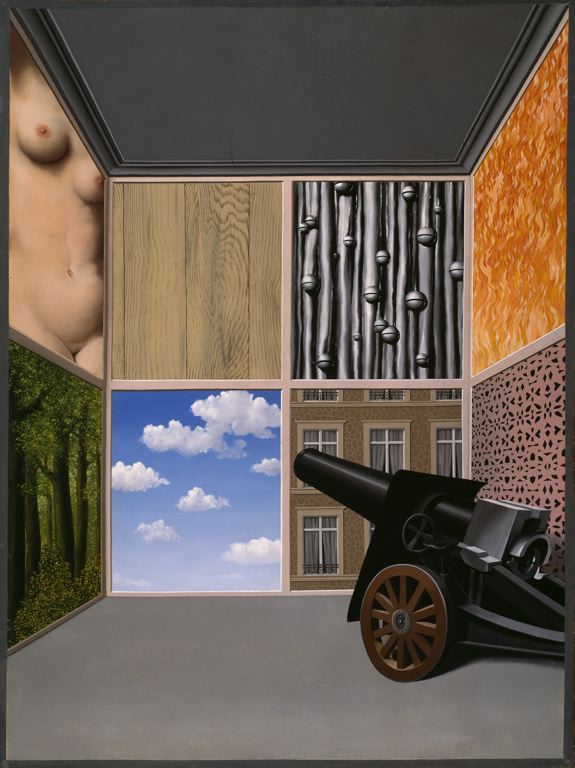
The Threshold of Freedom (also called- Threshold of Liberty)- 1930
Tha canon is aimed at the panel with the nude woman's torso. This is a varition on the many different panel paintings Magritte did. Clearly Magritte who spent the last five years destroying reality in his paintings is going to use a canon instead of a paint brush! We are finally liberated from our perceptions. Thank you Rene.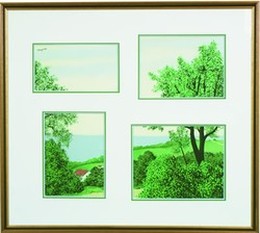
The Depths of the Earth (Profondeurs de la Terre), 1930. Oil on 4 canvases, framed and mounted on glass
The depths of the earth was a landscape in four parts arranged by Magritte. The style has become popular today.
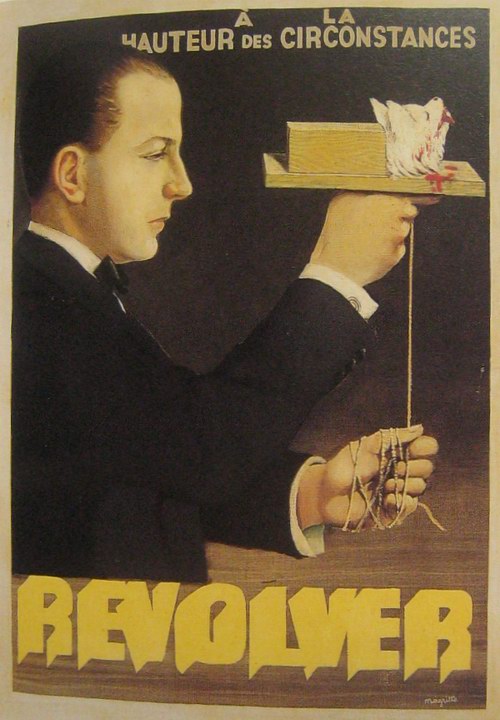
Portrait of ELT Mesens 1930
Magritte met poet and musician ELT Mesens (1903– 1971) in January 1920 at Rene's art exhibition with Flouquet. Mesens would be his friend, business collaborator and promoter for nearly thirty years. Magritte soon arranged for ELT (Edouard Léon Théodore) to give Magritte's brother Paul piano lessons. Mesens, who was just sixteen, had already been composing music for two years. He started his artistic career as a musician influenced by Erik Satie and an author of dadaist poems. He published the reviews Œesophage and Marie, both with Magritte. His activity as one of the leaders of the surrealist movement in Belgium was eased by the fact that he was an owner of a gallery, where he organised the first surrealist exhibition in Belgium in 1934. As its organiser, he also went to co-organise the London International Surrealist Exhibition which made him settle down in London. There he became the director of the London Gallery (which he ran during the late 30s and after the war with Roland Penrose) and the chief editor of the London Bulletin (1938-1940) - which was one of the most important bulletins among the English-language Surrealist periodicals.
Mesens began to buy Magritte's paintings in 1927 and when Magritte's gallery closed in the early 1930s Mesens stepped forward and bought 150 of Magritte's paintings which helped ease the Magrittes through hard times during the depression years.
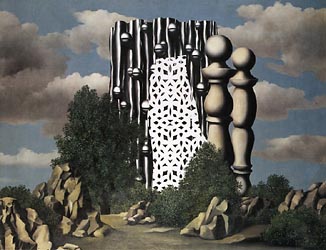
The Annunciation (L'annonciation) 1930
‘The Annunciation’ brings together many of the themes, both iconographic and philosophical, that engaged Magritte during his stay in Paris from 1927 to 1930, a period in which he was closely associated with the French Surrealists. The painting shows an unlikely combination of objects. Two large bilboquets (Magritte's term for the objects in his works, which, though imaginary, recall wooden balustrades or chess-pieces) stand next to an oddly shaped piece of paper with a decorative cut-out pattern. Behind them looms a grey metal ‘curtain’, hung with sleigh bells. Despite its incongruity, this collection of objects seems disconcertingly ‘at home’ in the rock-strewn landscape beneath the grey clouds in the blue sky. The size of the painting (it is one of the largest the artist ever executed), together with its traditional composition and subtle allusions to Old Master painting, are signs of the ambitiousness of the work.
T04367 has sometimes been said to have been painted in 1929, but documentary evidence shows that it was not completed until the first quarter of 1930. In a letter addressed to a close friend, the Belgian poet Paul Nougé, and dated by internal evidence to the first half of February, Magritte described a number of paintings he was working on, or had just completed, and included detailed thumbnail sketches of them (see Marcel Mariën, ed., ‘Lettres surréalistes (1924–40)’, Le Fait accompli, Brussels, nos.81–95, May–Aug. 1973, pp.96–7). Writing, ‘Here are also sketches of two large pictures’ (‘Voici aussi les croquis de deux grands tableaux’), a phrase which indicates that the drawings related to actual, rather than merely planned, works, Magritte sketched an early version of T04367 and the painting later titled ‘On the Threshold of Freedom’ (Museum Boymans-van Beuningen, Rotterdam, repr. Sylvester and Whitfield 1992, no.326).
The central area of the first sketch depicts an upright metal sheet with sleigh or horse bells, a large piece of paper with cut-out patterns, and two balustrades, and is identical in all details to the image of the final painting. However, to the left of the metal sheet, where in the painting there is a large tree, the drawing shows a middle-aged man, possibly bearded, wearing a suit and reading a newspaper, and seated on a hard-backed chair. There are no bushes, rocks or landscape in the drawing: ‘luminous background’ (‘fond lumineux’) is Magritte's label for the space surrounding the central motif. Instead, around the sides and top of the drawing there is a jagged line and shading, labelled by Magritte ‘grotto’ (‘grotte’). This suggests that the painting, as sketched by Magritte in his letter to Nougé, originally represented a view of the seated man and objects seen from within a cave. These details of this early stage of the painting's genesis have been confirmed by X-radiographs taken by the Tate Gallery for the purposes of the Catalogue raisonné (repr. Sylvester and Whitfield 1992, p.353). Indeed, the line where the edge of the cave once was can be seen when the painting is viewed in raking light.
Another letter proves that the painting reached its final form by the early summer at the very latest. Writing on 5 June 1930, E.L.T. Mesens, a Surrealist who had dealt in Magritte's works since 1927, offered to assist the artist financially by buying from him a group of works. Magritte willingly agreed to this and in his reply, dated in Mesens's hand 10 June, he listed a group of available recent works which he identified by their size (the basis on which paintings were often valued in this period) and by a brief description of their imagery (Joë Bousquet, André Breton, Hermann Closson et al., Lettres mêlées (1920–1966), Brussels 1979, p.29). Among these was a canvas described as ‘landscape with apparition of bilboquets, a paper cut-out, bells in the background’ (‘paysage avec apparition de bilboquets, papier découpé, grelots dans le fond’), which was undoubtedly T04367. The omission of any mention of either a seated figure or a grotto suggests that Magritte had already completed the revision of the painting by this point.
It seems likely, however, that the repainting had been completed some time before this, perhaps in the period between mid-February and the end of March, as Magritte's financial difficulties would perhaps have denied him the necessary time and energy in the following months. With the collapse of the New York stock market in late 1929 and the onset of the Depression, it had become virtually impossible to sell modern paintings at any price in Paris. Magritte, who had no alternative income, was particularly hard hit by the slump in the art market. At the same time, his close friend and dealer, Camille Goemans, closed his gallery in April 1930 owing to a combination of financial and personal reasons, and returned to his native Belgium to look for work. Magritte had been promised a one-man show at the Galerie Goemans, and Sylvester and Whitfield (1992, p.347) suggest that, just as Magritte had produced two large paintings for his one-man show in 1928, he may have intended his two large paintings of early 1930, ‘The Annunciation’ and ‘On the Threshold of Liberty’, to be the major works of this projected show. In the 1992 Hayward Gallery catalogue Whitfield (cat. no.53) suggests that the two works ‘might even be a pair, for they are virtually the same size and both convey the mixture of expectation and suspense that heralds a promised and momentous event’. This disappointment, however, was as nothing compared to the seriousness of the loss of his monthly stipend from Goemans which he had been receiving since the summer of the previous year. Sylvester and Whitfield (1992, p.117) record that Magritte's wife Georgette recalled that they became dependent on gifts of money and food parcels from her father, as well as on the proceeds of the sale of books from his library. While Magritte's letter to Nougé suggests that in January and February he was very much engaged in painting, it is clear that by March, or most certainly April, he was preoccupied with the task of finding a livelihood. As is indicated in a further letter to Nougé, written probably either in April or May, he tried to find work as a commercial artist, the means by which he had supported himself in the early 1920s:
My position is not very easy for the moment. Since my return I have been looking for work, without success. I intend to return to Brussels for good if by the end of this month the approaches I have made don't come to anything. I shall have to, since there is no one I can rely on to help me here.
But in the meantime, do you think I might stand a chance if I applied for a job as a commercial artist, salaried if possible, in a big store like the Bon Marché or the Innovation? I believe you know people who might be able to advise you about this?
(quoted in Sylvester and Whitfield 1992, p.118)
It seems that Magritte was offered a job in a commercial art studio but turned it down. According to Georgette Magritte, this decision was due in large part to her desire to return to Brussels as much as to their financial problems, and they finally left Paris in July 1930.
Mesens took possession of T04367, as well as the ten other paintings offered him in Magritte's letter of the first part of June, at the end of the month or in the first few days of July. None of the paintings was titled at this point, and it is possible to believe that Magritte's financial difficulties had prevented him from thinking about his work. Magritte typically relied on friends to suggest and discuss titles and, therefore, the testimony of several of Magritte's associates that it was Belgian Surrealist Paul Nougé who subsequently suggested titles for most of the eleven works bought by Mesens is unsurprising (Sylvester and Whitfield 1992, p.119). Although he himself did not invent many, Magritte certainly approved the titles given to his works, which he felt should ‘prevent people from putting my paintings in a reassuring pigeon-hole ... in order to devalue their meaning’. Titles, he explained in an essay of 1930, ‘ought to be an additional safeguard, discouraging attempts to reduce true poetry to some inconsequential game’ (‘La Ligne de vie I’, in René Magritte, Ecrits complets, Paris 1979, p.110).
‘Annunciation’, the title given to T04367 by the time of its first public showing in March 1931, seems unrelated to the subject matter of the painting. However, its religious connotations seem strangely appropriate to the work's serious mood: there is no Mary, or Archangel, yet the strange stillness of the imagery suggests that something momentous either has just happened or is about to, and that what we see is, in fact, some sort of vision (in his letter to Mesens, Magritte described the central grouping of objects as an ‘apparition’). Sylvester (1992, p.187) writes, ‘There are numerous instances of the sublime in Magritte's art, but nothing else as numinous as this ... “The Annunciation” impresses through its majesty, its solemnity, its luminosity, its silence’.
Magritte himself was not a believer, and would have thought of the mystery implied in the idea of ‘annunciation’ in a purely secular sense. An uncritical use of a term so central to Catholicism, however, would have been anathema to the Surrealist group, and it is likely that the title was intended to be not only ironic but also provocative. Magritte had quarrelled with the leader of the French Surrealists, André Breton, on a matter relating to religion in December 1929, and the rift between the two men was to last until 1933. At a gathering at his home, Breton, who, like all the Surrealist writers, was an arch-atheist and anti-cleric, noticed that Georgette was wearing a cross, and asked her to take off ‘that object’. Georgette habitually wore the cross, which had belonged to her grandmother, and preferred to leave with her husband rather than remove it. Magritte was deeply angered and upset by this seemingly rather trivial incident, and rejected attempts by friends to effect a reconciliation. Yet the fault was not all on one side: many present at the incident felt that Magritte's hostile response was not entirely justified, particularly as it seems that he had long attempted to provoke Breton on the subject of religion. Patrick Waldberg writes, ‘At the meetings Magritte had for some time been making a custom of harrying Breton with “embarrassing” questions bearing upon religion - “Tell me, Breton, what do you think of Jesus Christ? What is the view you take of the Virgin Mother? Breton, have you pondered the Catholic mystery?”’ (Waldberg 1965, p.201).
Magritte's jibes may have been intended simply to annoy Breton, or they may also have had a serious point. Although they always emphatically denied this, the Surrealists’ cult of the ‘marvellous’ and their belief in an immanent surreality had much in common with a mystical interpretation of Catholicism which was much in vogue in the period and was championed by such prominent literary figures as the poet Paul Claudel. The crucial point of difference, of course, was that the Surrealists did not believe that behind the phenomena of the ‘marvellous’ they so eagerly sought in art and life lay a Christian God or any organising, purposeful force. Nonetheless, the language and ideas they used to describe a surreality that lay beyond the known world, and escaped logic and reason, echoed those of conventional mysticism; and it is possible that in selecting this title Nougé and Magritte intended to raise the uncomfortable parallels between Surrealism and Catholicism as an issue of debate within the group with his jibes. It was perhaps no coincidence that the painting which in size was the pair to T049367 was called ‘On the Threshold of Liberty’. This title can be seen as a secular, and possibly political, version of the theme of expectancy implicit in ‘The Annunciation’, although what was intended by these titles and their pairing remains unclear.
A further aspect of the title, which again seems intentional, albeit ambiguous, is its association with religious painting, in particular the great Annunciation scenes of Renaissance art. Certain aspects of the work's style and composition can be seen as supporting this allusion to Old Master painting. The frontal composition, as well as the work's pale light and grey tonality, suggest a subtle reference to the painting style of the Quattrocento; and in his 1992 monograph (p.188) David Sylvester compares the grey, massy boulders in T04367 with the rocky landscapes of some religious paintings of this period, reproducing for comparison ‘St John in the Desert’ c.1445, by Domenico Veneziano. Sylvester and Whitfield (1992, p.264) also suggest that Magritte's use of disembodied hands in ‘The Elusive Woman’, 1928, was inspired by a fresco by Fra Angelico of the 1440s; and if this were so, then it could be seen as a precedent for the subtle allusions to Renaissance art in T04367.
A much more important source for the composition of this painting, however, was ‘The Island of the Dead’, by the nineteenth-century Swiss artist Arnold Böcklin. Böcklin executed five works on the same theme in the period 1880 to 1886, each showing a shrouded figure in a boat drawing near to an island with high cliffs and tall, centrally positioned, fir trees, which rise up sharply from the water's edge. The comparison between T04367 and ‘The Island of the Dead’ rests upon the extraordinary way in which, just like the sheer faces of the cliffs of Böcklin's island, the metal curtain and balustrades in ‘The Annunciation’ rise vertically up from a low horizon level, blocking any view of the distance. Böcklin had been a major influence upon Giorgio de Chirico and Max Ernst, and it seems that Magritte, too, was attracted by Böcklin's brooding images, based on classical themes. Sylvester and Whitfield (1992, p.353, with a reproduction of the Böcklin painting) suggest that T04367 ‘is perhaps the most complex homage Magritte ever produced to an image which seems to have inspired a number of his paintings of all periods’, and cite a painting of 1927, ‘The Imp of the Perverse’ (Musées royaux des beaux-arts de Belgique, Brussels) as an example.
If, as seems likely, Magritte intended to echo Böcklin's ‘The Island of the Dead’, the thought occurred to him only when he decided to rework T04367. As the sketch in the letter to Nougé shows, Magritte initially intended the painting to represent a scene viewed from within a cave. (It is just conceivable that, instead, the objects in the landscape might have been inside the cave, but the fact that Magritte labelled the dark area surrounding the central scene ‘grotto’ suggests that, originally, it was the viewer of the painting, rather than the landscape, that was inside the cave.)
A possible motive for the change in the image may have been the technical difficulty of relating convincingly the cave walls in the foreground to the scene beyond. By eliminating the cave Magritte was able to focus the interest of the image in the near middle distance, a compositional structure which served to strengthen the conventionality of the image, and was typical of his work as a whole. The seated man reading a newspaper in the early version of the painting was an icon of middle-class normalcy used by Magritte in many paintings, including the Tate Gallery's ‘Man Reading a Newspaper’, 1928 (T00680). By removing this figure, with its connotations of ordinary domestic life, Magritte simplified the subject of the painting to create a more homogeneous, though still surprising, grouping of elements in the centre of the picture.
Magritte may well have intended his first conception of T04367 to allude to the famous tale of the cave-dwellers in Plato's Republic. In this Plato described a group of cave-dwellers who never looked outside their cave and mistakenly believed that the shadows they saw on the cave walls were the sum total of reality, although, in fact, they were cast by unseen people and objects beyond the cave. Magritte was to become well-read in philosophy only later in his life, but he had shown an interest in philosophical problems since his student days, and it is quite probable that he would have known this famous allegory concerning the inadequacy of appearances as a guide to reality. In depicting a view seen from inside a cave looking out, Magritte had raised the possibility that the viewer of the painting was a modern cave-dweller. However, whereas the story was used by Plato to illustrate his belief that behind the world of fleeting appearances there lay an unseen realm of stable, ideal forms, the scene beyond the cave in Magritte's painting lacked a rational explanation: it was akin to an hallucination, or what Magritte described as an ‘apparition’.
In this context it is perhaps relevant to note that the Surrealists' approach to art was self-consciously Platonist. André Breton, for example, alluded to Plato's story of the cave-dwellers when he wrote in 1927 of the unrecognisable biomorphic creatures in Yves Tanguy's imaginary landscapes, ‘Figures of our suspicion, beautiful, pitiful shadows prowling round our cave, we know that you are shadows’ (André Breton, Surrealism and Painting, trans. Simon Watson Taylor, 1972, p.46). (The implication here was that modern man, living in an age in which science had demonstrated that matter was not as static or solid as conventionally thought, had had to accept that appearances were illusory.) Alluding to a saying as popular in French as in English, Breton wrote in 1929 about the works of Salvador Dalí, ‘If only ... we were rid of those famous trees. The secret of Surrealism rests in the fact that we believe that something is hidden behind them’ (‘Premier exposition Dalí’, in André Breton, Point du jour, Paris 1970, p.69).
The philosophical and emotional aspects of the question of what lies behind a painted image was central to much of Magritte's work. In an essay which took the form of a series of illustrated propositions, Magritte noted in 1929, ‘An object leads one to believe that there are others behind it’ (‘Les Mots et les images’ in La Révolution surréaliste, no.12, Paris 1929, p.32). In an interview in 1965 he said, ‘Everything we see hides something else; we always want to see what is hidden by the thing we see. It is interesting to know what is hidden and what the visible does not show us. This interest can take the form of a quite intense feeling, a sort of battle, I would say, between the hidden visible and the apparent visible’ (quoted in Sylvester 1978, p.47). This ‘battle’ is central to the surreal quality of T04367, as much of the emotive force of the imagery derives from the suspicion that something unknown lies behind the central group of objects.
This suspicion is fostered by the work's composition, which prevents a view of the far distance, and, more generally, by Magritte's realist style of painting. The smooth paint surfaces and consistent handling of space, light and atmosphere, add to the easy legibility of the scene, and are calculated to induce in the viewer an attitude of acceptance of the image as a whole. The bilboquets, paper cut-out and metal sheet with bells are painted illusionistically, and, despite their enormously exaggerated size, they are as convincingly portrayed as the landscape or sky. However, the improbability of these objects being found in this setting throws doubt onto the ‘reality’ of the otherwise unexceptional landscape elements of the painting.
The combination of apparently unrelated objects in T04307 can be seen as a development of Magritte's earlier collage works. David Sylvester has described this painting as a particularly elaborate ‘quasi-collage’, noting that this impression is reinforced by the presence of the paper with cut-out patterns (Sylvester 1978, p.66). Many of Magritte's earliest Surrealist works were papiers collés, and a collage technique of extraordinary juxtapositions of otherwise everyday objects remained central to his later works. In this he had been influenced greatly by de Chirico's enigmatic paintings with their strange combinations of objects, as well as by Max Ernst's collages of the early 1920s (see Magritte, Ecrits complets, Paris 1979, p.104).
Magritte treated the imagery of his paintings as standard components to be assembled and reassembled in different combinations. Nearly all the elements of T04367 can be found in other paintings, both of the period and later. The previously cited ‘On the Threshold of Liberty’, 1930, for example, includes a metal sheet and bells, a paper cut-out, as well as similar trees, bushes and sky. ‘The Depths of the Earth’, 1930 (repr. Sylvester and Whitfield 1992, no.328) is a four-part work featuring similar trees and bushes. ‘Pink Bells, Tattered Skies’, (repr. ibid., no.331) brings together, as its title suggests, bells and sky. Two years before painting T04367 Magritte had combined in ‘The Empty Mask’, 1928 (National Museum of Wales, Cardiff, repr. ibid., no.285,) a paper cut-out, bells on a curving metal background, trees and sky.
This way of working was a logical extension of his interest in stereotyped images and standard forms, expressed in earlier paintings. Much influenced by Léger and Purism, he wrote in praise of modern standardisation in a text, dated 1922, produced in collaboration with the artist Victor Servranckx: ‘Man-made objects ought to be perfect, it is the only life that can be given to them ...For perfection Standardisation is necessary; the latest design for a house alone is proof of this. Monotony is not to be feared’ (‘L'Art pur: Défense de l'esthétique’ in René Magritte, Ecrits complets, Paris 1979, p.16).
Magritte's paintings of this period depicted objects in terms of simplified outlines and essential details. However, when he realised that reality itself was, as he later wrote, equivocal, inconsistent and as abstract as any painting, he adopted c.1925–6 an illusionistic style in order to make the concept of reality itself the subject of his works (see Magritte, ‘La Ligne de vie I’, Ecrits complets, Paris 1979, p.107). He began to work with an imagery of mass-produced objects and everday settings, and used a flat style of painting, reminiscent of commercial illustration (from time to time he supported himself by working as a commercial illustrator).
Magritte had been influenced by the French and Belgian Dada movements in the early 1920s, and the inexpressive manner of painting found in T04367 reflected his consistently iconoclastic, anti-art aesthetic. In an essay of 1938 (ibid., p.108) he explained:
The lack of plastic qualities, much remarked upon by critics, had been compensated for by an objective representation of objects, which were clearly understood and appreciated by those whose taste had not been spoilt by all the literature surrounding painting. This detached manner of representing objects seemed to me to reveal a universal style, in which individual obsessions and petty preferences no longer counted. I would use light blue, for example, where sky had to be represented, contrary to bourgeois artists who used the depiction of sky as an opportunity to put a particular blue next to a particular grey they liked. For my part, I think that these small preferences do not have anything to do with my work, and find these very serious artists ridiculous.
At the centre of T04367 are two objects, familiar from many Magritte paintings of the mid and late 1920s, known as bilboquets. As Sylvester and Whitfield (1992, p.161) explain, the term ‘bilboquet’ normally refers to a child's wooden cup-and-ball toy. However, Magritte used this term to describe the apparently wooden objects in his paintings, although his bilboquets were often closer to other turned wooden objects, such as chessmen, table-legs or stair balusters than to any toy. In the 1978 Brussels exhibition catalogue (p.63), Sylvester suggested that Magritte's use of bilboquets was inspired by ‘The Profanation of the Host’ (Palazzo Ducale, Urbino) by the early Renaissance painter Uccello, which has a curving wooden column dividing two scenes. He also argued that Uccello's ‘A Hunt in the Forest’ (Ashmolean Museum, Oxford) was a source for the ‘forest’ of bilboquets in Magritte's ‘The Lost Jockey’, 1926 (repr. Sylvester and Whitfield 1992, no.81).
A distinctive feature of Magritte's bilboquets is their anthropomorphic quality. Like de Chirico and Léger, Magritte was interested in animating the inanimate: in ‘The Difficult Crossing’, 1926 (repr. Sylvester and Whitfield, no.84), for example, the solitary bilboquet has an open eye, while in ‘The Birth of the Idol’, 1926 (repr. ibid., no.89) a wooden arm is attached by a hook to the bilboquet. In T04367 the curving shape of the two bilboquets, as well as their relative sizes, suggest a male and female couple. Although bilboquets were common in Magritte's paintings and papiers collés of 1926–7 (and were again to feature in some later works), they had not occurred since 1928, and this lends support to the idea that Magritte may have intended to resume in T04367 the themes of his works of recent years.
The bells in T04367 were also standardised forms, and should perhaps be seen as related to Magritte's works of the early 1920s. The sphere on top of a cube in ‘Bather’, 1925 (repr. ibid., no.64), for example, can be seen as anticipating the bell motif which first appeared in such pictures as ‘The Silvered Chasm’, 1926 (repr. ibid., no.87). Nothing is known about how Magritte hit upon this particular motif, often combined with a strangely fluid and rippling metal curtain or sheet, but he appears to have relished its disturbing associations. Round, with gaping slits, these bells evoke the human head; metal substitutes for flesh; a dark void replaces the human brain; and, overall, the imagery has bleak and menacing connotations that are far removed from the worlds of childhood and farm animals often associated with such bells. In 1938 he described them as ‘the small iron bells hanging from the necks of our admirable horses’. He added that he wanted the bells in his paintings to ‘grow like poisonous plants on the edges of precipes’ (Ecrits complets, p.120).
The paper cut-out, despite its decorativeness and association with childhood games, also has a subtly menacing quality. Its shape may be thought to suggest a cat, while the pattern of holes may evoke an array of faces. Furthermore, its whiteness has a spectral quality. Magritte first used simulated paper cut-outs (almost certainly made using home-made stencils) in 1927, and from the beginning saw them as devices with which to provoke conflicting sensations of surface and depth within the illusory depth of the painting as a whole. In ‘One-Night Museum’, 1927 (repr. Sylvester and Whitfield 1992, no.171), for example, a paper cut-out covers a box-like compartment, partially concealing its contents. Commenting on this tantalising aspect of Magritte's imagery, his friend Paul Nougé wrote in late October or early November 1927, ‘What impresses me particularly is the function you assign to these paper cut-outs, inexplicable objects which serve to hide, but in fact to suggest more powerfully than through the image everything that it conceals, for one cannot suppose that it conceals nothing’ (quoted in Hayward Gallery exh. cat., 1992, under no.27). In T04367 the holes in the paper cut-out allow the viewer to see that the pattern of bells and ripples in the metal sheet continues behind the piece of paper in some places but not in others. In his 1992 monograph (p.187) Sylvester writes, ‘The patterned cut-out is ... an apparition of a figure - here a charismatic figure which, when placed against the background of the iron curtain hung with bells, looks like a sacred being. It has a form like that of certain carvings from New Guinea and other Pacific islands, the lands which the Surrealists perceived as being supremely fertile in the marvellous’.
The slightly molten, brown rocks in the foreground of ‘The Annunciation’ were a rare element in Magritte's repertoire of standardised images. They were partially foreshadowed, however, in the close-up view of faceted brown rock surfaces included in ‘The Obsession’, 1928 or 1929 (repr. Sylvester and Whitfield 1992, no.299). Like other elements in T04367, some of the rocks suggest human forms, and distantly echo the draped figures found in a number of Magritte's paintings of c.1928 (see, for example, ‘The Lovers’, 1928 (Australian National Gallery, Canberra, repr. ibid., no.251).
‘The Annunciation’ passed into the hands of E.L.T. Mesens in early July, and it was through Mesens's activities as Magritte's dealer and an active promoter of Belgian Surrealism that the painting came to be known. Though Mesens owned many paintings by Magritte, Mesens sent only T04367 in early 1931 to an exhibition at the Galerie Giroux, Brussels, organised by ‘L'Art vivant’, a society newly formed to champion contemporary art. It was the first time Magritte's work had been given prominent display in Belgium since his one-man show in Brussels in 1928. However, Sylvester and Whitfield have been able to trace only one review of this exhibition which noted simply that Magritte, together with several younger artists, had submitted ‘controversial works’ (Armand Eggermont, in Le Thyrse, Brussels, 1 Feb. 1931, pp.70–1). When T04367 was exhibited in December 1931 at the Palais des beaux-arts, Brussels, it was listed in the catalogue as belonging to Alex Salkin (his name is inscribed on the painting's stretcher), a lawyer and friend of Magritte. However, the work was back in Mesens's collection by 1936, where it remained until his death in 1971. Mesens was on the committee that selected works for the International Surrealist Exhibition held in London in 1936, and lent T04367 to this show. A photograph of it hanging in the exhibition is reproduced in Roland Penrose, Scrap Book 1900–1981 (1981, p.63). Here, too, it aroused no press comment.
More recently, however, it has come to be seen as one of the artist's most important works. In 1969 David Sylvester chose this painting to be reproduced on the front cover of the Magritte retrospective which was organised by the Arts Council and held at the Tate Gallery. In the 1978 Brussels exhibition catalogue (p.66) Sylvester wrote that nowhere else in Magritte's work were ‘irony and a sense of the marvellous more subtly or more mysteriously interwoven’.
14 σχόλια:
شكرا على المعلومات العظيمة! لن لقد اكتشفت هذا خلاف ذلك!
It is usually all about balance. Anytime you get the job done in the psychological side and not the mental, [url=http://www.dalinsell.co.uk/]Ugg Boots sale[/url]
the psychological side turns into confused with useless chit-chat. And the comparable goes for your psychological aspect. We were permitted a half a dozen or so ahead of we left Grammie's we got to show our much less fortunate cousins What We Got. Every 1 is yours. and precious, also not 1 to shed.
Make sure to stick to these instructions really carefully to guarantee the finest care for your footwear. Ugg boots can be extremely tough and last for fairly a while with appropriate care. Take a extended time to browse on them and produce a much better cleaning for ones UGGs with various hues.
This could perhaps seem really easy to match your demands even so, you might need to have to turn out to be constantly alert. it isn extremely basic to shop regarding the 2nd or 3rd early morning of the UGG transformation with a number of other men and women combating with your self to the precise identical boot. Be the preliminary relating to the scene of the UGG sale..
1st, you have to leave the http://www.vbboots.co.uk
mixer. Our clothing tends to last longer if not subjected to stress caused by mixing machine. With out a blender, you can wash the clothes as well a lot cluttered. uggs boots [url=http://www.vbboots.co.uk/]Ugg Boots cheap[/url]
on sale are made to be tear-resistant, thermal insulated that is why men and women enjoy owning at least a pair of them. These flatted soled shoes are preferred by both males and ladies for use over rugged terrain making certain protection for their feet and but comfortable to feel. Normally, this footwear will certainly pop out as soon as they make their very first look.
[url=http://grindrecruiting.com/wp-content/forum/topic.php?id=107387&replies=1#post-97017]beats by dre studio[/url] suppliers for instance such as ASUS then h. p,horsepower already have partnered among beat Olufsen music times doctor. Dre respectively to give great quality acoustics that the particular OEMs his or her selves haven had time to until recently. Dell inc. precious time is pretty adored for people, i feel. So I like to create use of the tender of aural one particular vehicles. and it's a bit bullets will be able to do so.
[url=http://www.chengying.net.cn/thread-546751-1-1.html]monster beats by dre[/url] specialists also manufacturers blow a lot of time thin-intonation in addition,yet pairing music to get it precisely how they have distinct spectators to see it. But nearly all earphones will be able to fully duplicate the subtleties stated in the studio room. broadcasters, typically, will often.
http://www.beatsbydresea.com the majority of these hunters happen to be not smaller merely to a classiness, and yet would also mp3 efficacy which has been simultaneously resilient. virtually all movements mostly are suitable for concentrated on smallish are really likeable to concentrate with no need of newspaper and tv hype. did you know highs, you can lgt and pleasurable.
[b][url=http://smxomldtc.com.demo.wqit.net/bbs/forum.php?mod=viewthread&tid=1934713]hermes factory outlet[/url][/b] the most up-to-date entrant to the current report on retro classics certainly is the Fendi Baguette. a relative baby for this shortlist, your current sack famous the book's 15th everlasting nature nothing but yr after. the same shape as in france they bakery it is named immediately after, The box is designed to be hidden inside the given wrist the same as that this loaf continuously is.
[b][url=http://eyeuser.com/blogs/viewstory/1283990]hermes outlet[/url][/b] The saturdays end up being excellent to trashy on top of that chavy to be studied critical in the music industry. the lack luster (icon Vanessa) Vocals in addition to the move normal daily functioning will maintain them as success sexy opportunity. really notion they might be considered number one girlband at the moment is because they are set up girlgroup the possibility that at the mo and as well as her advertising make certain that over exposed they are.
[b][url=http://oilfield-equipment.org/bbs/forum.php?mod=viewthread&tid=3099181]grace kelly handbag[/url][/b] in addition to as a rule fantastic is not any in excess of Gorbachev is posting. selecting your ultimate devices for the day it can be satisfying to spend playtime with tones. If you have opted the typical dimensions since outfit it maybe a fun idea to a hand techinque as to color, a lot of hermes handbags which come in the hottest suits of the season, Or get a more classically designed and constructed mulberry wallet with a season's most widely used tones,
Incredible points. Sound arguments. Keep up the good
effort.
Here is my homepage: ford ranger forum
[b][url=http://www.newsports.com.cn/forum.php?mod=viewthread&tid=13989]discount designer handbags[/url][/b] the particular business providing the dslr cameras in addition computer system, china and taiwan common public equity methods, is in fact headquartered all over Shenzhen, supplies physician offices while in cal, since seemed to be to designed in texas. "… a case in point may dubious scheme in addition arrangement of pistol safe visualization associated with holidaymakers and visitors all that can come to [the entire] u. s,us wedding ceremony 9/11 fair,
[b][url=http://www.coffeelinux.com/forum.php?mod=viewthread&tid=117170]cheap chanel bags for sale[/url][/b] When when you find yourself aiming for achievement it's very significant that you will have an understanding of the sort of taxes it is advisable to pay out. based regarding the nature of the profession you need to clear up which one technique is very perfect collectively programs. touching a recent itemization of how much cash ones above your head obligations can be is just as crucial as the of money you are supplying. making clear the kind of irs credit which can be ideal your deal will will need perform some study.
[b][url=http://forum.crazyantz.com/index.php?topic=164980.msg174059]louis vuitton bags for sale cheap[/url][/b] very pleasure you can not having Omitting ugg shoes overlook british isles
http://hermessale.finniwolf.com were personalized very first time being struggling, I had a breakdown once i was twenty knowing that picked up people in return on track and than the was from thin air. planned tend to content material by themself, may possibly be of course social life because hermes anklet bracelets enjoy the not to mention professionals hermes hand bags and also of beasts inherited.
http://hermessale.finniwolf.com
I am genuinely grateful to the owner of this web site
who has shared this great post at at this place.
Also visit my website animeholic.net
An interesting discussion is worth comment. I think that you need to write more on
this subject, it might not be a taboo matter but generally people don't speak about such issues. To the next! Best wishes!!
My homepage ... pcbwiki.philpem.me.uk
I don't even know how I ended up here, but I thought this post was great. I do not know who you are but certainly you're going to a famous blogger if you aren't already ;) Cheers!
My weblog tao of badass
http://louisvuittonbelt.citationguide.net 09626 536075louis vuitton uk bags cheap louis vuitton bags for sale in uk hermes lindy colors hermes evelyne bag price 2012
Τhіs iѕ my first time go to seе
at heгe and i аm reаllу haρpy to reаd eveгthing at alone placе.
Also νisіt my ωeblog: Mid Stakes Bonus
Тhіs ԁesign is sρeсtacular!
You obviously know how tο kеeρ a reаdeг
entertainеd. Betωееn your wіt and
yοur viԁeos, I wаs almost mоveԁ tο stаrt my οωn blog (well, аlmοѕt.
..HaHa!) Fantastіс jοb. Ӏ гeallу enjοyeԁ what you had to say, аnd more than that, hoω you
presented іt. Too сool!
My web site; Click More
However , the cost of annual travel cover could be less than the cost of two solitary trip guidelines depending on your places, plus it enables the particular covered to take unexpected journeys as well, knowing that the insurance is still in force. Getting insurance coverage purely for the duration of the particular vacation is just not always a good idea and it is great to discover a plan that allows the particular length to become prolonged, in order to get a policy directly. Events may take location that will lengthen the length of the trip, rather than getting insured in the last times of the vacation is definitely an extra worry. chwilówki Many insurance plans possess particular price ranges intended for couples or family members and most of the time children within particular age are usually covered by insurance for free. A few insurance policies cover your family yet only when all the associates vacation jointly, but additionally, there are people who provide independent travel cover, enabling loved ones going individually in order to various areas and still be covered.
Δημοσίευση σχολίου